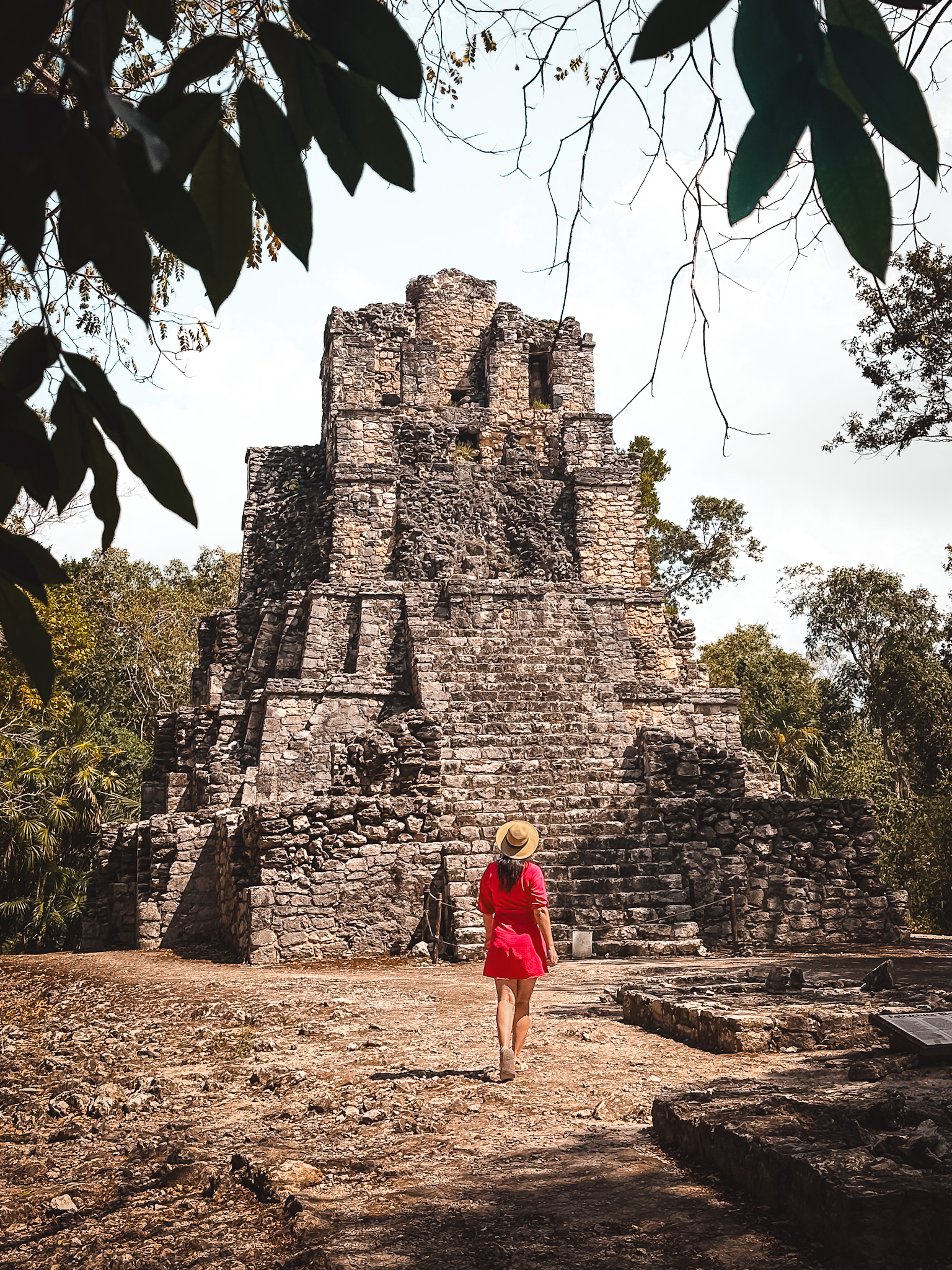20 most popular day trips from Tulum, Mexico
This post may contain affiliate links. If you use these links to buy something I may earn a small commission at no extra cost to you! Thank you for your support!
Come along on the best day trips from Tulum, Mexico! We spent four weeks in Tulum exploring everything inside the city and going on countless trips to all the famous bucket list destinations near and far from Tulum.
Tulum is a great place to base yourself in and day trip to various must-see places – fabulous cenotes, Mayan archaeological zones like Coba and Chichen Itza, the famous Bacalar Lagoon, the pink lakes of Las Coloradas, and many more.
In this post, you will find destinations for the best day trips from Tulum with descriptions, photos, and locations on the map. Many of these destinations can be combined and you can even visit 3 or 4 of them in a single day! Happy travels!
Read more » 20 most iconic Instagram spots in Tulum, Mexico
1. Coba Archaeological Zone
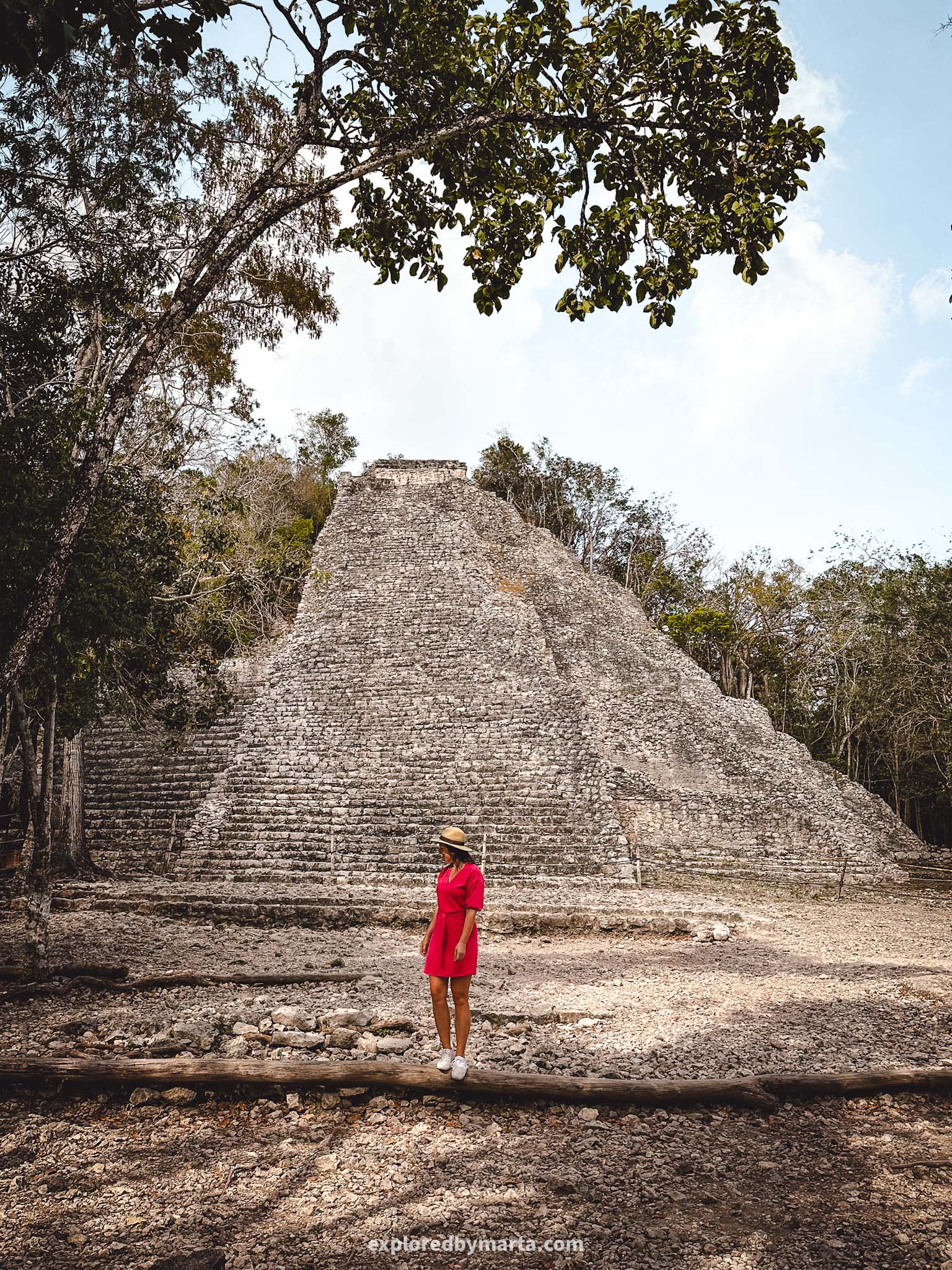
Exploring ancient Mayan cities should be on anyone’s bucket list when visiting this side of Mexico! Coba Archaeological Zone is one of the largest Mayan sites in the Yucatan peninsula and one of the closest ones to Tulum.
The ancient Mayan ruins are located just a 45-minute drive from Tulum making it the perfect place to go for a fantastic day trip to discover an ancient city in the jungle!
Coba ruins were once one of the most important ancient Mayan cities in the area. The archaeological site boasts multiple stone pyramids, temples, and other important structures.


Entrance to the site is paid in different parts – parking and two different entrance fees, so don’t forget to bring some cash with you. All the buildings are pretty much scattered around the jungle so you can rent a bike there (we walked, it was ~5 kilometers).
One of the most impressive buildings is the temple pyramid Nohoch Mul. At 42 meters (137 feet) it is one of the highest Mayan structures in the Yucatán Peninsula. Only Calakmul in the State of Campeche is higher than the Coba pyramid.
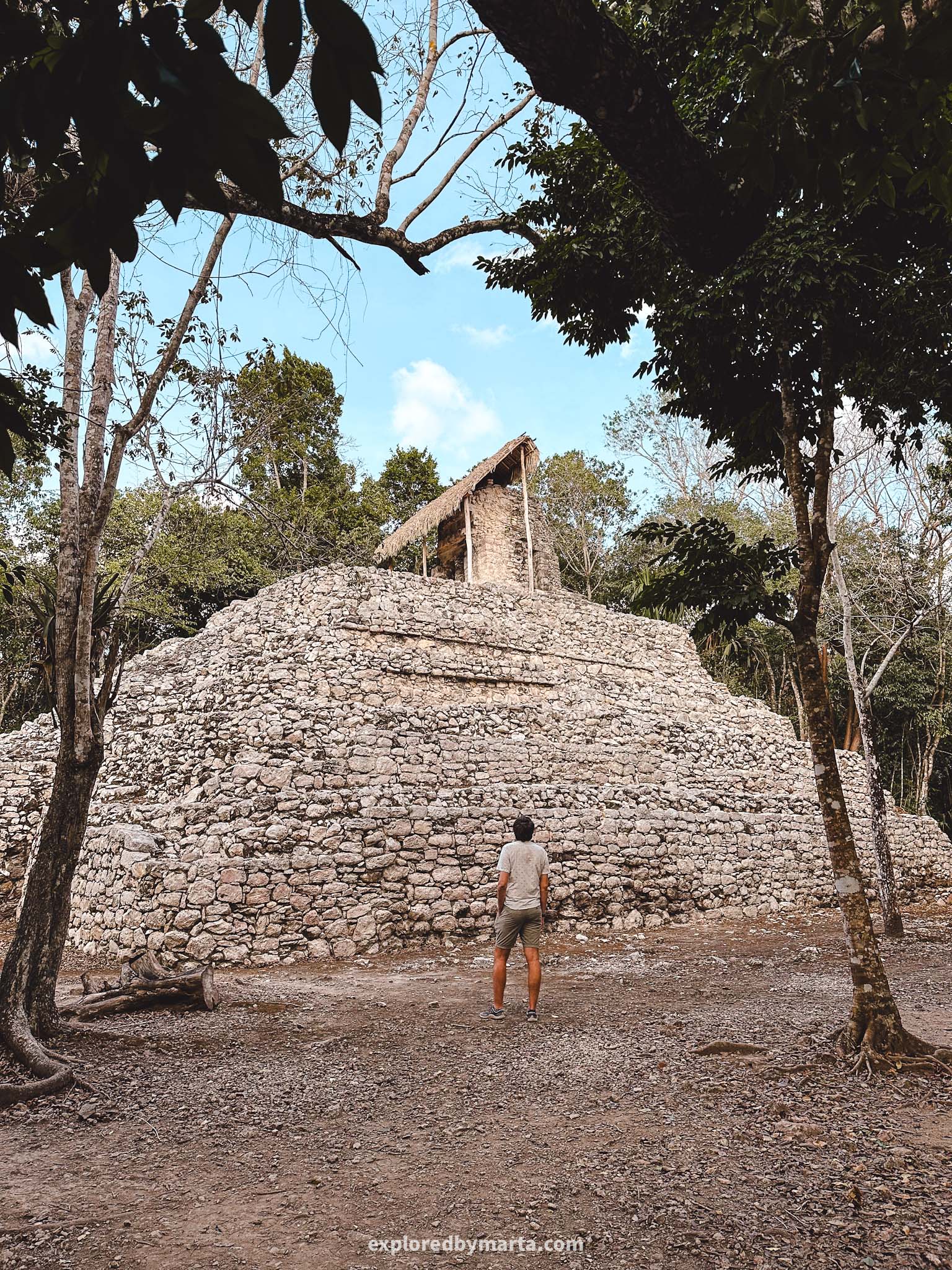
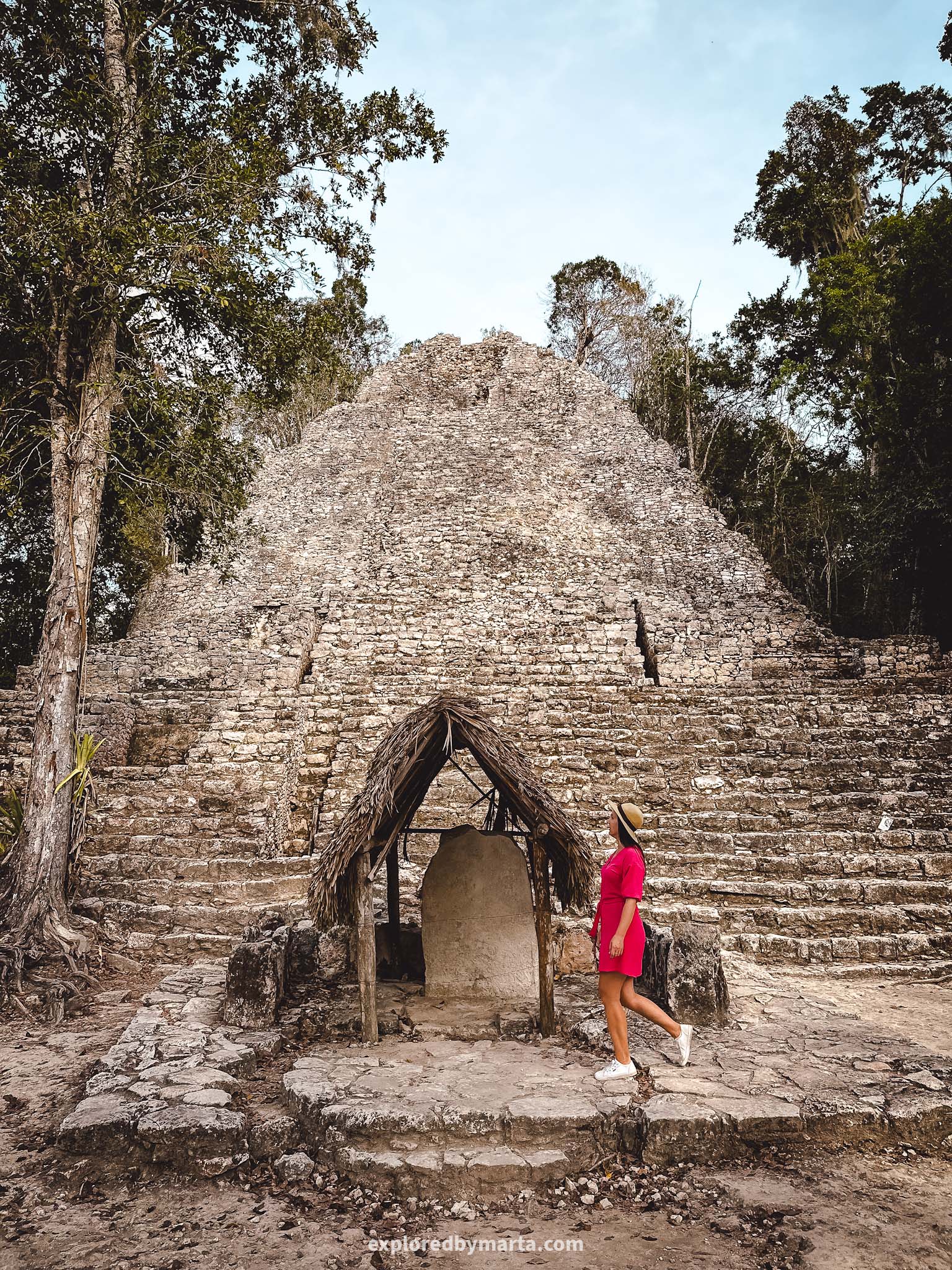
Most of the structures in Coba date back to the 7th-10th centuries. Coba once was a large center of the Mayan civilization, reaching 50 thousand inhabitants, but was already abandoned by the 16th century during the Spanish conquest.
A couple of years ago it was possible to climb the pyramid in Coba, but not anymore. I wasn’t sad about it tho – it was fun walking the narrow paths through the jungle and finding Mayan ruins along the way!
Location: Coba Archaeological Zone – Parking lot
2. AZULIK City of Arts – SFER IK Uh May
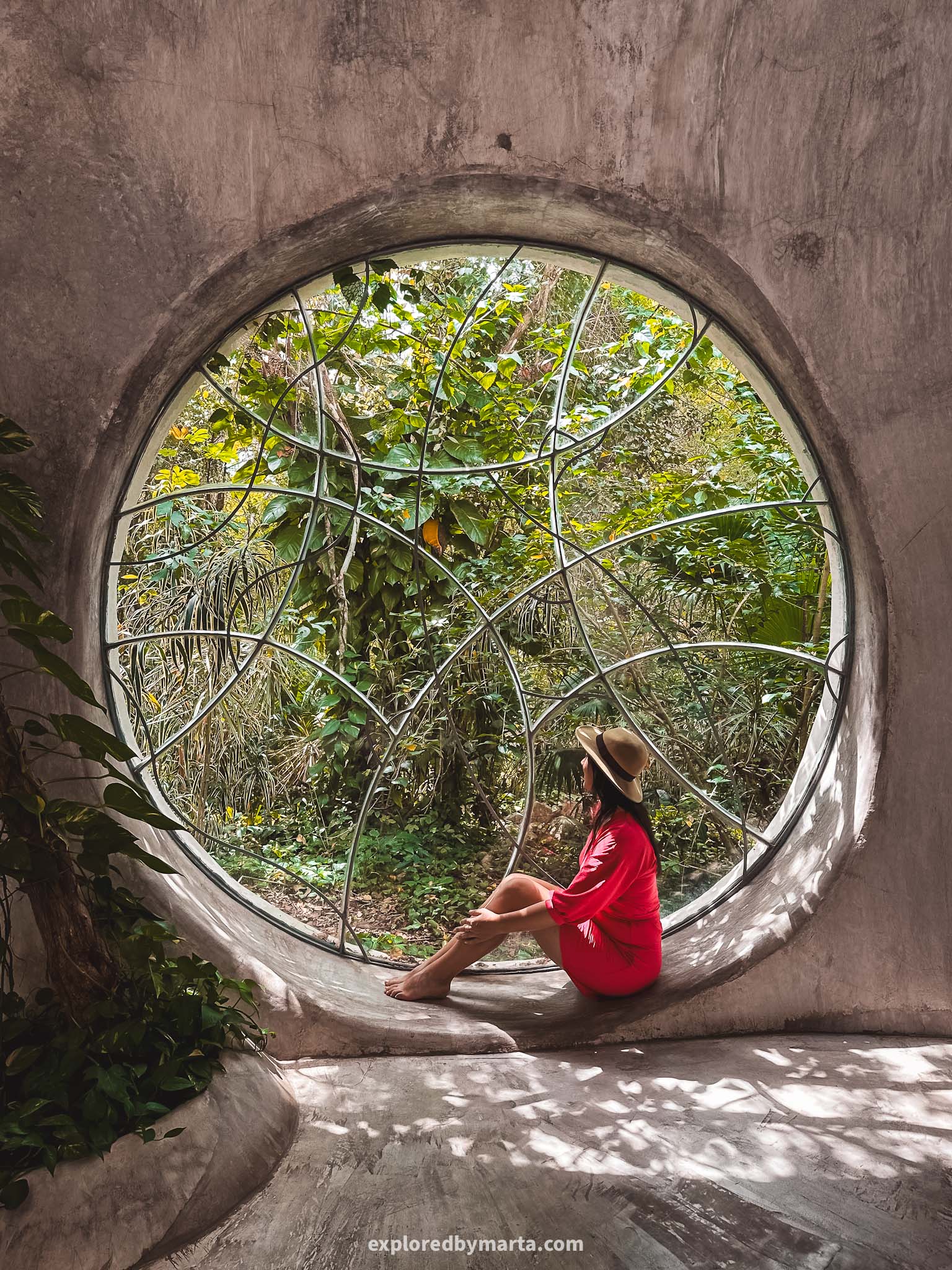
Located in the jungle, a 30-minute drive from Tulum, AZULIK City of Arts is an out-of-this-world handmade artisanal creation that takes you on a journey through never-seen-before spaces. In simpler words, it is a contemporary art museum.
When I first entered this place, my first thoughts were about The Lord of The Rings movie where elves lived in those otherworldly places. It was hard to fathom how they built and how they even came up with all of that!
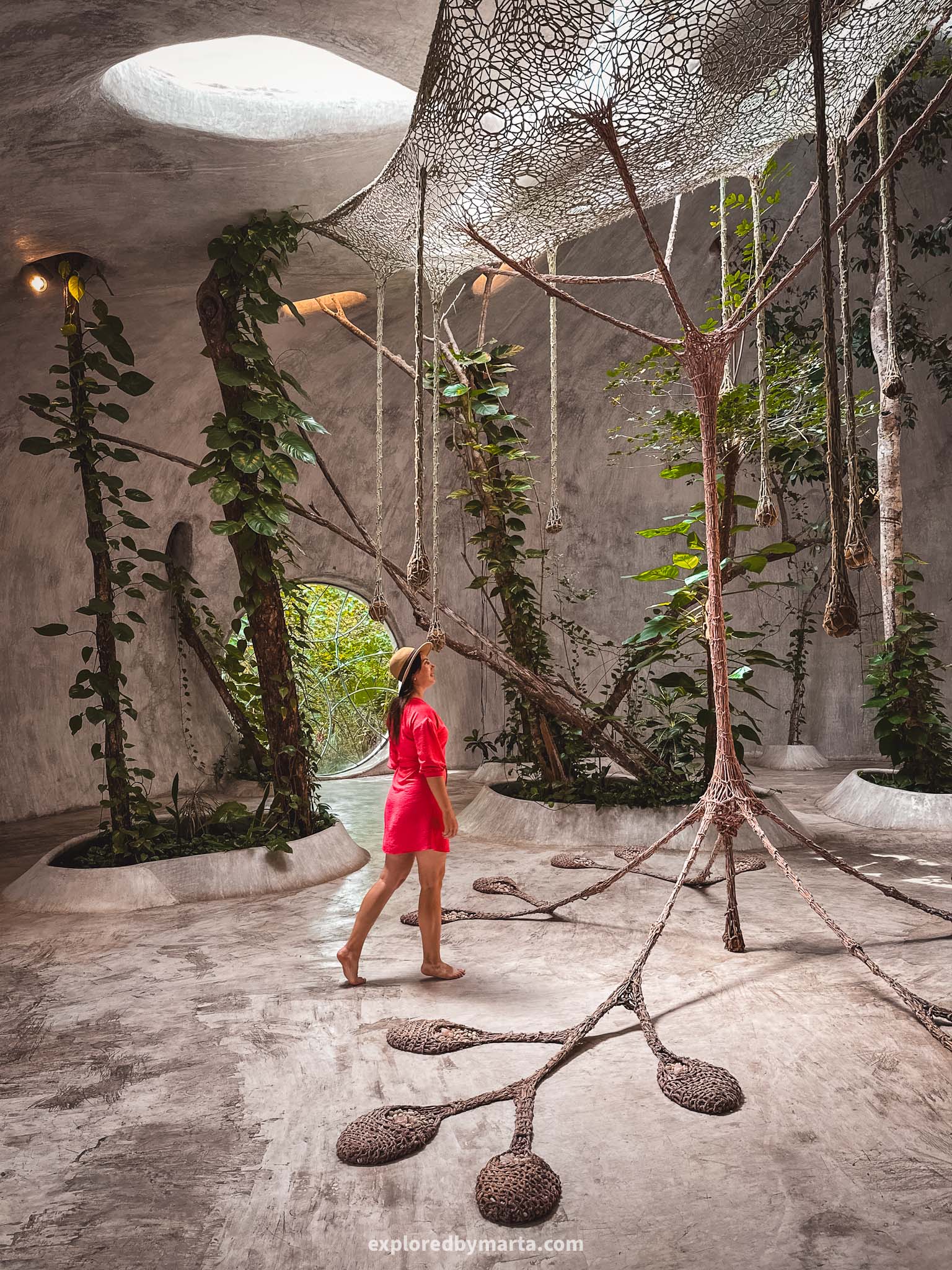

First, they took us by a wooden bridge to the entrance, performed some kind of ritual, and then asked us to take off our shoes. You can only walk around barefoot there. Then they let us enter the building. Only phone cameras are allowed in.
The City of Arts is a massive building all connected in one space – there are wooden pathways built to explore the upper side of the building and then lead you down to the floor. The ground level is connected with other rooms and spaces.
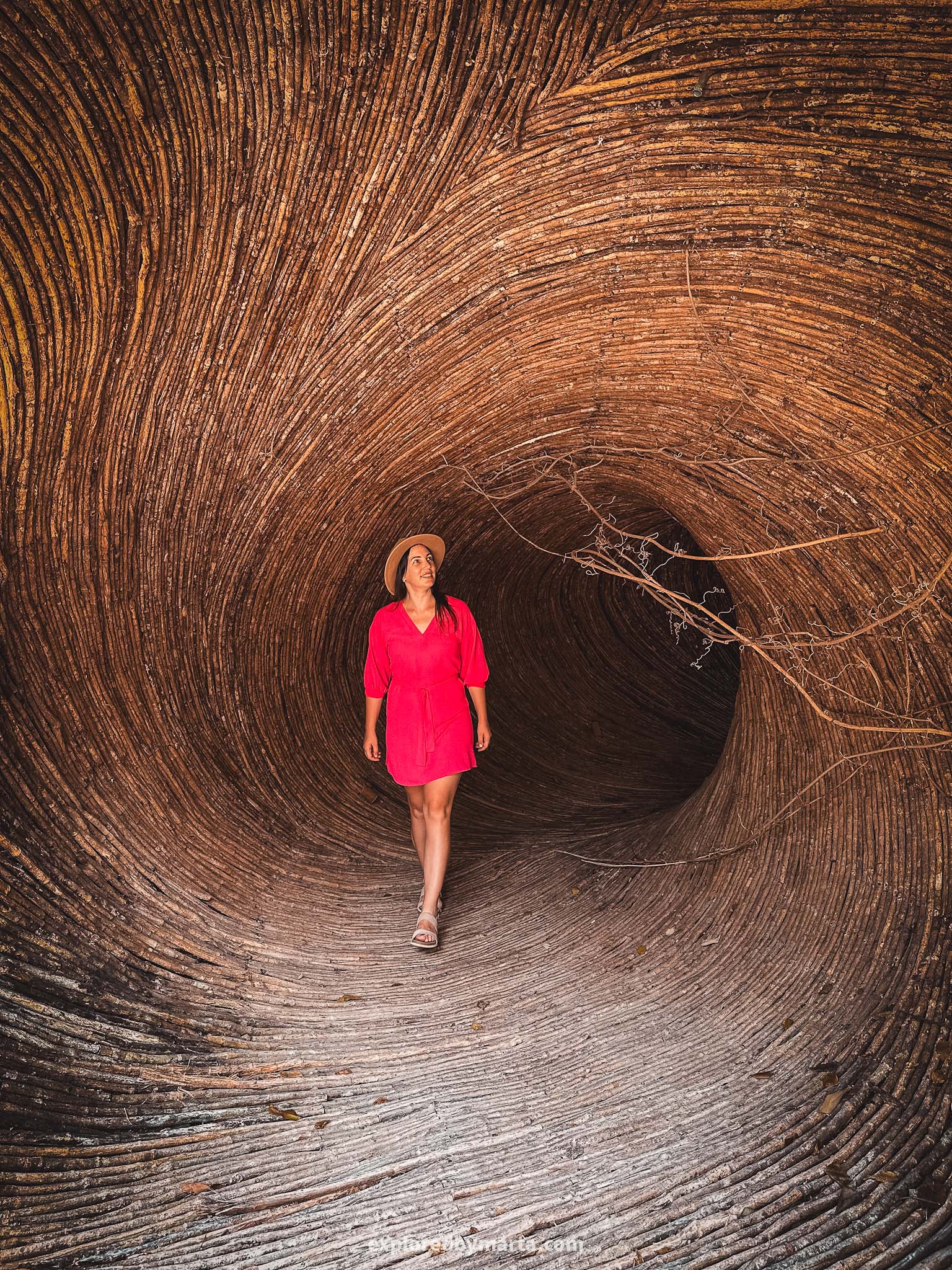
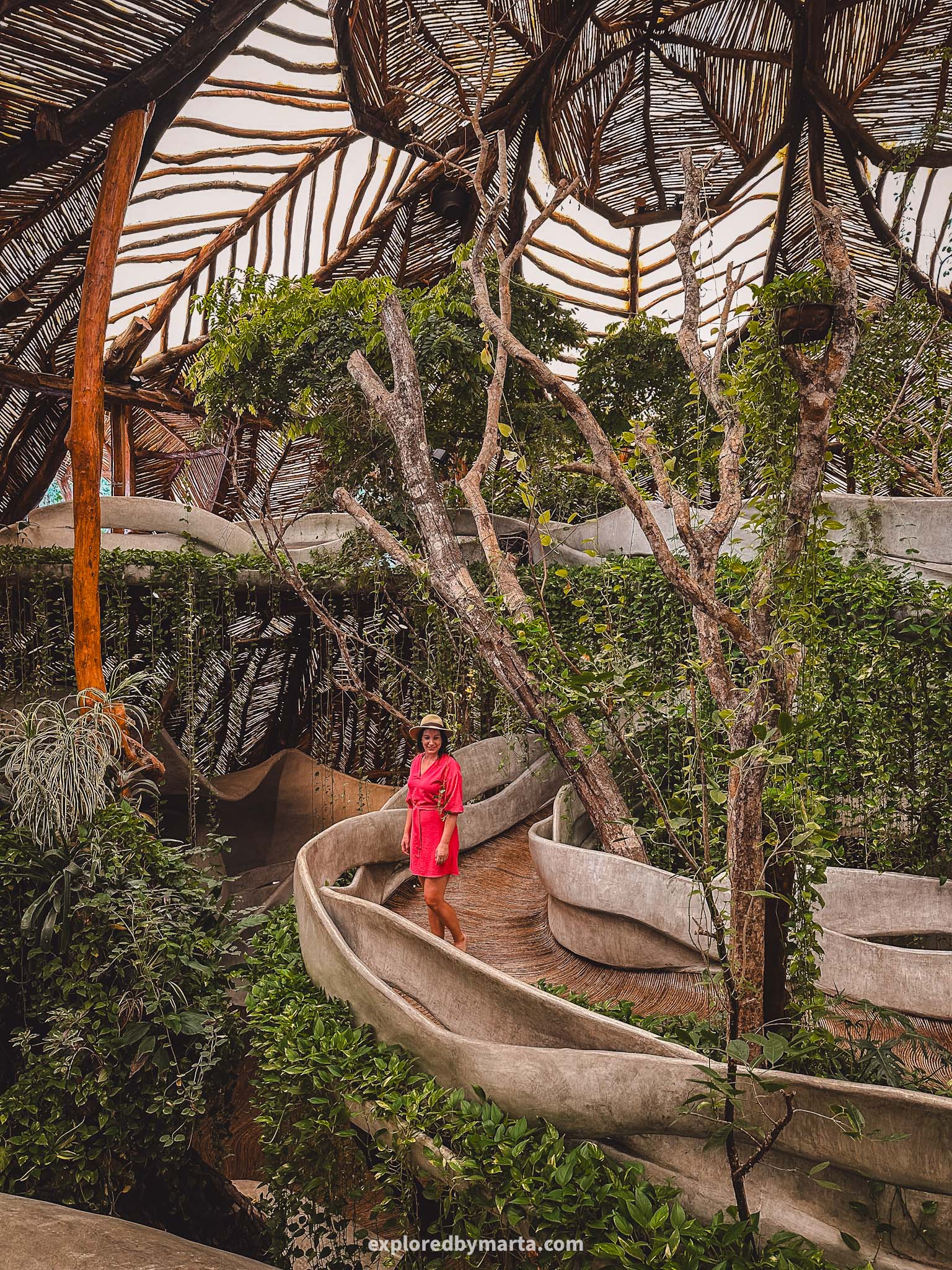
Every room and space features something unique and creative. Once you are done exploring you get your shoes back and can walk outside to explore the surroundings. There is a pool, a restaurant, and more hidden nooks to explore.
Entrance costs 400 pesos per person. If you think you can appreciate such unique beauty, it is well worth a visit. I have traveled to many places and countries but this was something truly magical. I felt like I was on a different planet.
Did you know? There is another museum in the Tulum hotel zone – SFER IK Tulum. From what I gathered from reviews, it is a much smaller place for the same price and thus feels not as price-worthy. Check out more about all SFER IK has to offer here!
Location: AZULIK City of Arts – SFER IK Uh May
3. Bacalar and the Lagoon of Seven Colors


While staying in Tulum we decided to go on a weekend trip to Bacalar and its pride and joy, the Lagoon of Seven Colors! It turned out to be one of my favorite memories from our travels around the Yucatán Peninsula!
If possible, I recommend waking up early to watch the sunrise over the Bacalar lagoon as it sits East of the town. We got a unique smokey sunrise from one of the public piers – Muelle 18.

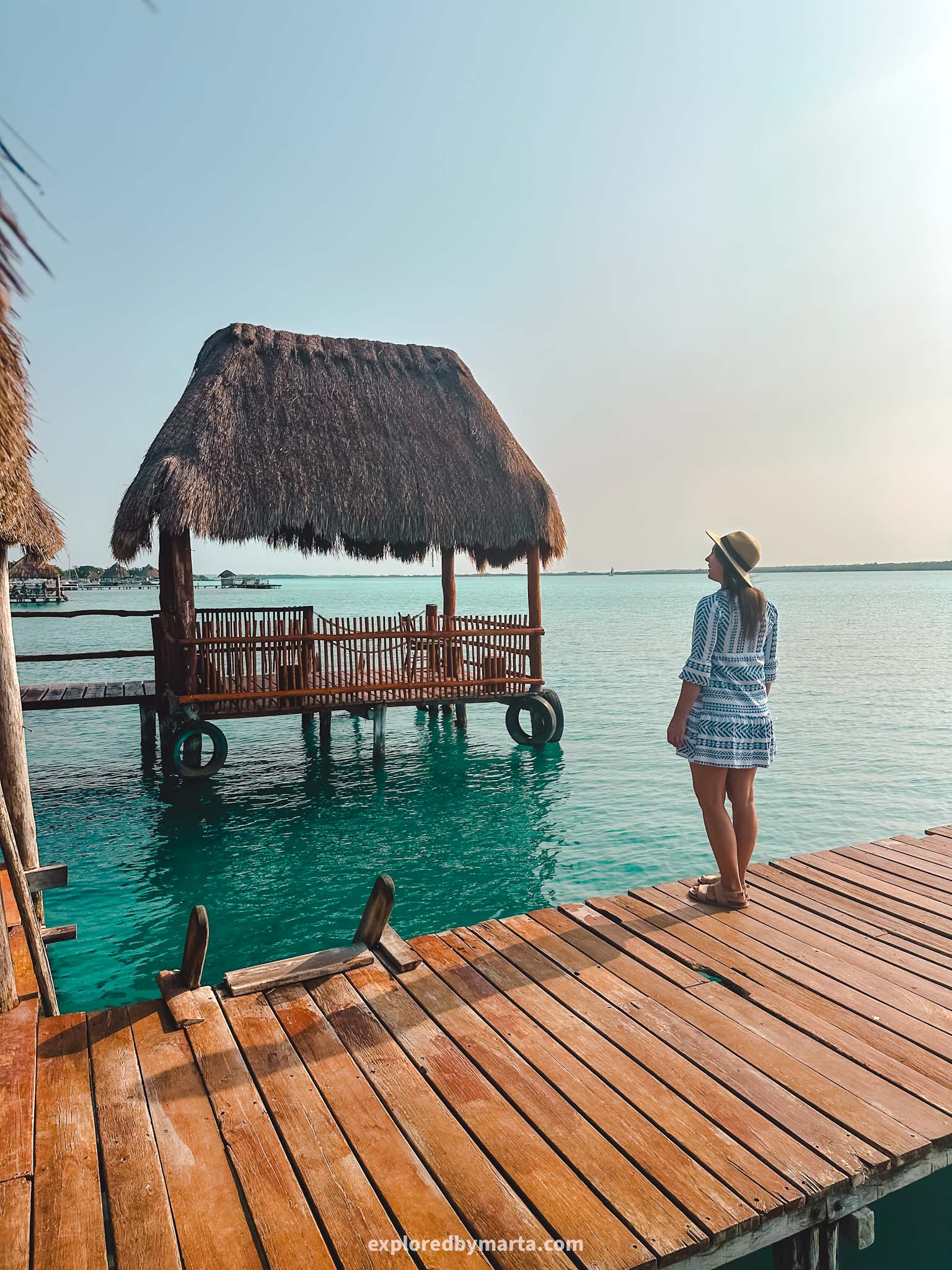
Some of the must-do things to do in Bacalar include a boat trip to the famous Channel of the Pirates, having lunch at a waterfront restaurant (I recommend La Playita), exploring the old fort in downtown, and floating down the stream at Los Rapidos.
Los Rapidos is a narrow channel between two lagoons which creates a slow but steady stream of gorgeous turquoise water in the channel. So you walk upstream by a wooden path, jump in and just let the current take you back to where you came from.
And then simply repeat it all again!
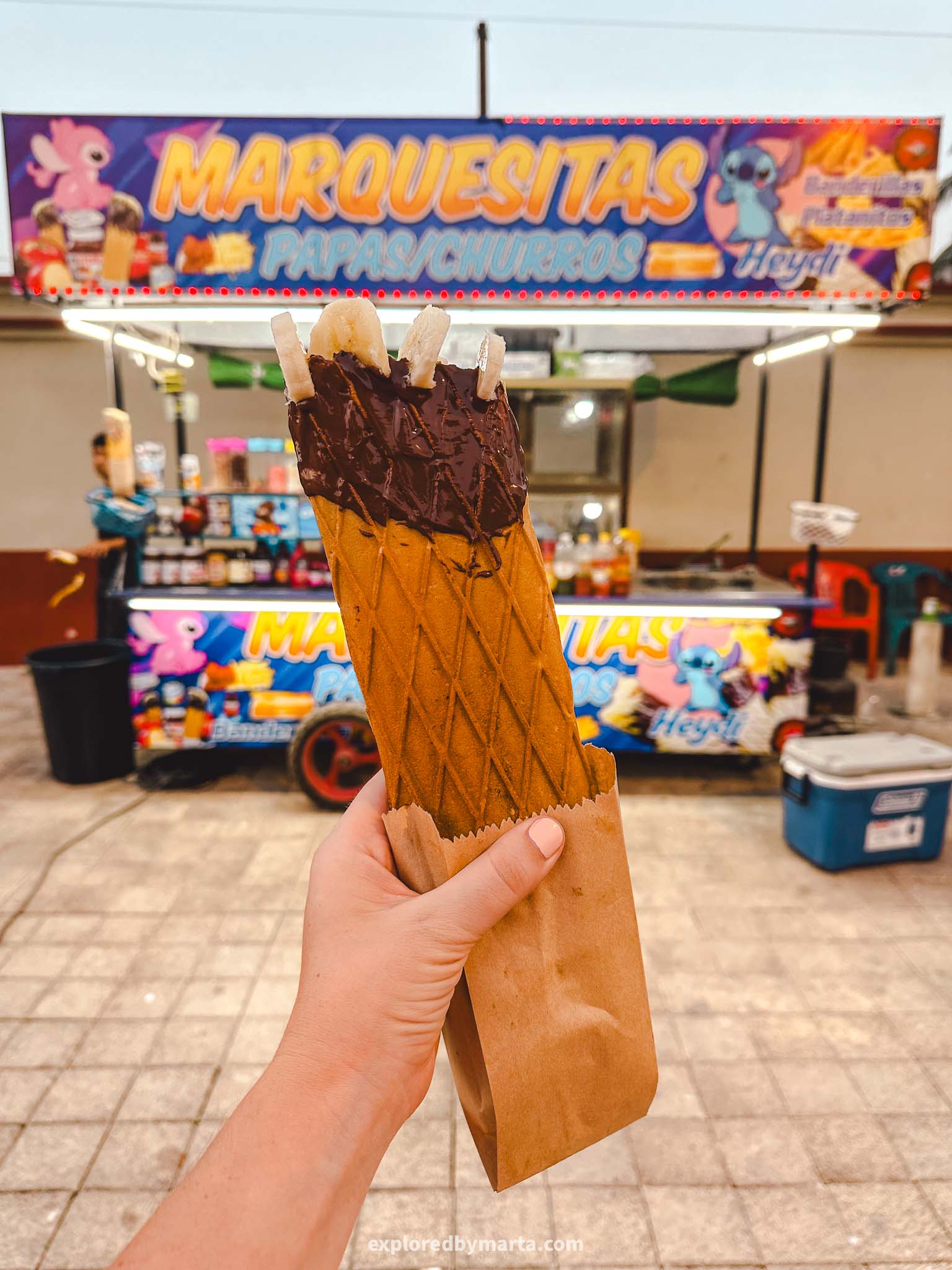
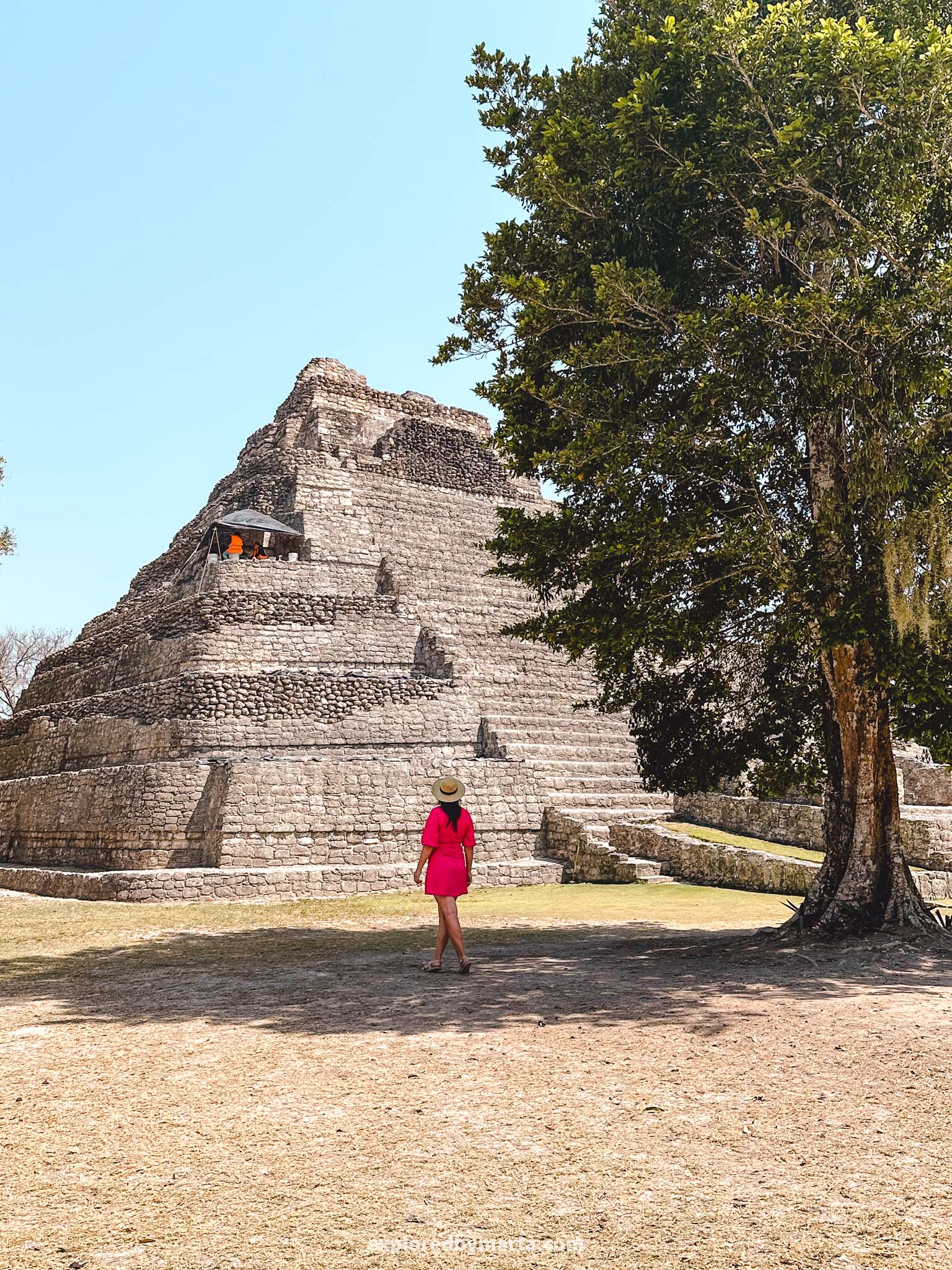
Bacalar is just a short ride away from three incredible Mayan sites – Chacchoben, Dzibanché, and Kohunlich archaeological zones. I liked the three massive pyramids in Chacchoben the most but in Dzibanché you are allowed to climb the pyramids!
After a day full of adventures and swimming, I recommend stopping by the central square of Bacalar – Zócalo. It is often full of activities including some dancing, singing, and lots of street food stands. I got the best marquesita I have ever eaten right there!
Location: Lagoon of Seven Colors in Bacalar
4. Famous cenotes near Tulum


Cenotes are unique water-filled natural sinkholes in the ground and are amongst the must-see places for every traveler visiting Tulum and the Yucatan peninsula. There are a couple of amazing cenotes near Tulum that are worth visiting.
Located just a 15-minute drive from downtown, Cenote Atik Tulum is my favorite cenote near Tulum. It is a gorgeous cenote with turquoise water and a waterfall and features a jungle park filled with hidden sculptures, art objects, and photo spots.


Another one of my favorites was Cenote Taak Bi Ha a 30-minute drive North of Tulum. It is an underground cenote boasting turquoise crystal clear water as well as large rock formations – stalactites and stalagmites. A popular spot for scuba diving!
You can jump into the water from a stone platform built above the water. It is a bit more remote cenote and we even got some time inside for ourselves while we were there alone for a moment in between some small group snorkeling tours.


Then there is Gran Cenote – one of the most popular cenotes in the Yucatan Peninsula and one of the most popular cenotes near Tulum located just a 10-minute drive from the center of Tulum. The most special thing there is that you can swim with turtles!
Another favorite is Cenote Calavera (Skull Cenote) just a 5-minute drive from Tulum downtown. It got its fame on social media thanks to its unique looks – a big circular hole in the ground that resembles a skull and photo-perfect stairs and a swing.
Location: Cenote Atik Tulum – Cenote Taak Bi Ha – Gran Cenote – Cenote Calavera
5. Muyil Archaeological Zone and Sian Ka’an Biosphere Reserve

Located just a 20-minute drive from Tulum is a wonderful Mayan pyramid and ancient ruins – Muyil Archaeological Zone. Although the ancient Mayan city is not among the biggest sites, it is among the most unique ones!
Firstly, this is one of the longest-inhabited ancient Mayan cities in the area, and some artifacts there date back to the 4th century BC. They lived here possibly up to the arrival of the Spanish conquistadors in the 16th century.


Secondly, Muyil ruins stand out with their unique architecture – it has characteristics of an architectural style typical in the Peten region in modern-day Guatemala which signifies close ties with ancient Mayan cities in the South.
We visited Muyil during our four-week stay in Tulum. There is a parking lot right in front of the entrance to leave your car. At the ticket office, we were offered different deals – entrance to the site, a visit to the Sian Ka’an lagoon, or even a boat trip.


We opted for a visit to the archaeological zone and a visit to the lagoon. There is a wooden boardwalk through the jungle to the lagoon to see the gorgeous water and a massive observation tower in the jungle. The views were incredible!
It is believed that Muyil was part of a long trade route that connected the ancient Mayan cities in today’s Guatemala, Belize, and Mexico.


Mayans used a network of water canals to ship goods like jade, chocolate, honey, and salt as well as other goods. Coba was one of Muyil’s main trading partners!
Muyil archaeological zone features a group of different structures and temples and a big pyramid deeper into the jungle. It is a unique-looking pyramid and you won’t see a pyramid like this anywhere else in Yucatan – definitely worth a visit!
Location: Muyil Archaeological Zone
6. Cozumel – the island of the swallows
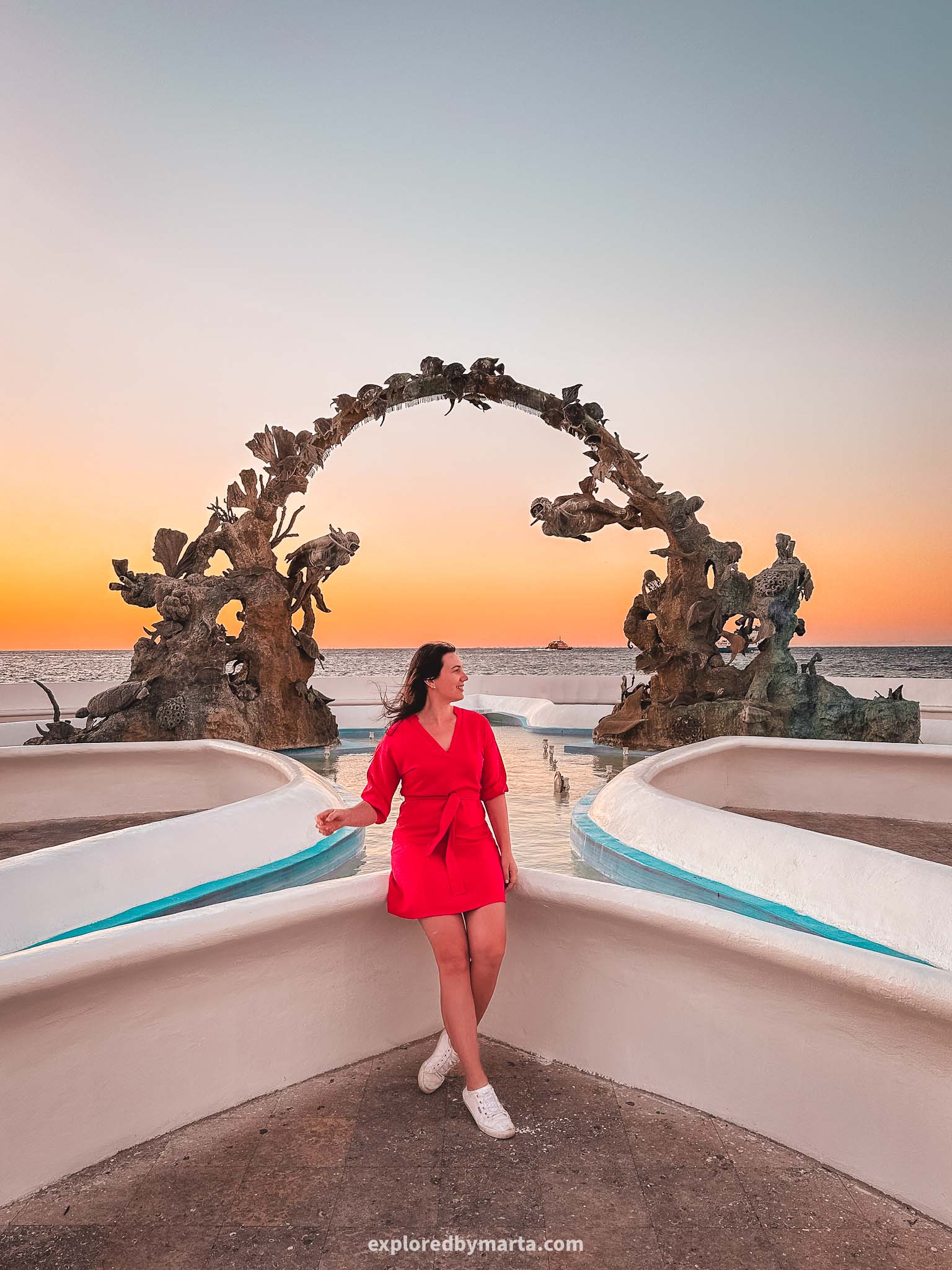

The tropical Caribbean island of Cozumel is Mexico’s third-largest island and known for its tropical white sand beaches, lush palm trees, wild nature, delicious food, and Mayan ruins hidden deep in the jungle.
We actually spent a full week exploring Cozumel and all its famous sights. Some of the top things to do in Cozumel include snorkeling at the Great Mayan Reef, visiting the San Gervasio archaeological zone, and spotting crocodiles in the Punta Sur Eco Park.

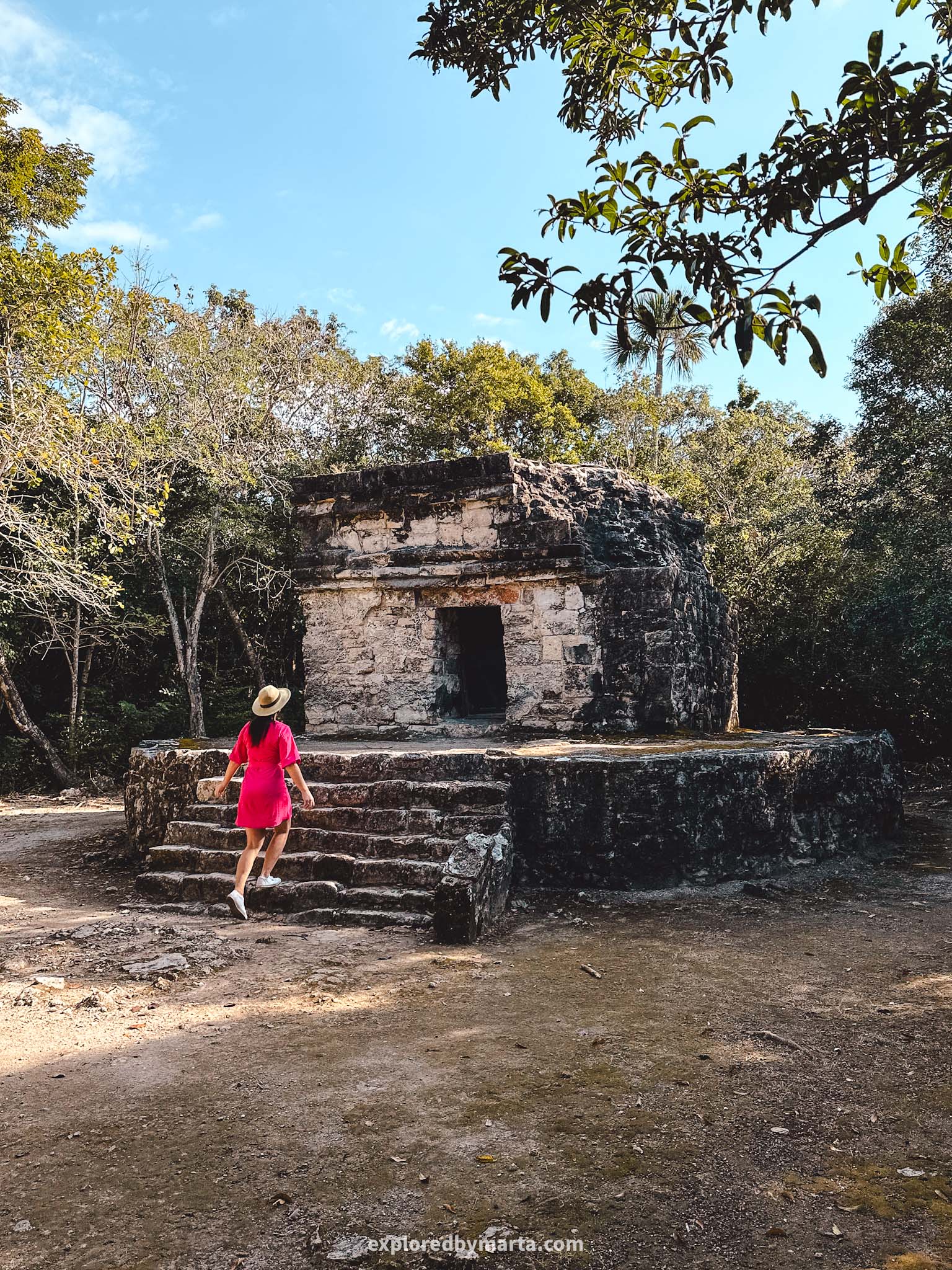
We also spent a lot of time in the capital city – San Miguel de Cozumel, where we ate churros and marquesitas in Benito Juarez Park, stopped by the symbol – Cozumel Clock Tower, and watched the sunset at the promenade.
A walk along the Cozumel promenade is a must – along the way you can visit some iconic spots in the city like Coral Reefs Monument, Monumento Al Mestizaje, and Monumento a la Hispanidad.

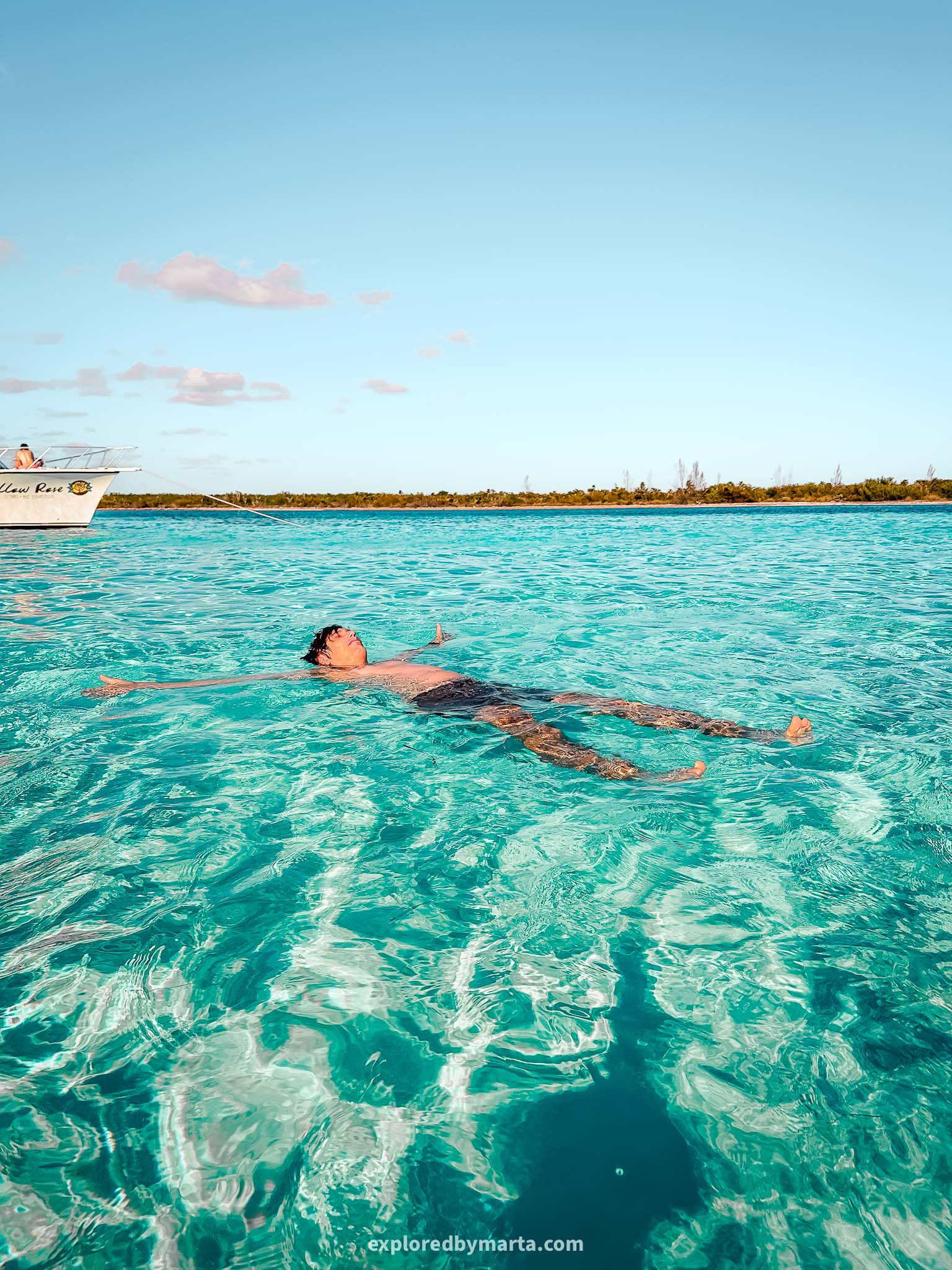
Outside the city, a must-do thing to do is renting a car (or scooter) and driving around the island, stopping by the wild East Coast and at Punta Sur Eco Park. We also did a tour in the Mayan chocolate factory and stopped by the beaches.
Cozumel is a 30-minute ferry ride off the coast of Playa del Carmen. I recommend doing a weekend trip there from Tulum, but also a day will be fun if you visit the Mayan ruins, go snorkeling, eat tacos, and watch the sunset from the promenade.
Location: Cozumel
7. Playa del Carmen
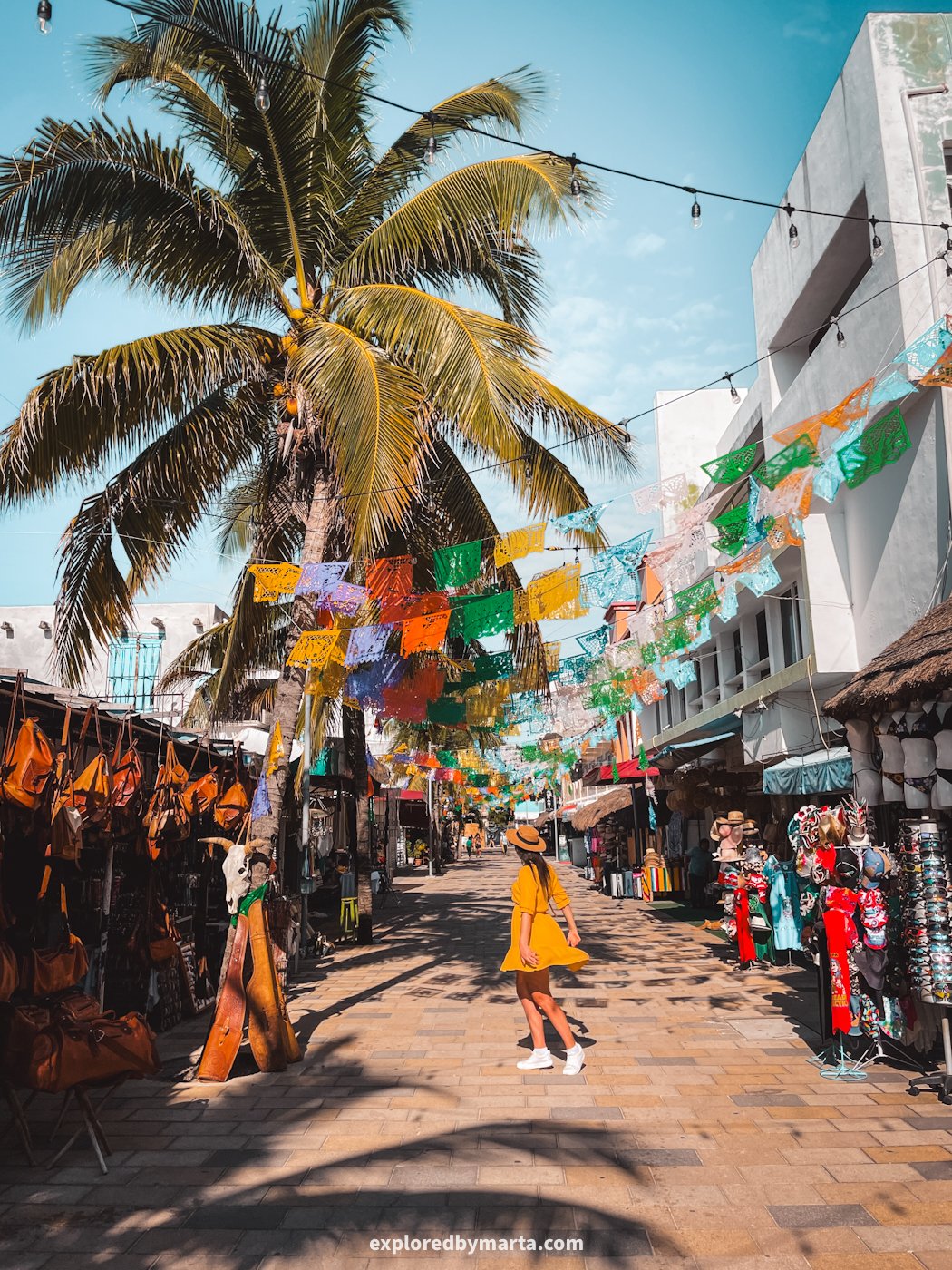

Playa del Carmen is a vibrant seaside town in the Riviera Maya known for its stunning beaches, rich food scene, and lively atmosphere. Situated right between Cancun and Tulum, it has long attracted travelers to its bustling scenes.
Along with Tulum and Cancun, Playa del Carmen is one of the best places to base yourself in the Yucatán Peninsula. For years, it has been a popular destination for digital nomads and expats, blending diverse traditions into this vibrant town.


If you have some free time in your itinerary, consider taking a day trip to this bustling town. What I love most about Playa del Carmen is that everything is within easy reach. Right in the town center, you’ll find all of Playa del Carmen’s main attractions.
So what are the best things to do in Playa del Carmen? First of all, Playa del Carmen is home to one of the most famous streets in the Yucatan Peninsula – the Quinta Avenida, or Fifth Avenue.
The famous street is lined with an array of shops, restaurants, and bars. During the night it is a busy spectacle like no other! You should definitely walk this street, do some shopping, check out cafes, and art installations along the way.


Another must-visit place is the seaside square, Parque Los Fundadores. This popular gathering spot sits right in front of the Caribbean Sea, making it a perfect location for watching the sunrise and hanging out until sunset.
The park also features a massive arched sculpture, the Portal Maya, which stands 50 feet (16 meters) high. You will also find the photo-perfect Playa del Carmen letters right next to the square.
We came here at sunrise and got the sunrays beaming through the holes in the letters and palm trees hanging above! It was a beautiful morning and the first sunrise we ever watched in Mexico!


One of my favorite things to do in Playa del Carmen was exploring the rich food scene. We made sure to hunt down the best tacos, street food, and coffee shops – something that Playa del Carmen has an abundance of!
Other places of interest in Playa del Carmen include the unique 3D Museum of Wonders, Alux – the underground restaurant in a cave, Capilla de Nuestra Señora del Carmen, and the colorful street art murals scattered around the downtown.
If you’re feeling adventurous, I recommend joining a tour to the nearby Río Secreto Nature Reserve. This underground river is a miles-long water system just a short drive from the center of Playa del Carmen, known for its crystal-clear waters and impressive rock formations.
Location: Playa del Carmen
8. Chichén Itzá Archaeological Zone
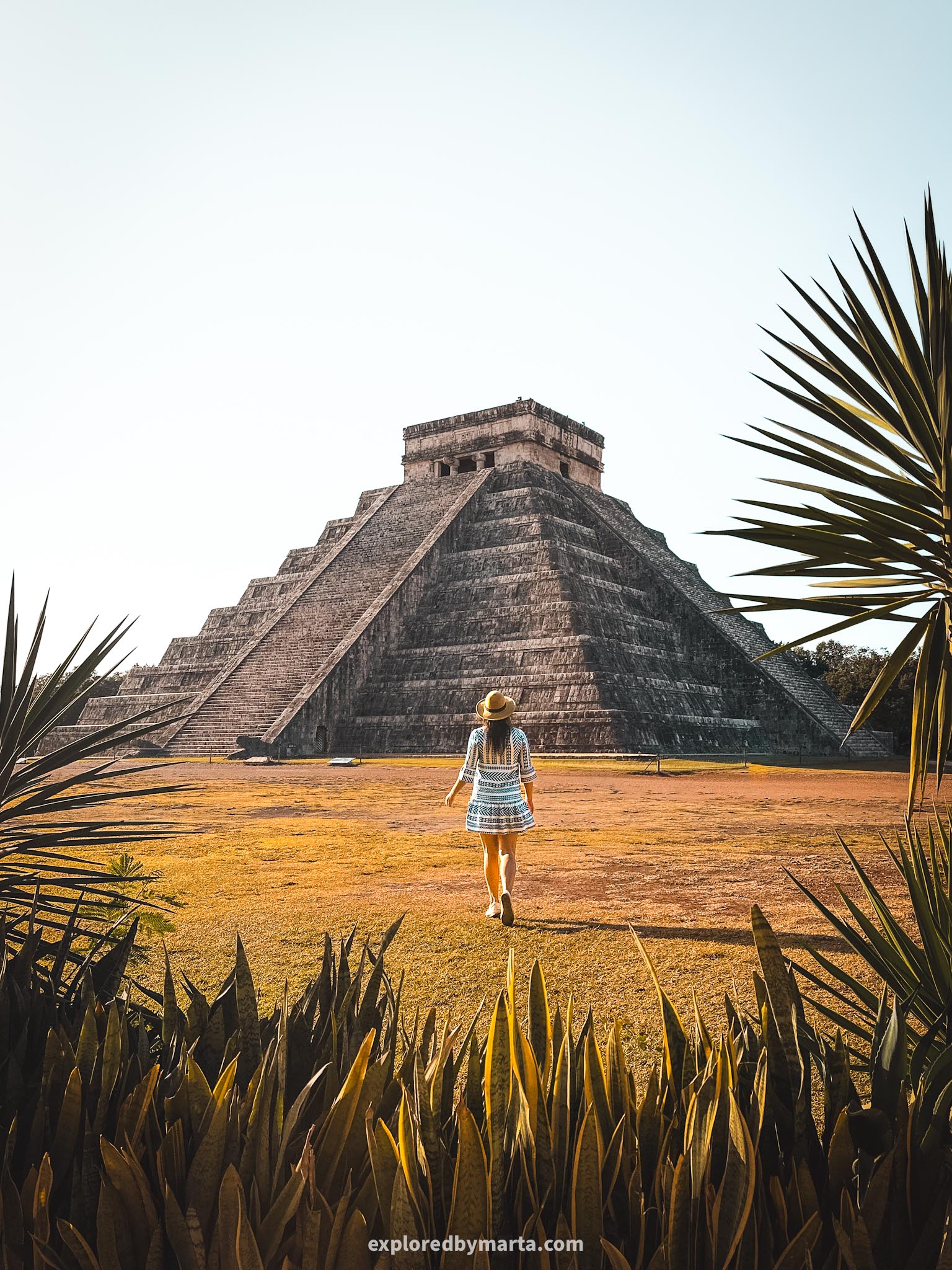
Chichen Itzá is the most famous Mayan site in Yucatán and one of the most visited places in Mexico. A place that must be on your Tulum itinerary! It was declared a UNESCO World Heritage Site and voted among the New Seven Wonders of the World.
Historically it was one of the largest Mayan cities dating back to 600 AD. It existed as a major regional center for many centuries until its decline by the 12th century. It still operated until the Spanish conquistadors arrived in the 16th century.
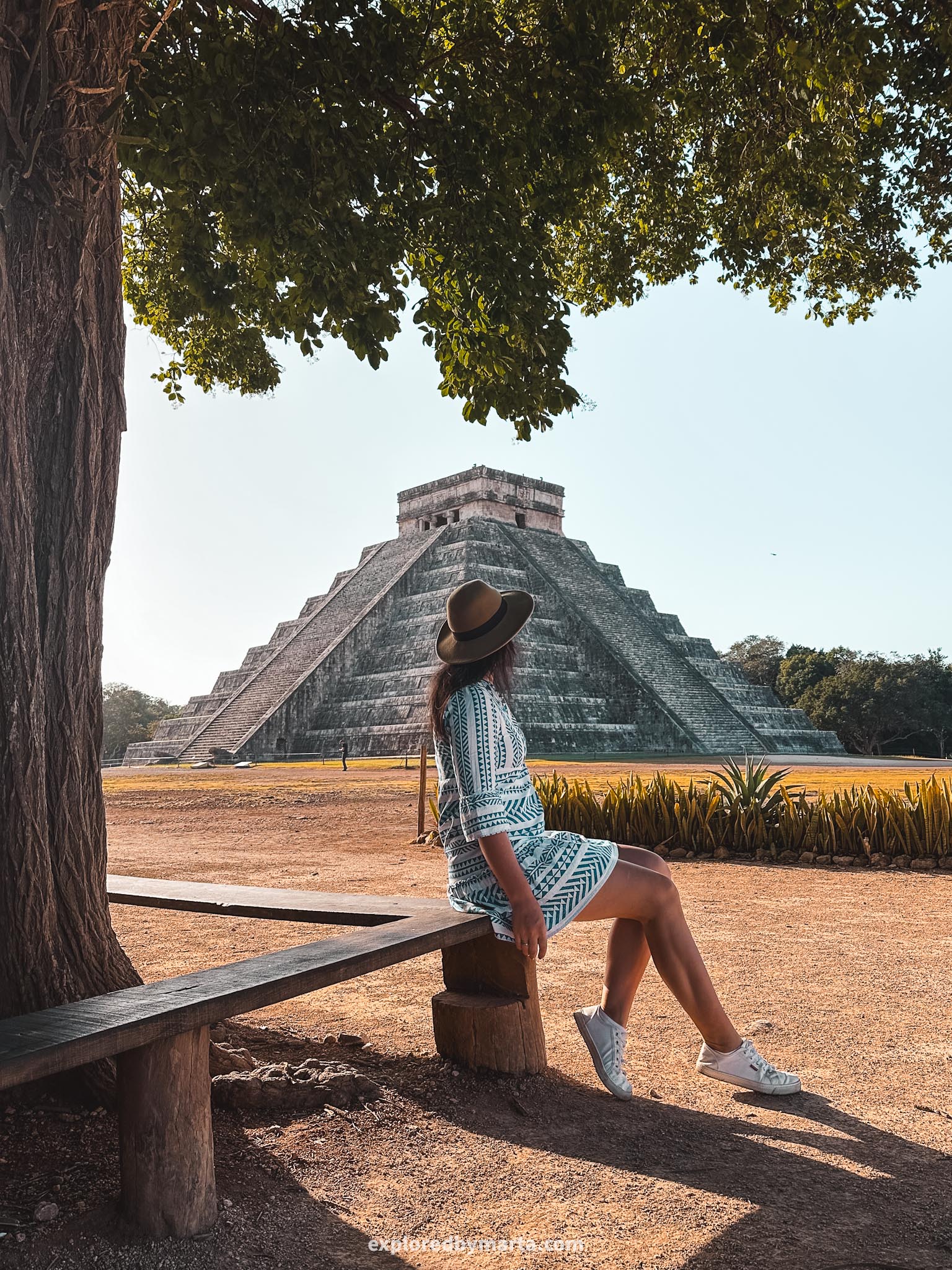
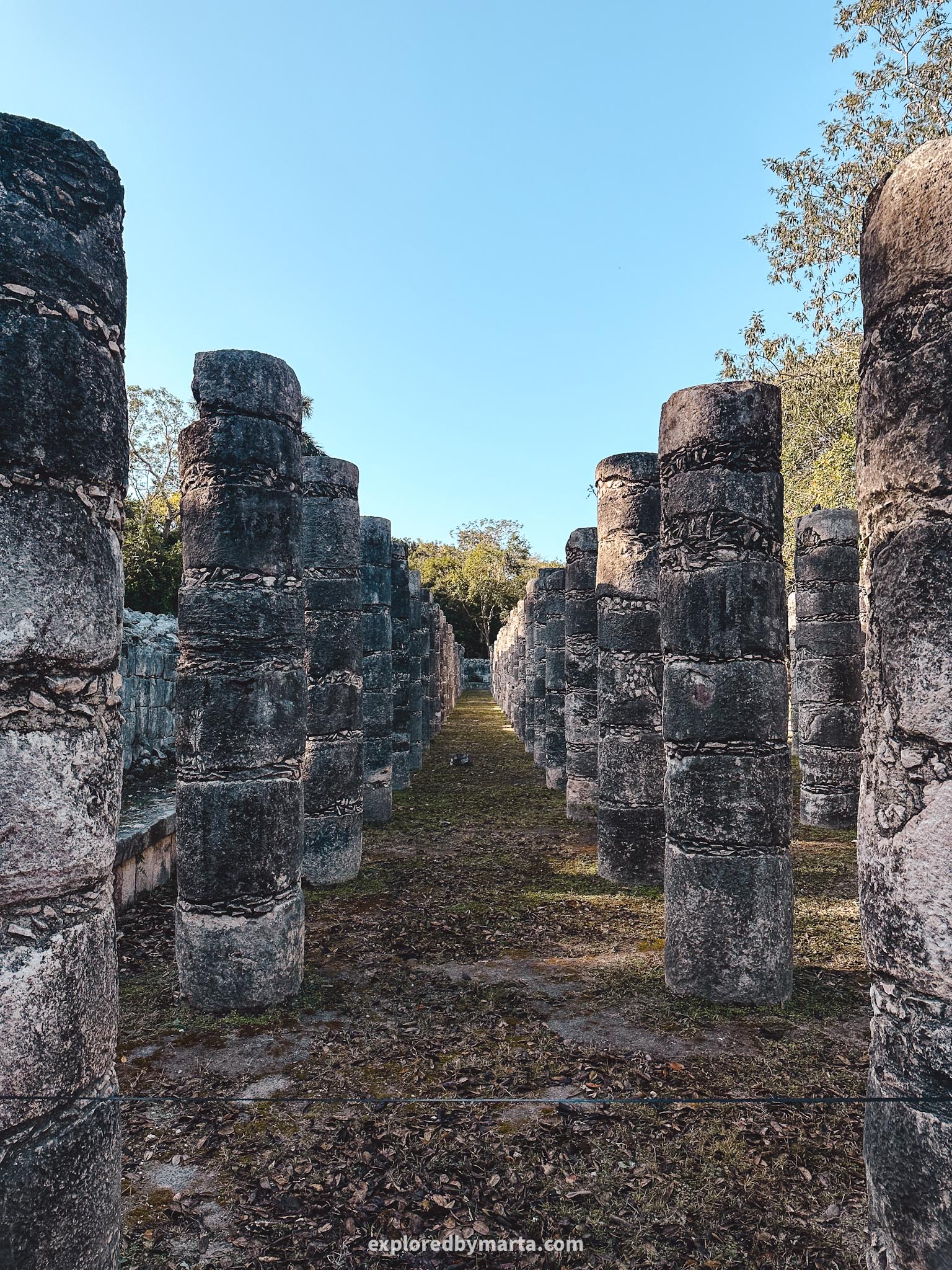
Chichén Itzá archaeological zone consists of multiple temples, pyramids, structures, and even a sacred cenote (cenote sagrado) where Mayans deposited valuables and gifts including human sacrifices as a form of sacrifice to their rain god Chaac.
The most famous structure is, of course, the great pyramid El Castillo (the castle) which is also known as the Temple of Kukulcan. The pyramid with the temple on top of it is 30 meters high and was built sometime between the 8th and 12th centuries.
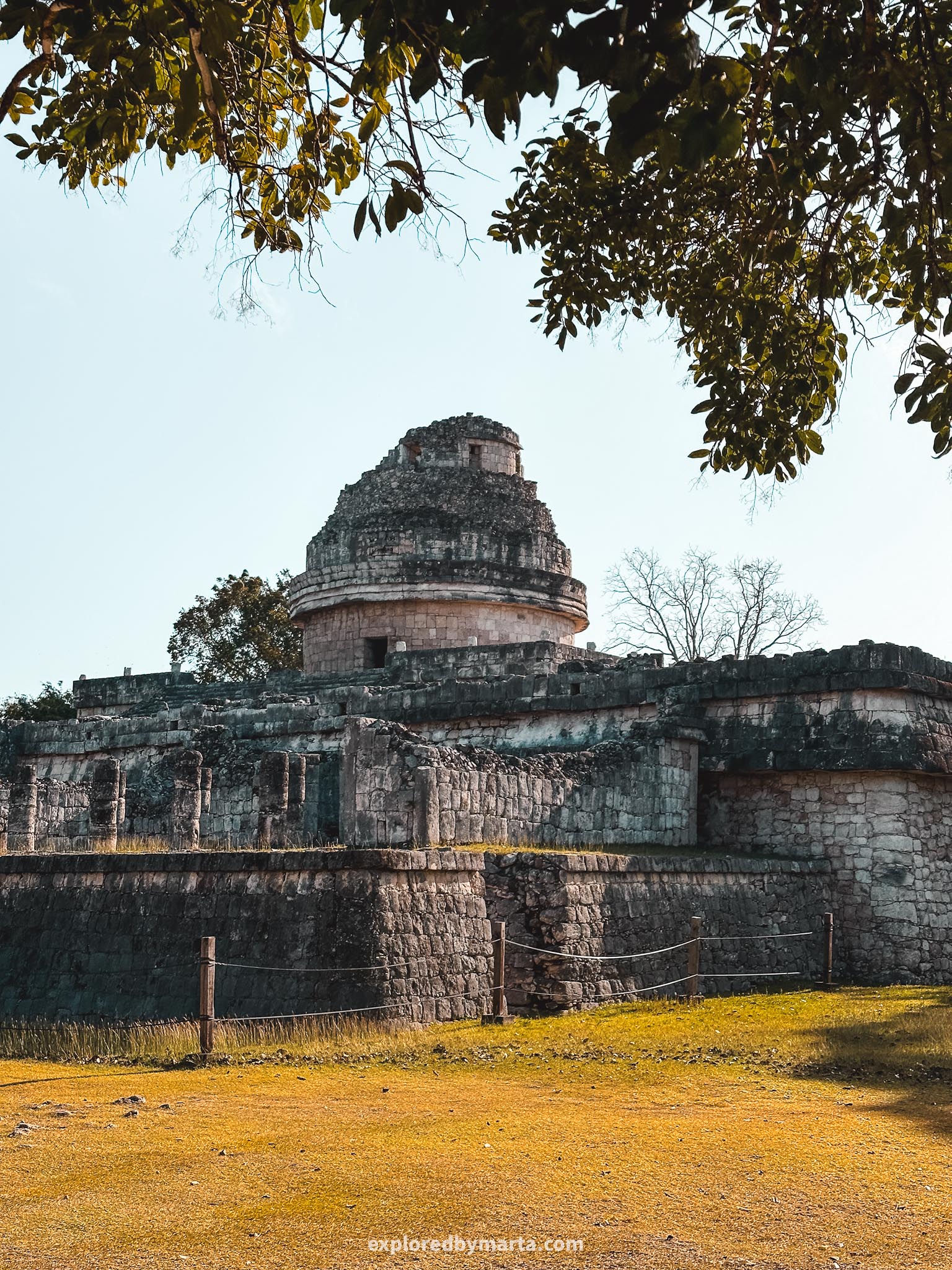
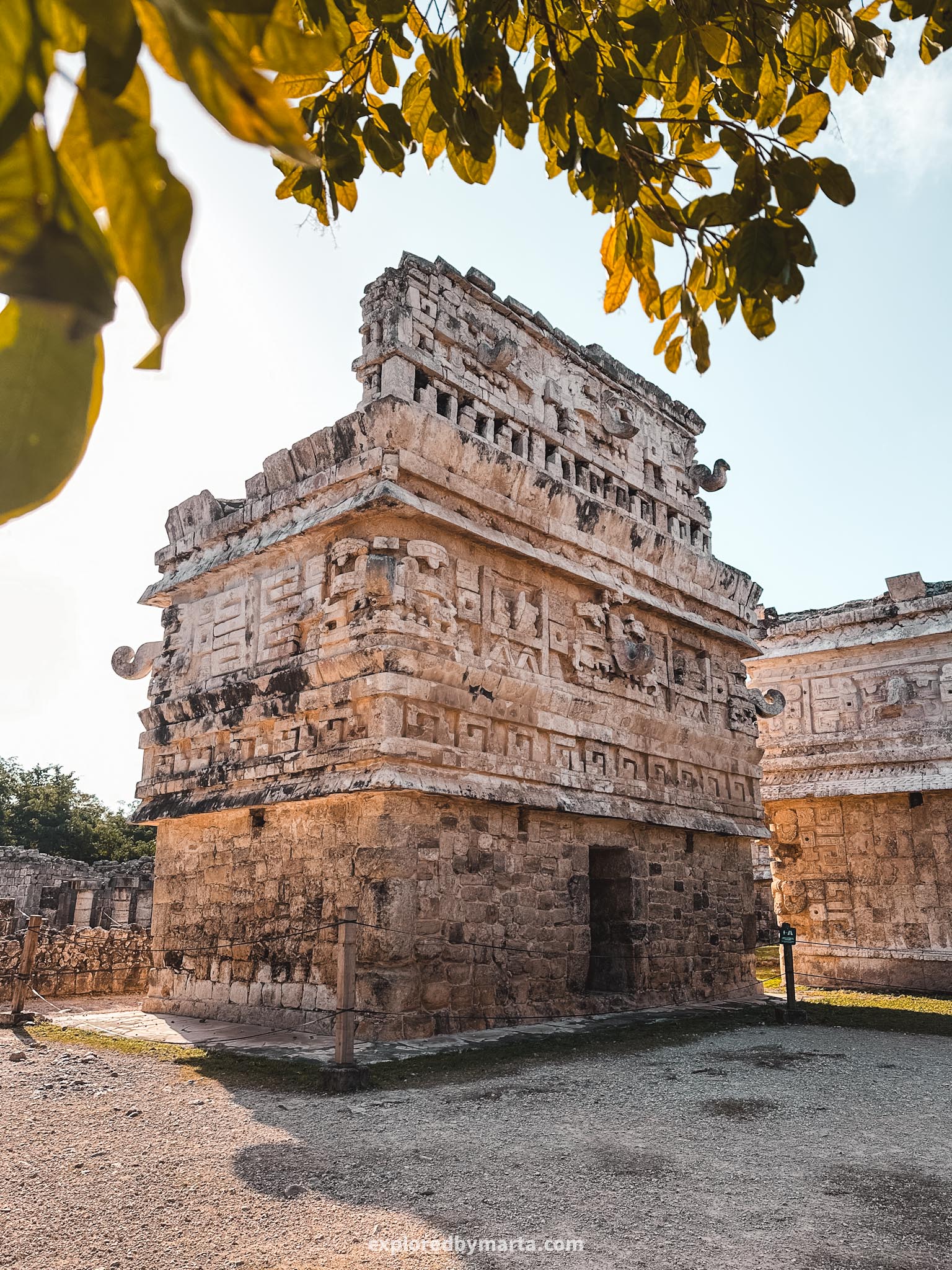
Besides the Chichen Itza pyramid, other structures nearby include the Temple of the Warriors with a group of a thousand columns around it, the Temple of the Great Tables, the Ballcourt, and the Eagles and Jaguars platform.
A little bit further away you will find one of my favorite buildings – El Caracol (the snail) which is a Mayan observatory dating back to the 10th century. Next to it, there is a building complex – Las Monjas – boasting an extravagant Puuc architectural style.
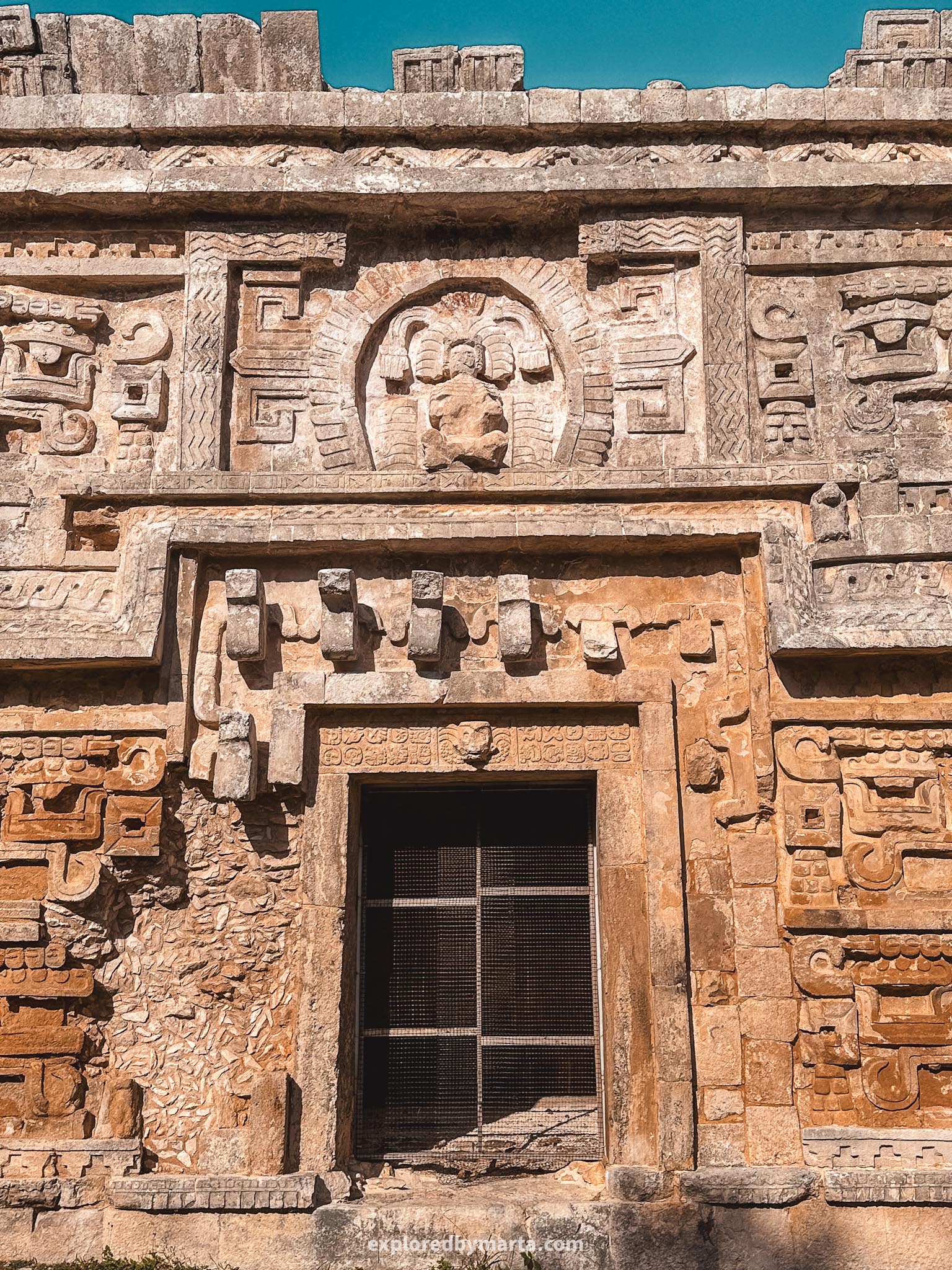
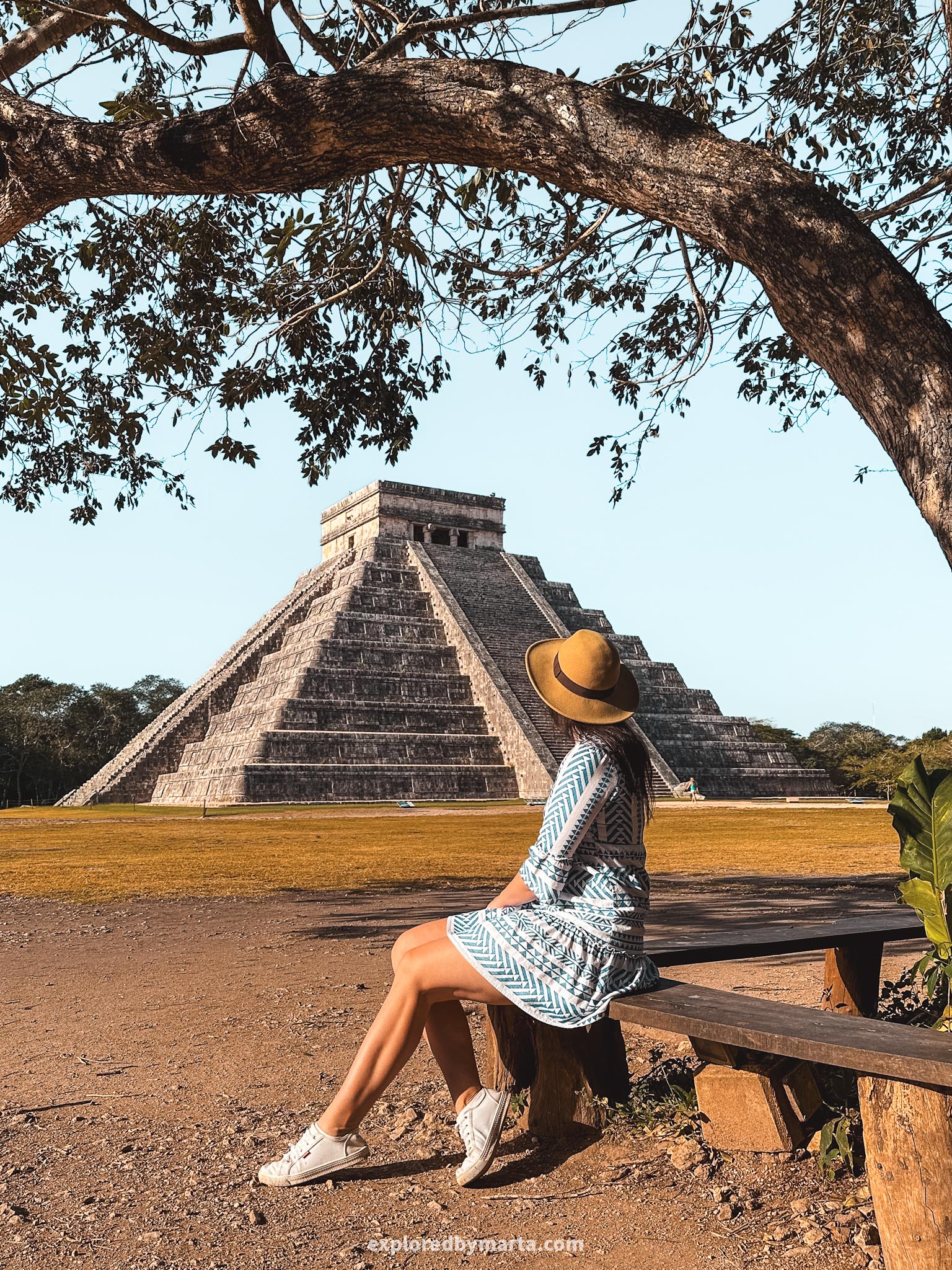
Visiting the Chichen Itza pyramid site is one of the bucket list things to do in the Yucatán Peninsula. Because of that, this place gets super crowded so I recommend arriving first thing in the morning.
The site opens at 8 AM, the parking next to the entrance opens at 7:30 AM. We arrived even before that so that we could be amongst the first ones in. At 8 AM, there was already a long line of people so it is best if you have a car and can arrive early.
For parking, we paid more than 100 pesos (in cash) but for the entrance fee (by card) we paid more than a staggering 620 pesos each. If you want, you can hire a guide on the spot (extra fee) who will tell you the history and take you all around the site.
Location: Chichén Itzá
9. Cenote Ik Kil
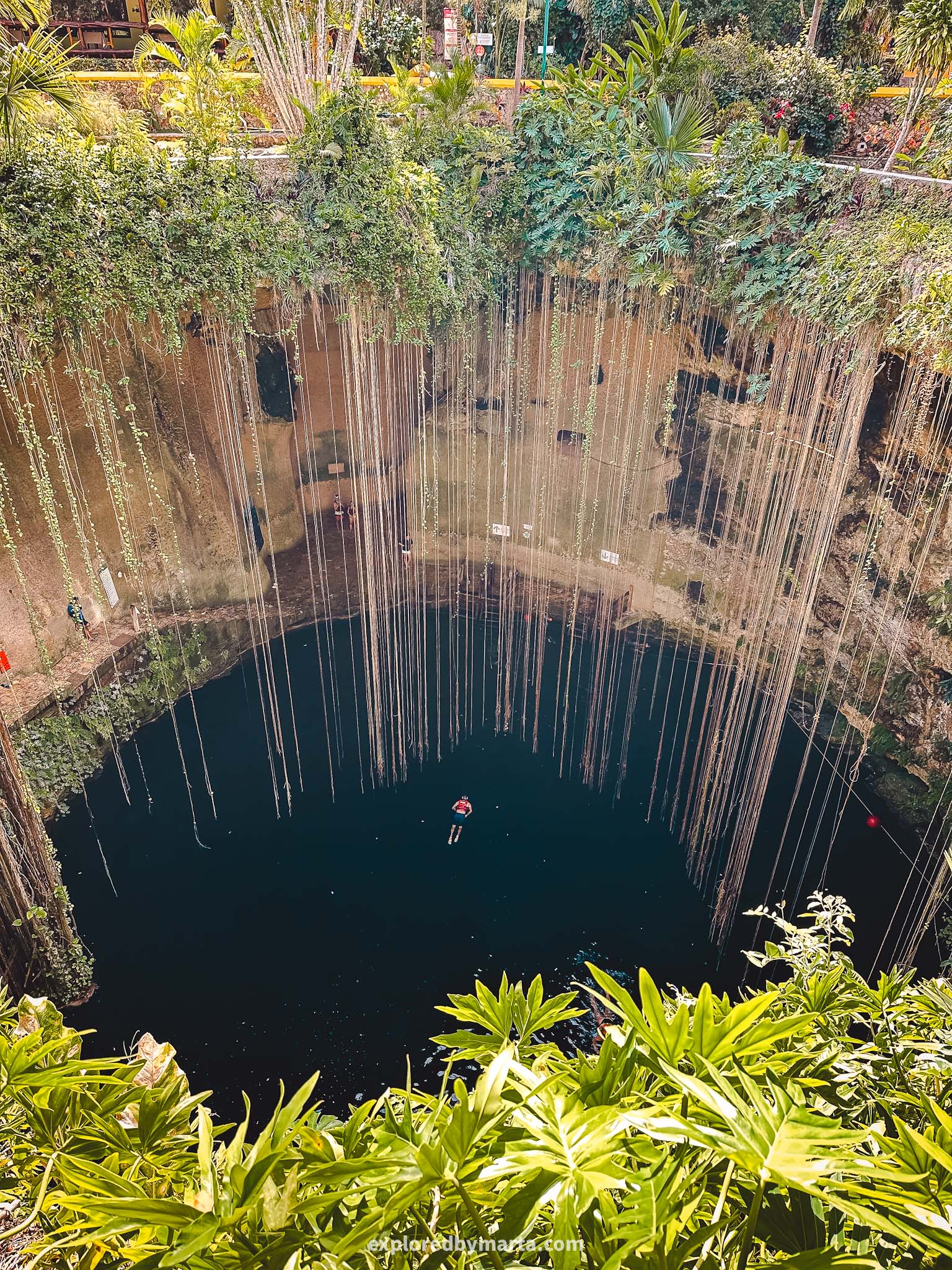
Cenote Ik Kil is another famous destination in the Yucatan Peninsula and a visit here is often combined with visiting Chichen Itza – both sites are located just 5 kilometers (3 miles) apart.
Cenotes are natural sinkholes, and this cylindrical cenote stands out with its circular shape and 26-meter walls covered by hanging plants and tree roots. Cenote Ik Kil is 40 meters deep and served as a place for sacrifices for the ancient Mayans a long time ago.


The cenote is located within the territory of a hotel and a restaurant so you can not only go for a swim here but buy a combined ticket that offers a buffet-type catering. That’s why it is a popular place amongst tour buses. Arrive early to avoid them!
Did you know? Ik Kil from Mayan means ‘place of the winds’.
We visited Ik Kil Cenote on the same day we went to Chichén Itzá. The entrance fee to the cenote was 200 pesos per person. At first, you can observe the cenote from above and then descend 90 steps through a tunnel to the water. It was gorgeous!
Location: Cenote Ik Kil
10. Ek Balam Archaeological Zone
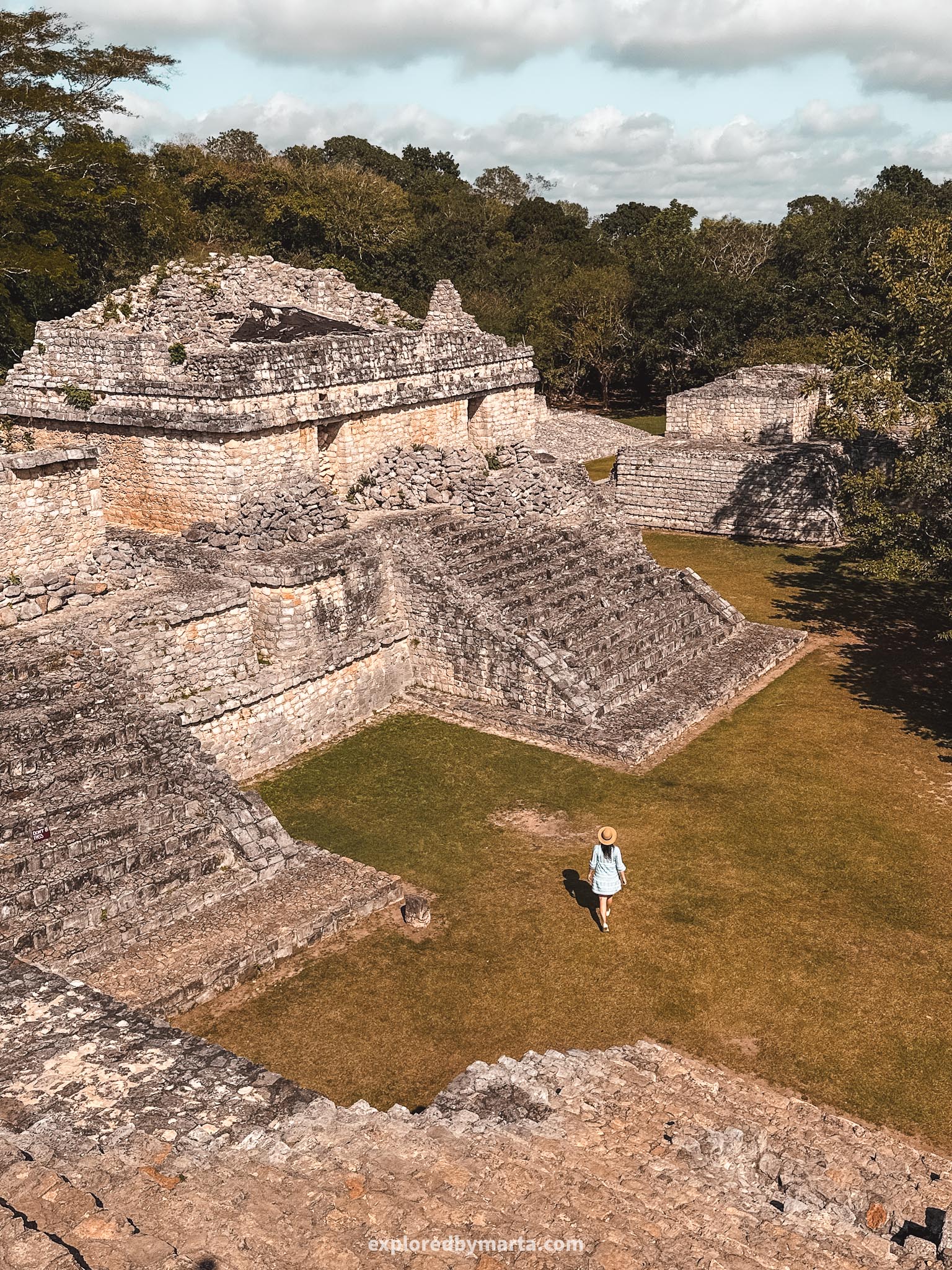
Mayan ruins of Ek Balam is one of the most important sites in Mexico’s Yucatán Peninsula. Let’s start with the best part about it – you can climb the Mayan ruins and pyramids! Not all of them, but enough to enjoy amazing views over the jungle.
Them allowing us to climb the pyramids kind of offsets the massive entrance fee – we paid 550 pesos each plus 100 pesos for parking. Theoretically, you can pay by card (only entrance fees) but because of the bad network, we ended up paying in cash.
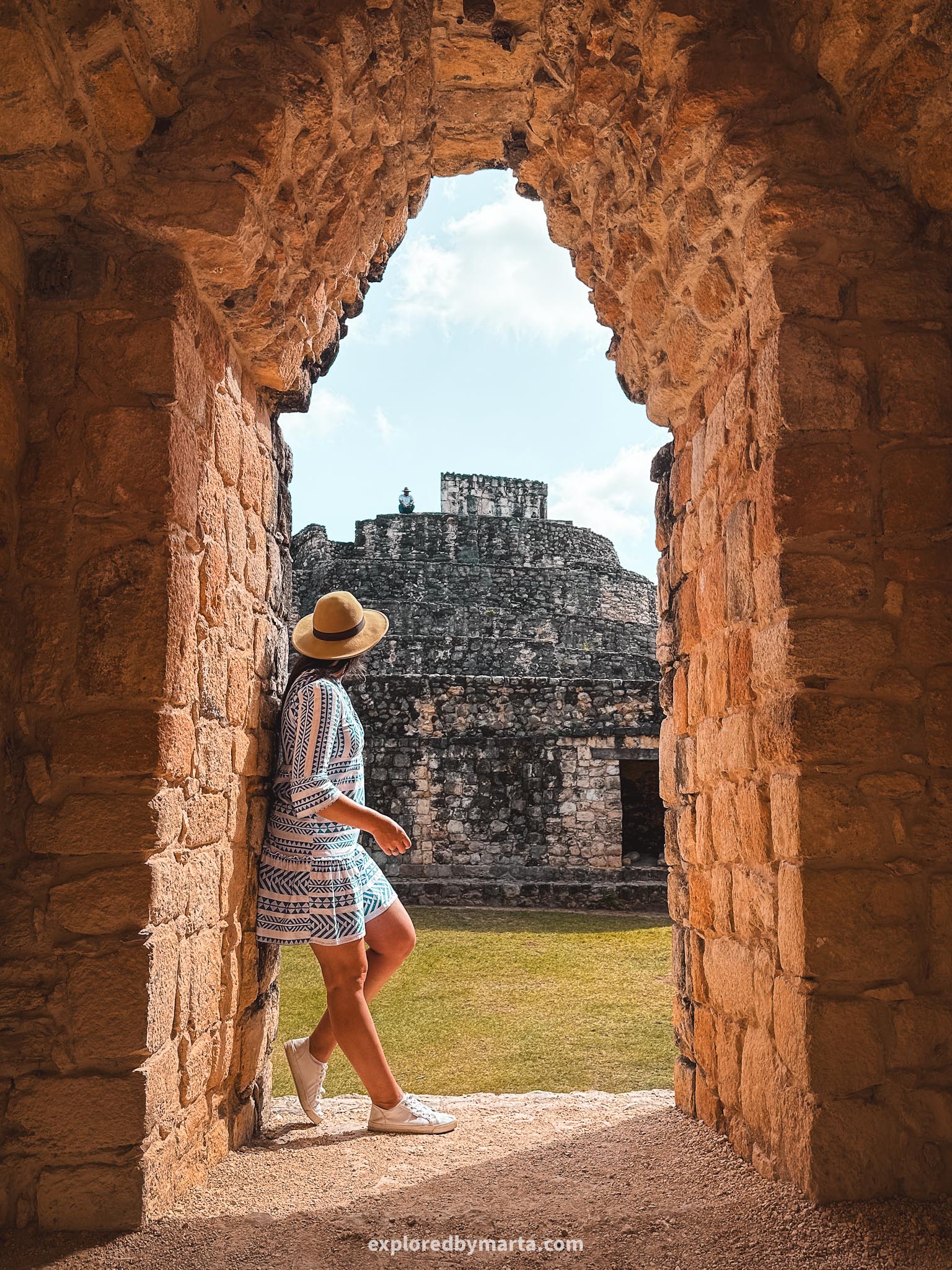

Ek Balam is located less than a 2-hour drive from Tulum making it a convenient destination for Tulum day trips! The name Ek Balam translates as the black jaguar in the Mayan language, so you’ll see many black jaguar souvenirs on the site.
Ek Balam site features multiple impressive buildings and pyramids. The largest structure in Ek Balam is the Acropolis. It is like a temple pyramid with a staircase in the middle where you can climb up to the top to see incredible views over the jungle.


To both sides of the central staircase, you can find entrances to temples decorated with stone carvings and mosaics. They are believed to be burial places for Ek Balam rulers. One of the entrances depicts an open mouth of a jaguar (photo above).
Other notable structures in Ek Balam include the Oval Palace (you can climb it), the Entrance Arch, The Twins, or two lookalike temples, as well as the Ballcourt. Historically, Ek Balam was a booming city during the 8th and 9th centuries.

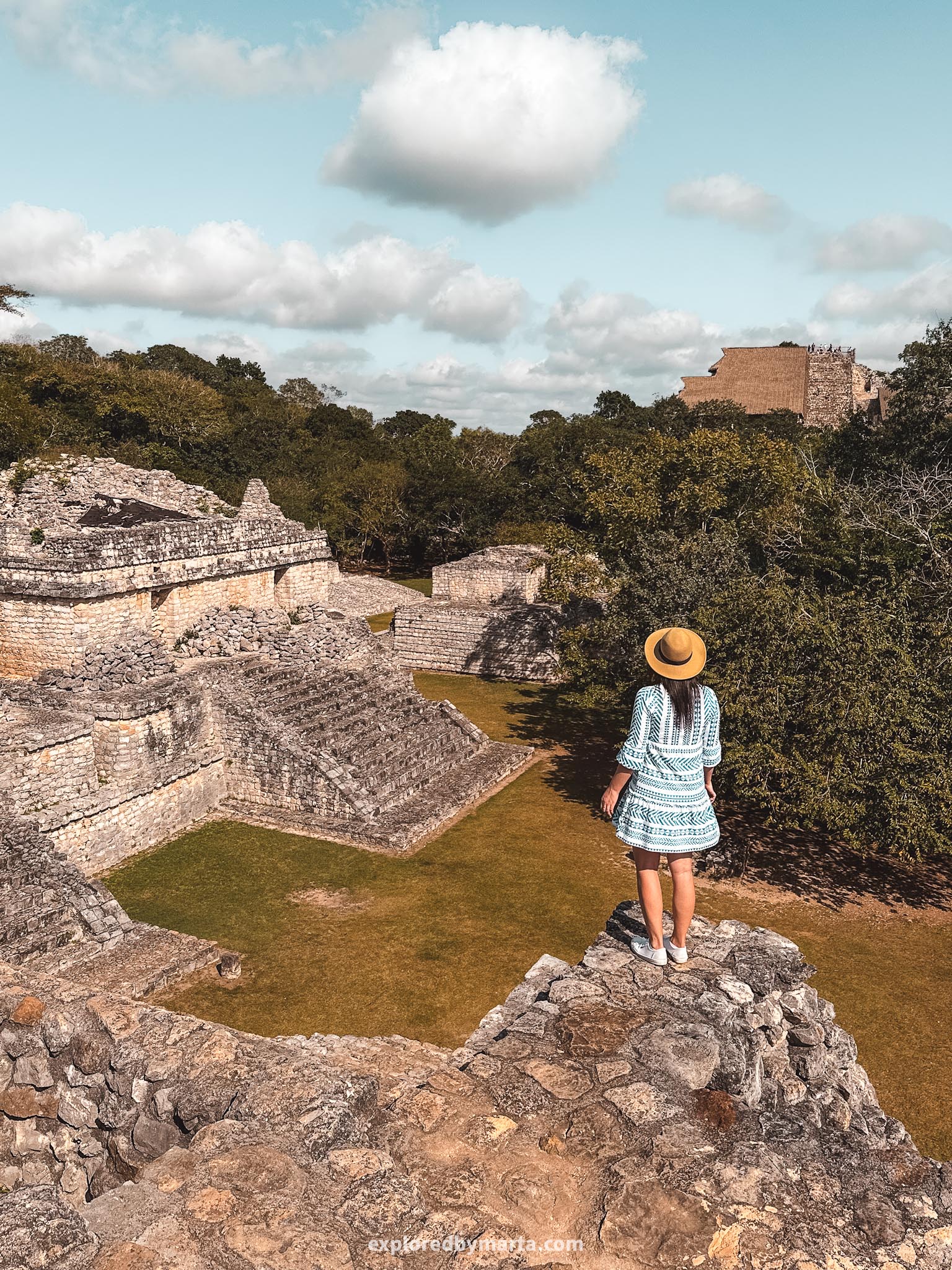
Overall I liked exploring Ek Balam. These weren’t my favorite Mayan ruins, mostly because of the inflated entrance fee, but I also don’t regret coming here. It is always cool to explore how the Mayan civilization lived before the Spanish found them.
Ek Balam is amongst the last larger Mayan archaeological sites where you are allowed to climb the pyramids. Another larger site where you can climb the pyramids is the Dzibanché archaeological zone located to the South of Bacalar.
Location: Archaeological Zone of Ek Balam
11. The rainbow-colored city – Valladolid
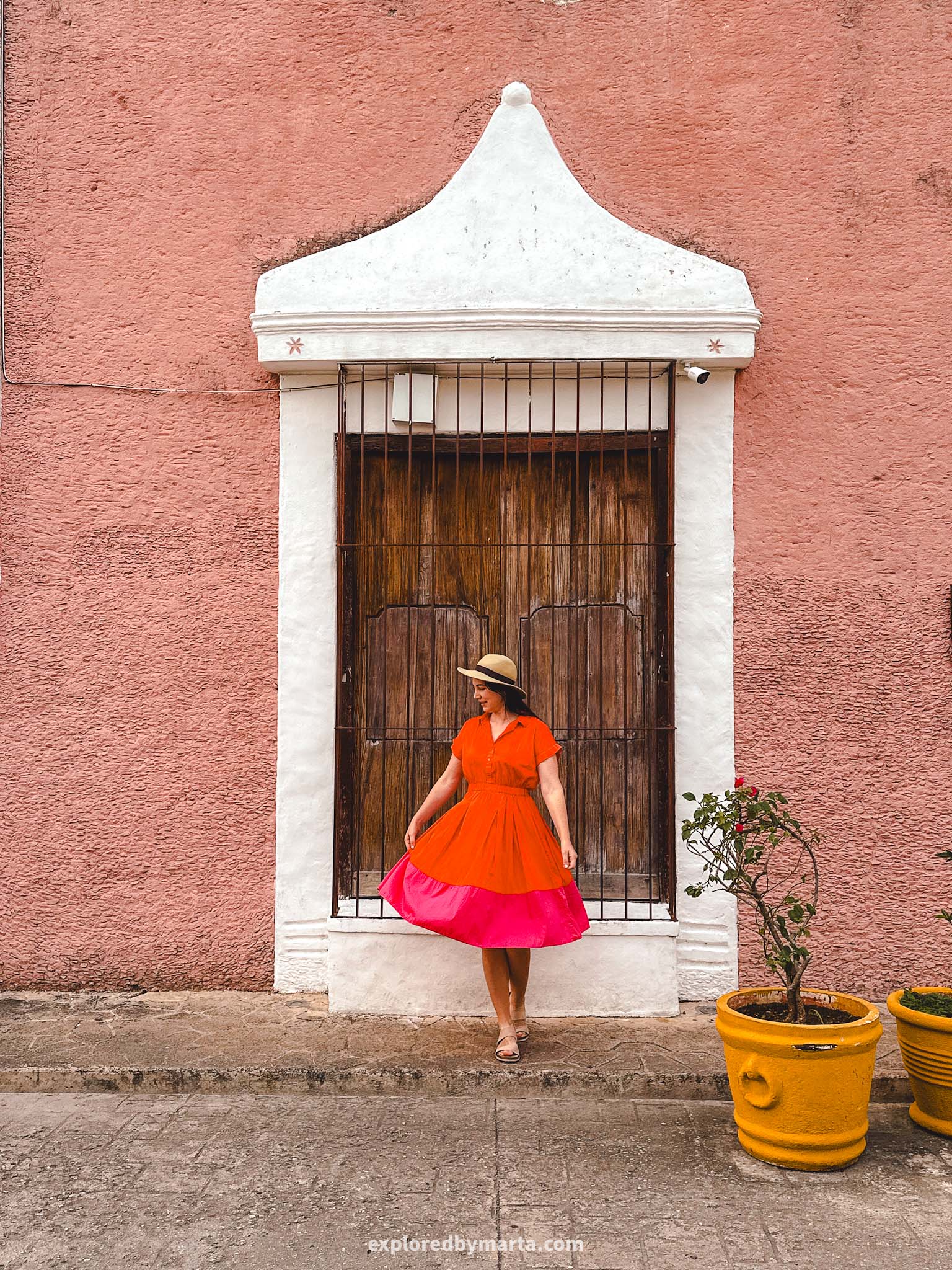
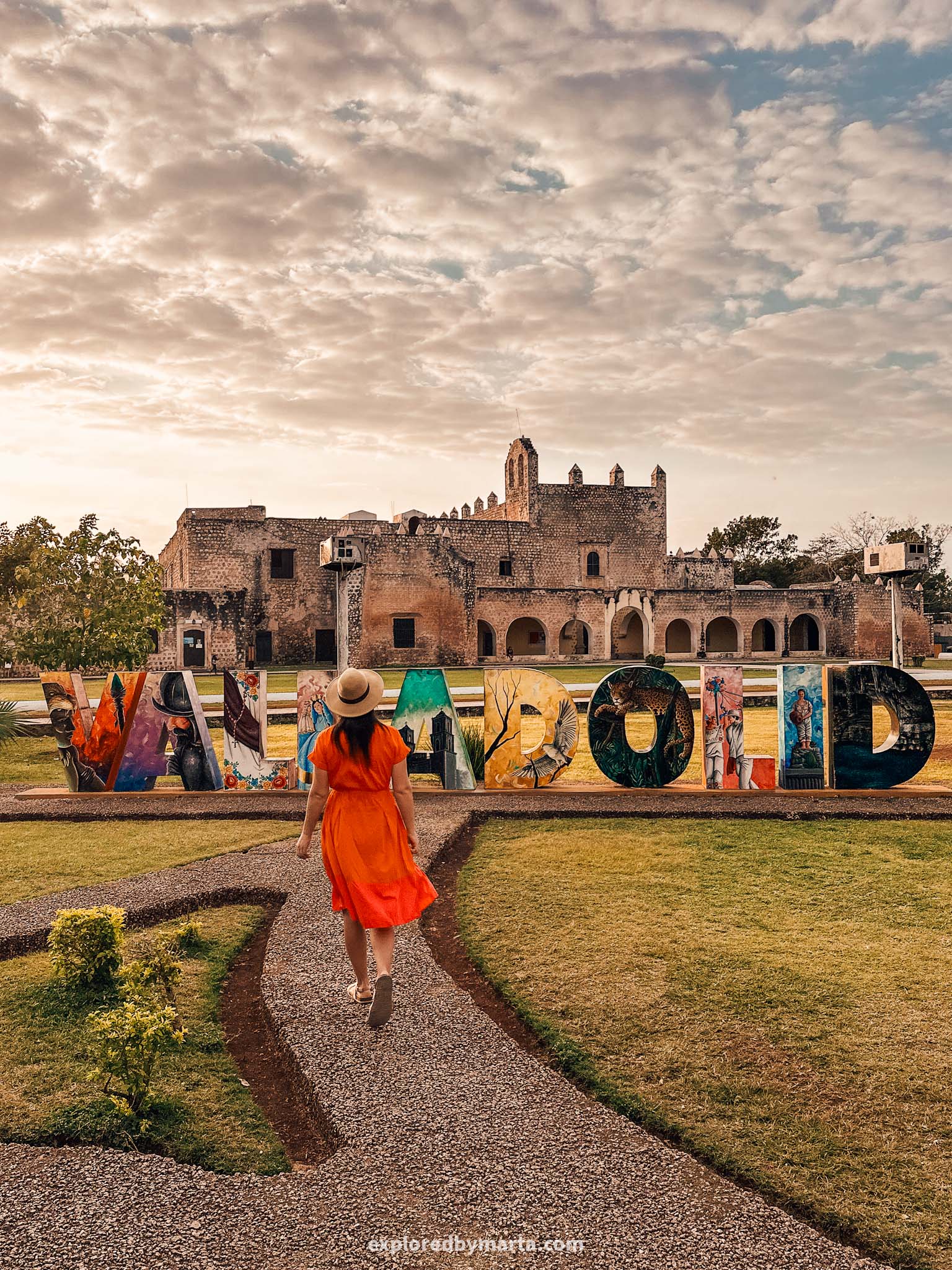
Another magical town (Pueblo Magico) to stop by just a day trip away from Tulum is Valladolid. This picturesque city really surprised us with its rainbow-colored streets and majestic colonial architecture! The most colorful city in Yucatan!
Valladolid is a colonial town and was founded and built by the Spanish conquistadors. The city now sits in a place where there once was a Mayan city. Many historical buildings were built using stones from nearby Mayan sites including Chichen Itza.
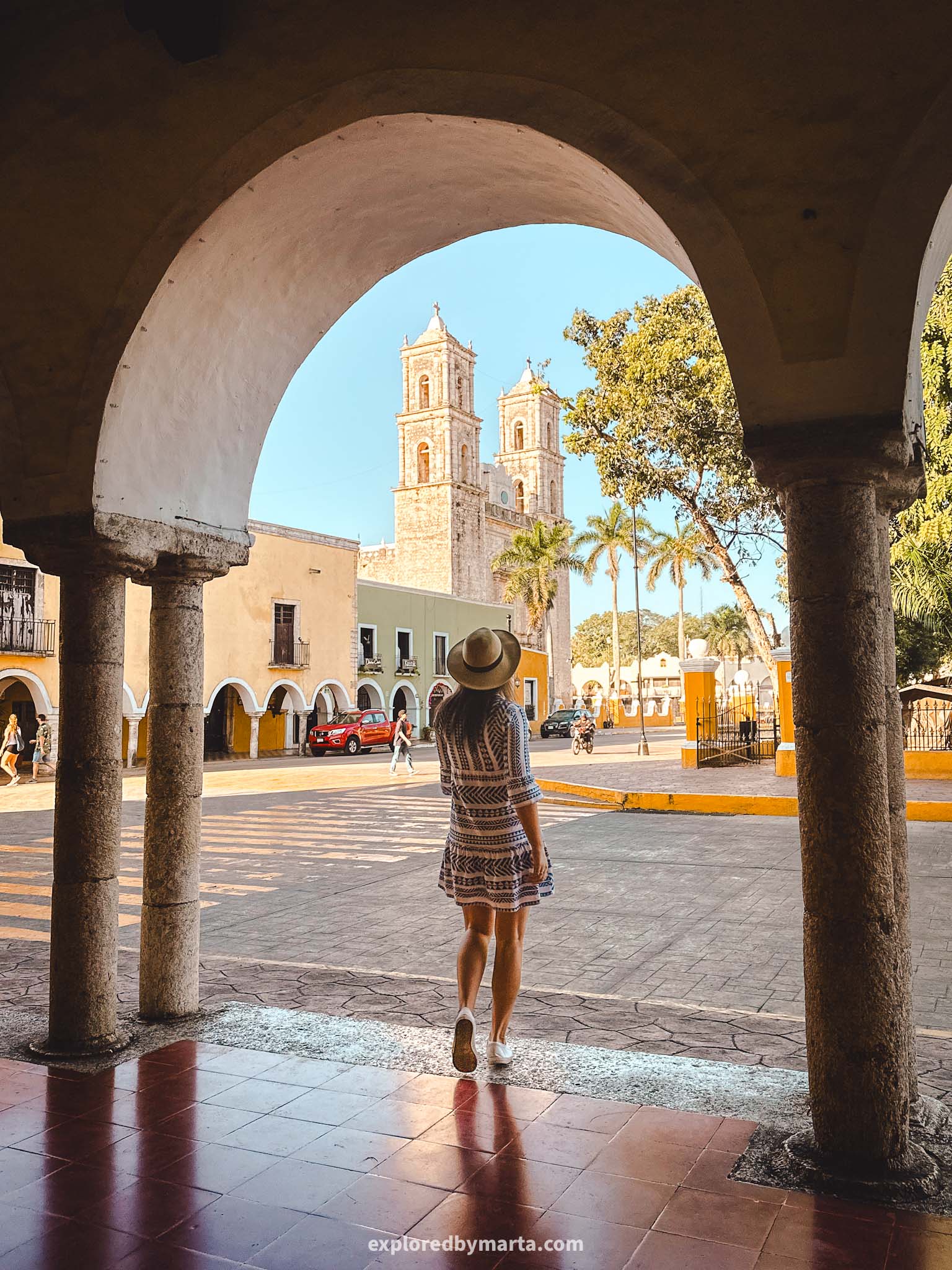
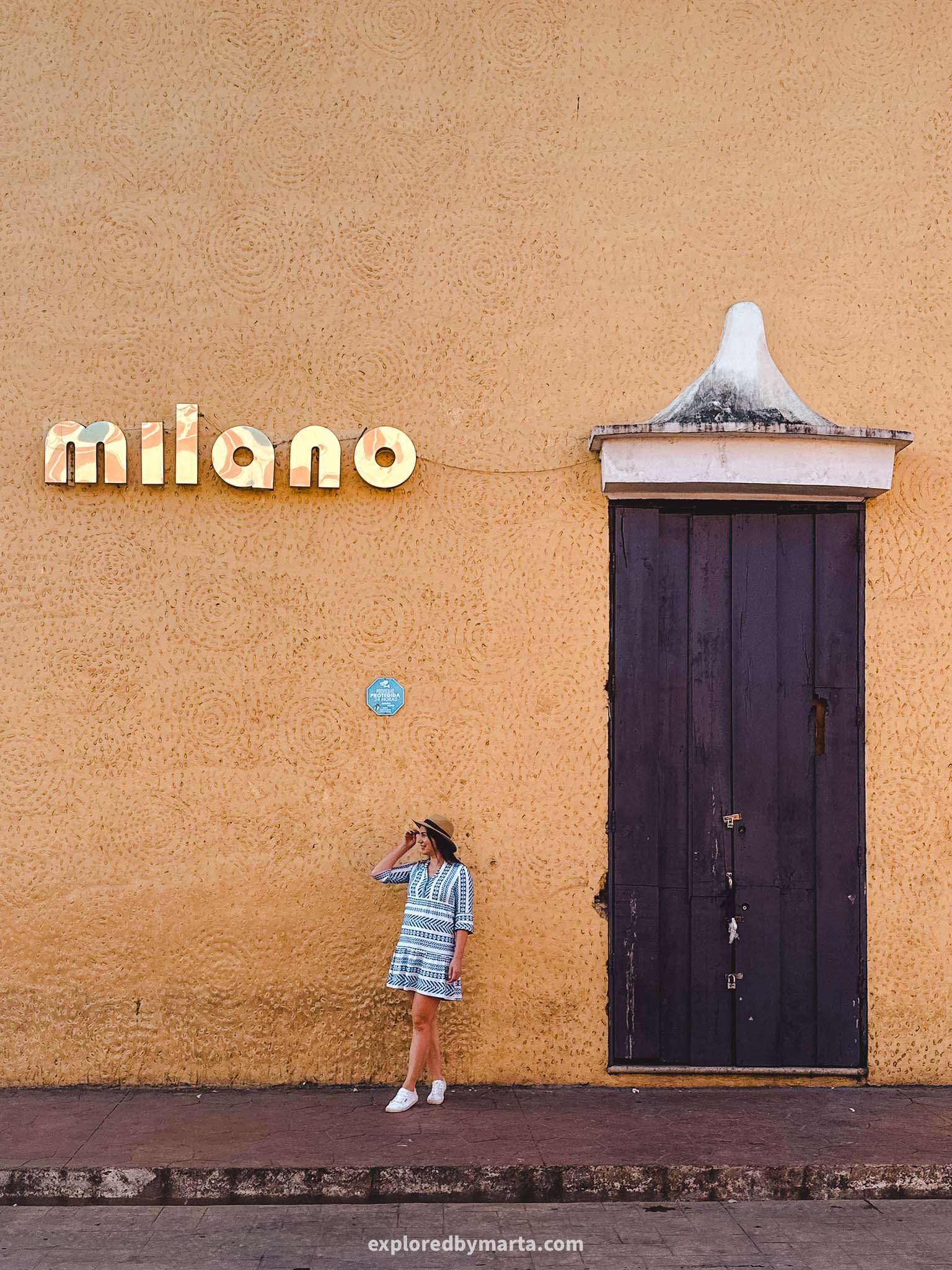
Thanks to its proximity to the famous Chichen Itza ruins, Valladolid has grown from just a stopping point along the way to the world-famous Mayan pyramid to an established tourist destination in the Yucatan Peninsula.
We actually spent three weeks in Valladolid exploring everything this city and its surroundings had to offer. Besides such famous landmarks as Chichen Itza or Ek Balam archaeological sites, there are many other things to do in Valladolid.
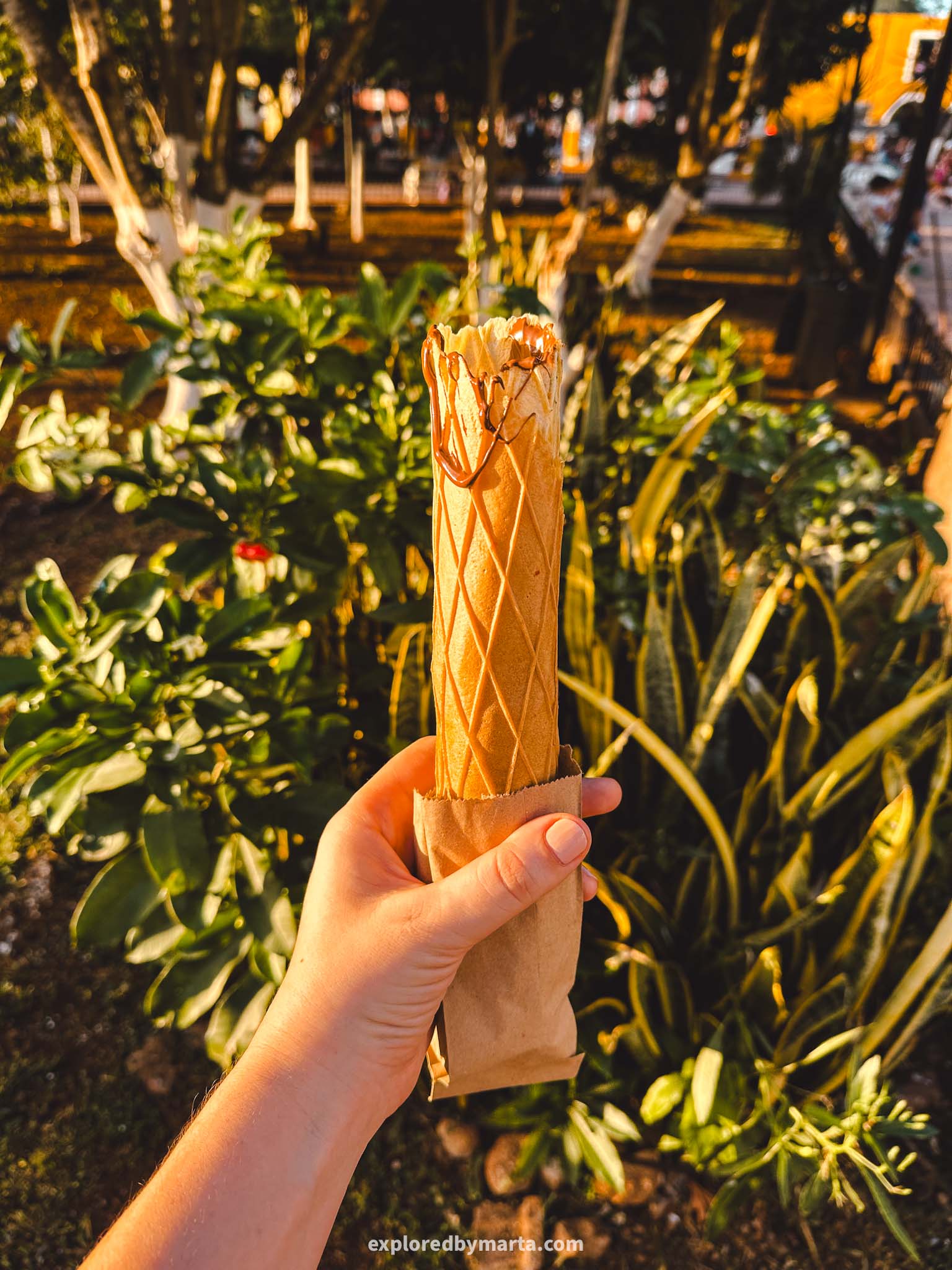

A must-visit place in Valladolid is Parque Principal – we went to the main square numerous times to grab those tasty marquesitas, churros, and gelatos, and watch Mayan dancers performing while juggling dish trays on their heads!
Right next to the main square, there is one building that stands out – Templo de San Servacio or Church of San Servacio. It is a colonial church with two bell towers, founded in the 16th century along with the whole city but was remodeled in the 18th century.
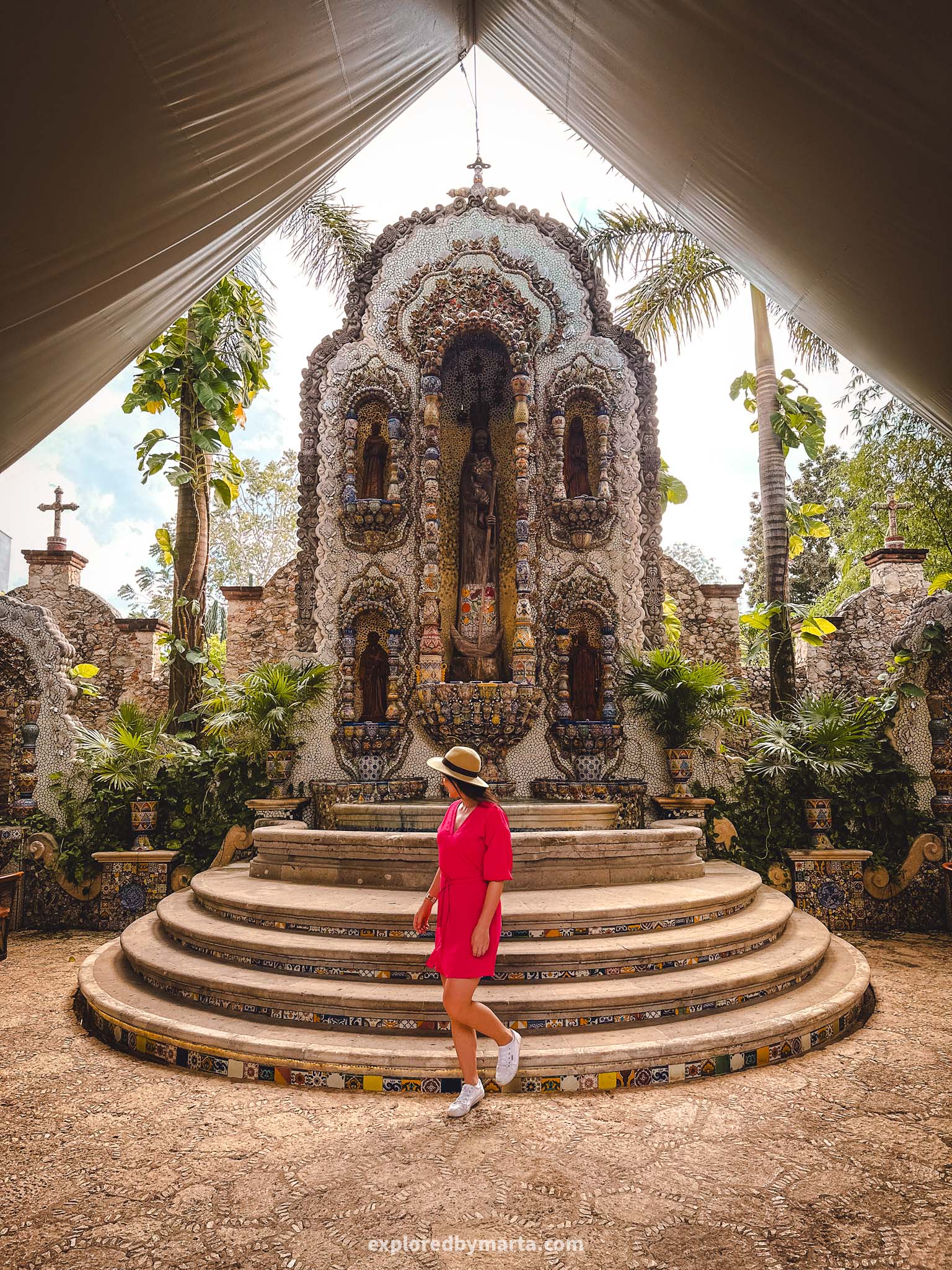

You will also want to walk the colorful Calzada de los Frailes street – one of the most colorful streets and iconic Instagram spots in Valladolid! The street goes from the historic center to another major landmark – the Convent of San Bernardino de Siena.
The convent is one of the oldest and most emblematic buildings in Valladolid, and is definitely worth visiting! It was built and founded in the middle of the 16th century by the Franciscan order who arrived at Yucatan after the Spanish conquest.


But did you know that there is a cenote right in the heart of Valladolid city? Yep! Cenote Zaci is a gorgeous large cenote located in the very center of Valladolid just a short walk from the main plaza. Like really, just two blocks away! Do check it out!
You will also want to try some tasty food. Trying the local legend – longaniza de Valladolid – is a must. But you might also try some tasty and juicy tacos – I recommend stopping by El Tigrillo street stand or Yakunaj Cocina Mexicana for a nicer meal.
Location: Parque Principal de Valladolid
12. Cenote Suytun & famous cenotes near Valladolid
Exploring amazing cenotes near Valladolid has to be one of your day trips from Tulum! First of all, they are cheaper than cenotes near Tulum. Valladolid cenotes cost us around 200 pesos each whereas cenotes near Tulum were about 300-500 pesos.
Secondly, after visiting about 30 cenotes all around the Yucatan Peninsula, I can safely say that Valladolid has got the best ones for sure – you see for yourself on my blog about the most beautiful cenotes near Valladolid!
1. Cenote Suytun
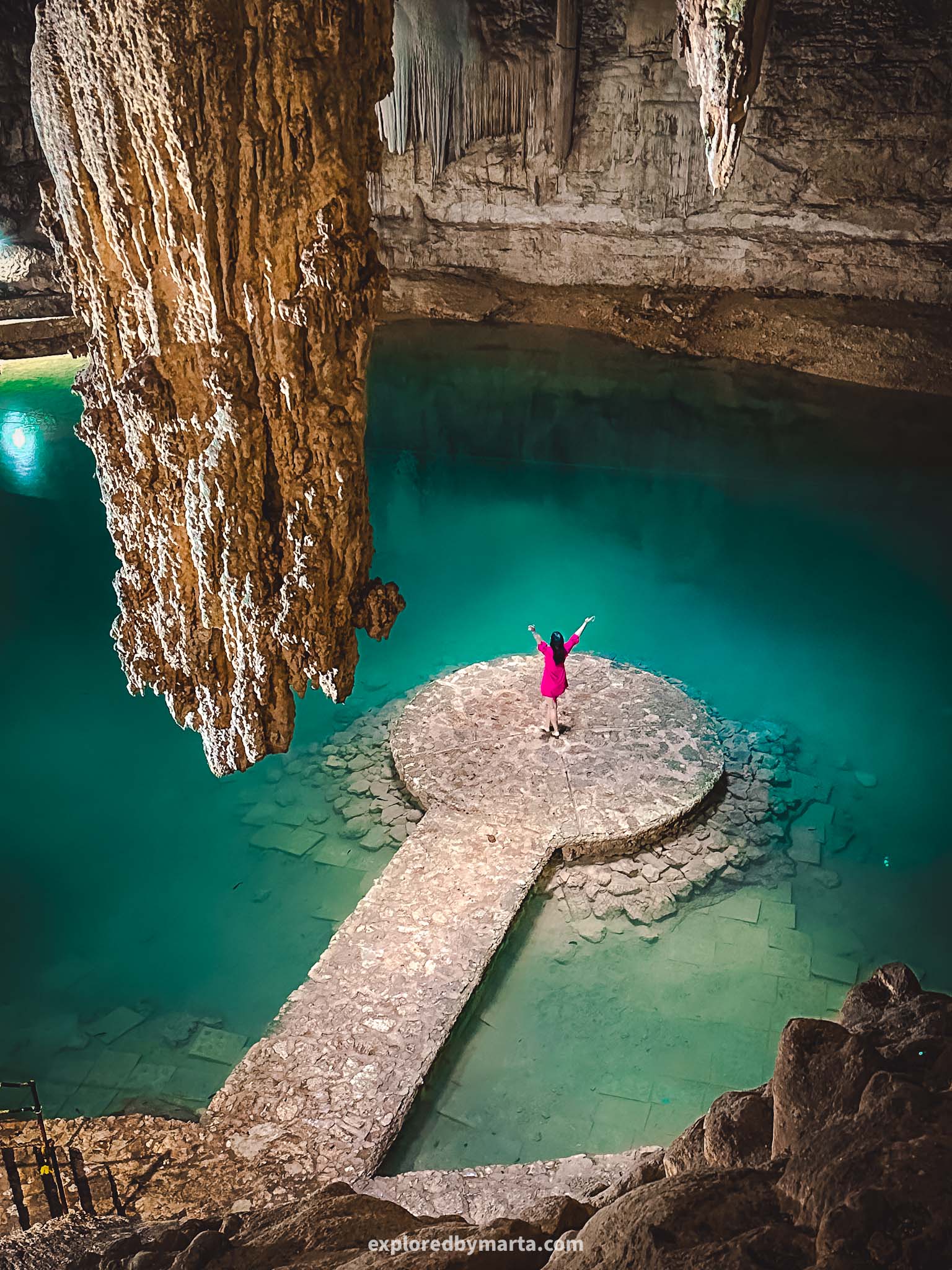
Located just a short drive from Valladolid, Cenote Suytun is one of the most iconic cenotes near Valladolid. Nowhere else will you find a stone pathway leading into the middle of a large underground cenote with a hole in the ceiling right above it.
If you time your visit right, there will be a light beam shining through the hole and illuminating the whole place. Or maybe it will shine right onto the stone platform. We arrived in the morning so we did not see the light beam.
Tip! We visited this cenote on March 9th and the stone platform was dry. However, the water level can be higher or completely cover the platform after rainy periods. The best way to make sure how it looks is by checking recent reviews on Google Maps.
Location: Cenote Suytun
2. Cenote Samaal
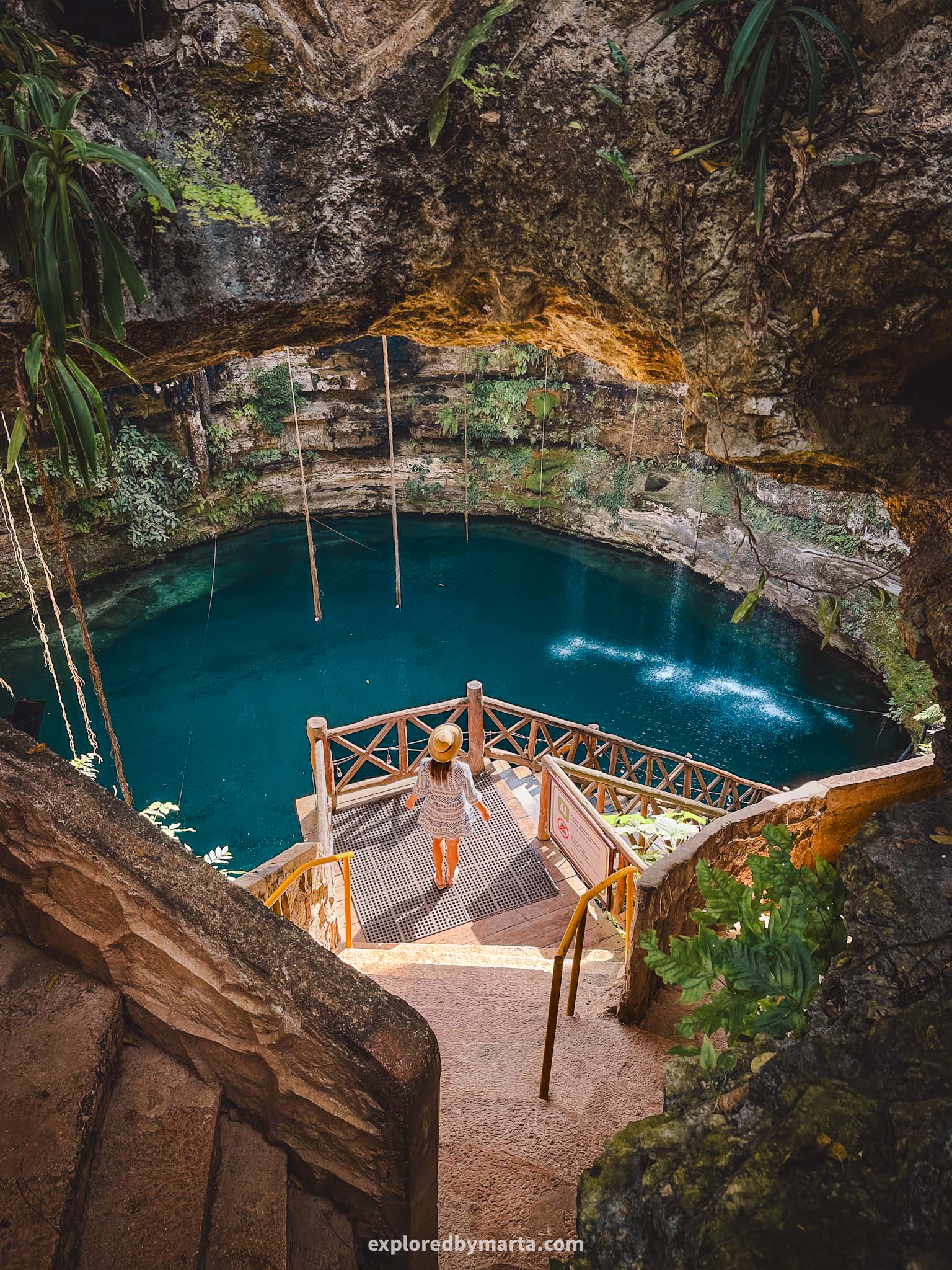
Valladolid is blessed with many incredibly beautiful cenotes near the city – some of the most beautiful in the whole Yucatan peninsula! Another gorgeous and unique cenote just a 10-minute drive from the center of Valladolid is Cenote Saamal.
Cenote Samaal is one of those gorgeous semi-open cylindrical cenotes with crystal clear cool water and even a waterfall coming down from the top of the walls. Perfect place for a refreshing dip into the water!
Location: Cenote Saamal
3. Cenote Xcanahaltun
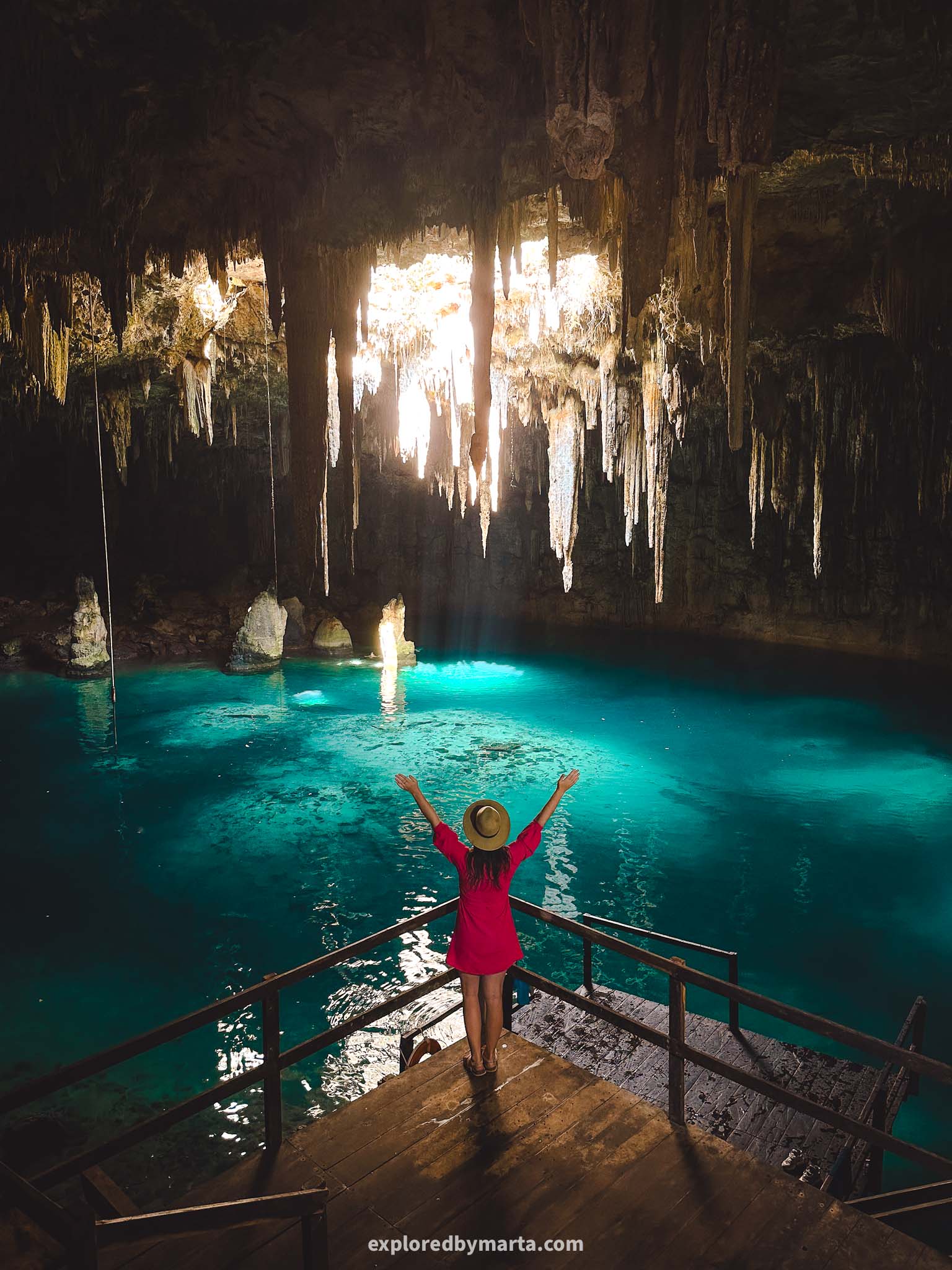
I didn’t expect much from Cenote Xcanahaltun as I had already visited many stunning cenotes but as soon as I entered the majestic cave I fell in love and this place immediately became one of my favorite places in Yucatán!
The glorious cathedral-sized cenote is actually like a large underground lake with a small hole in the ceiling that lets natural light inside the cavern. The ceiling is adorned with icicle-type stalactites and looks absolutely spectacular.
You can enter the crystal clear water from a wooden platform located on one side of the ‘lake’. The entrance to the cenote was 230 pesos, and for an extra 100 pesos we were offered to rent a kayak. I will never forget this incredible place!
Location: Cenote Xcanahaltun
13. Mexico’s Yellow City – Izamal
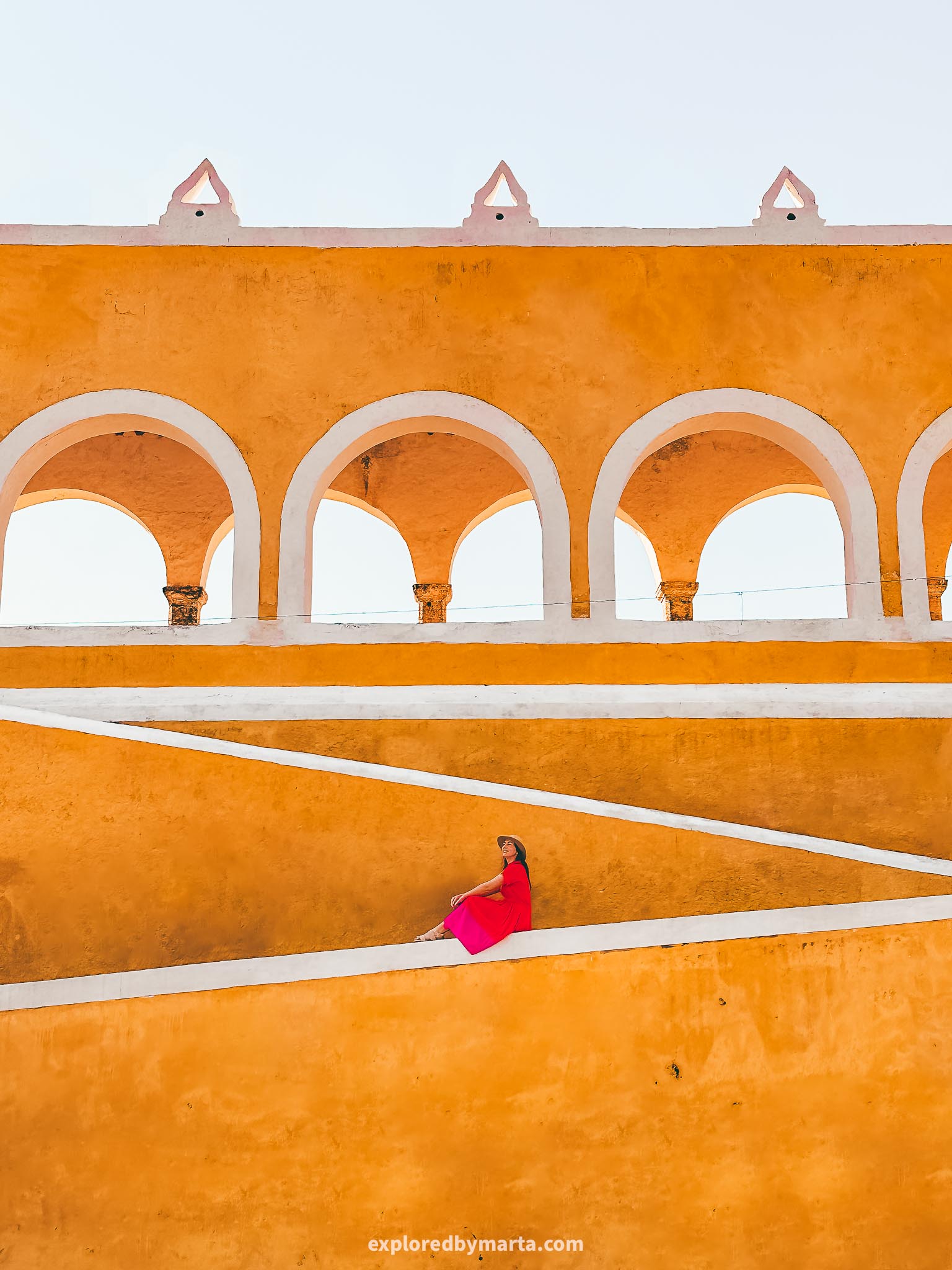
If you are up for a photo-worthy and memorable day trip from Tulum, then you must go to Mexico’s Yellow City – Izamal! This Pueblo Mágico (one of Mexico’s magic towns) is located a 2h 45 min drive from Tulum and will only take 3-4 hours to explore!
The colonial town attracts visitors with its yellow color as all the buildings in the center of this magical town are painted yellow (no, not the entire town). We arrived at Izamal in the morning and spent there half a day exploring everything Izamal had to offer.

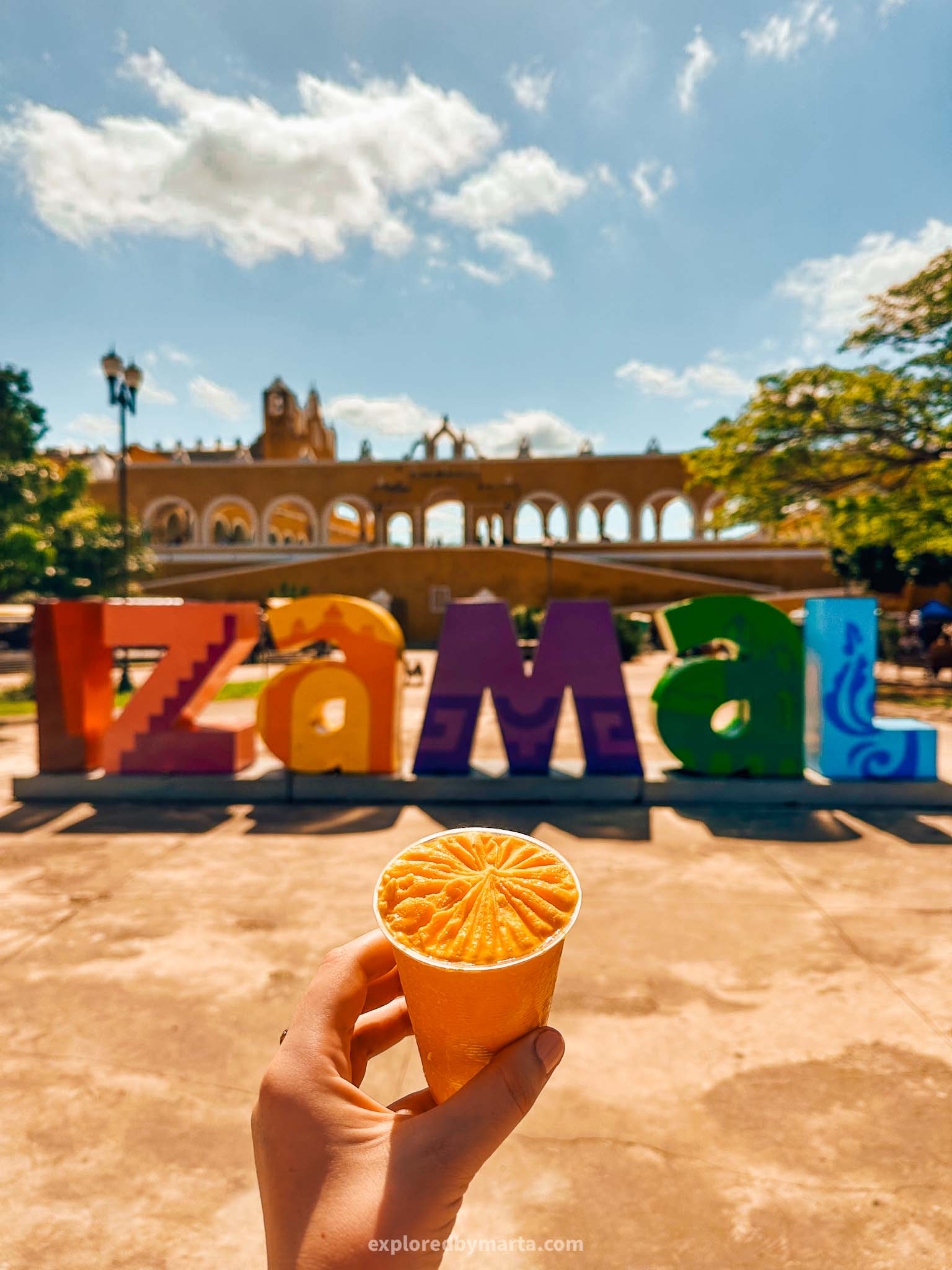
The most famous attraction in Izamal is the Convento de San Antonio sitting atop a hill (there once was an ancient Maya pyramid) in the heart of the town. Next to it, you will find the second-largest atrium in the world surrounded by a beautiful yellow arcade.
You can explore the unique convent and walk around the atrium for free. It does have working hours so check those before coming! The best time to arrive is early morning, before the town heats up to scorching degrees.
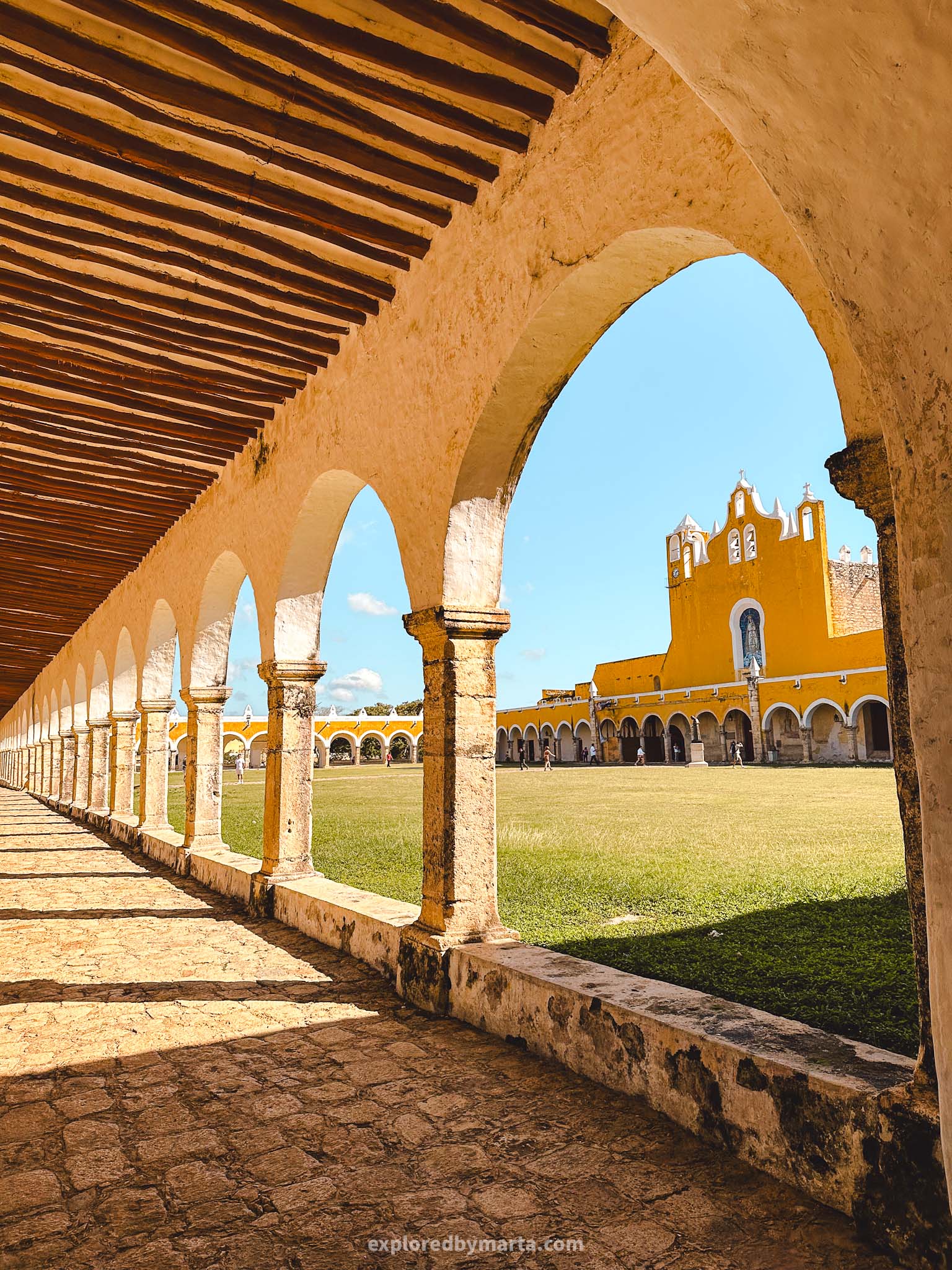
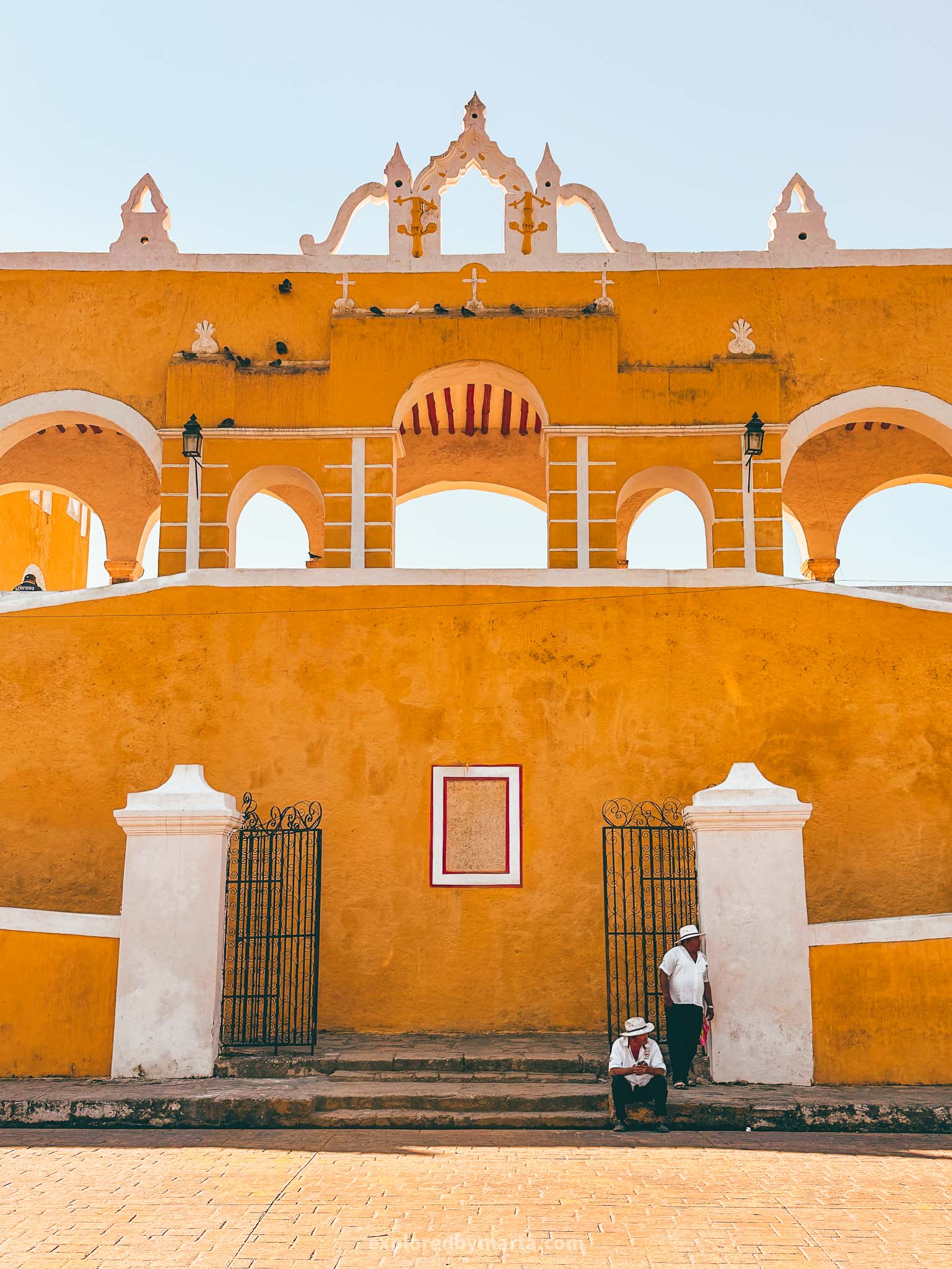
Other must-do things in Izamal include climbing the Mayan pyramids – Kinich Kak Moo and Itzamatul. If you only have time for one, I highly recommend visiting the Kinich Kak Moo pyramid as you can see the whole town of Izamal from the top!
Don’t forget to explore the local market, Mercado Municipal de Izamal, try the yellow corn ice cream, walk around the 5 de Mayo Park, and, for lunch, I suggest trying Mayan dishes at Restaurant Kinich. This was one of my favorite towns in Yucatan!
Location: Convento de San Antonio in Izamal
14. Pink lakes of Las Coloradas

The bright pink salt lakes Las Coloradas is one of the most beautiful places in the Yucatán Peninsula! The lakes are one of the most popular day trips from Tulum located a 3-hour drive from the city! And it’s a great place for unique photos!
However, visiting this place is also a bit of a game of luck. Before coming here, I studied all the reviews on Google Maps and felt really conflicted. It is a decent drive and to go there and to not get what I wanted would be a disappointment.
But we decided to go and somehow managed to arrive here on the perfect day with the best weather conditions (we visited on February 4th). It was sunny, no clouds, and the lake was screaming pink color at us! So what is the best time to come here?
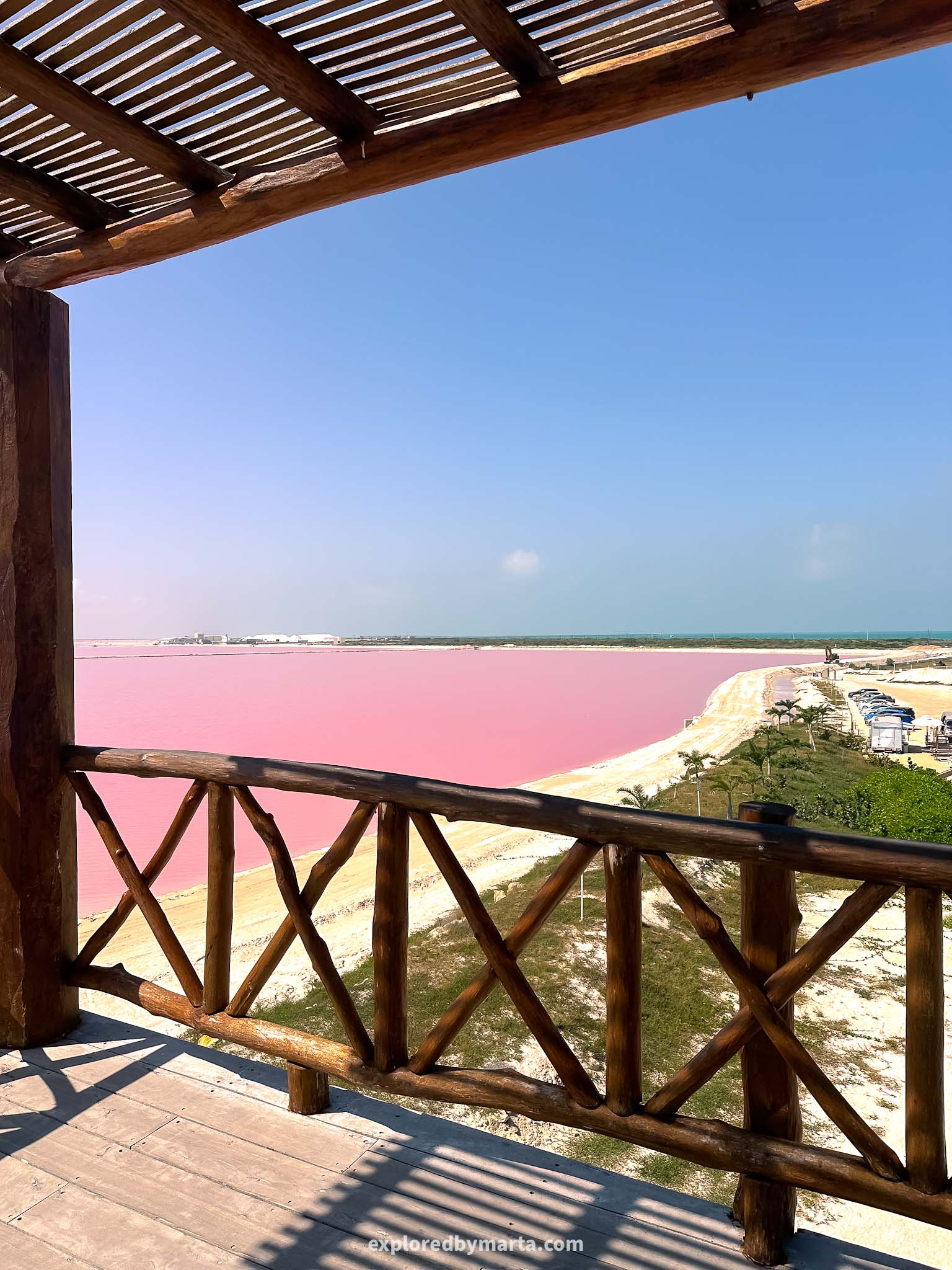
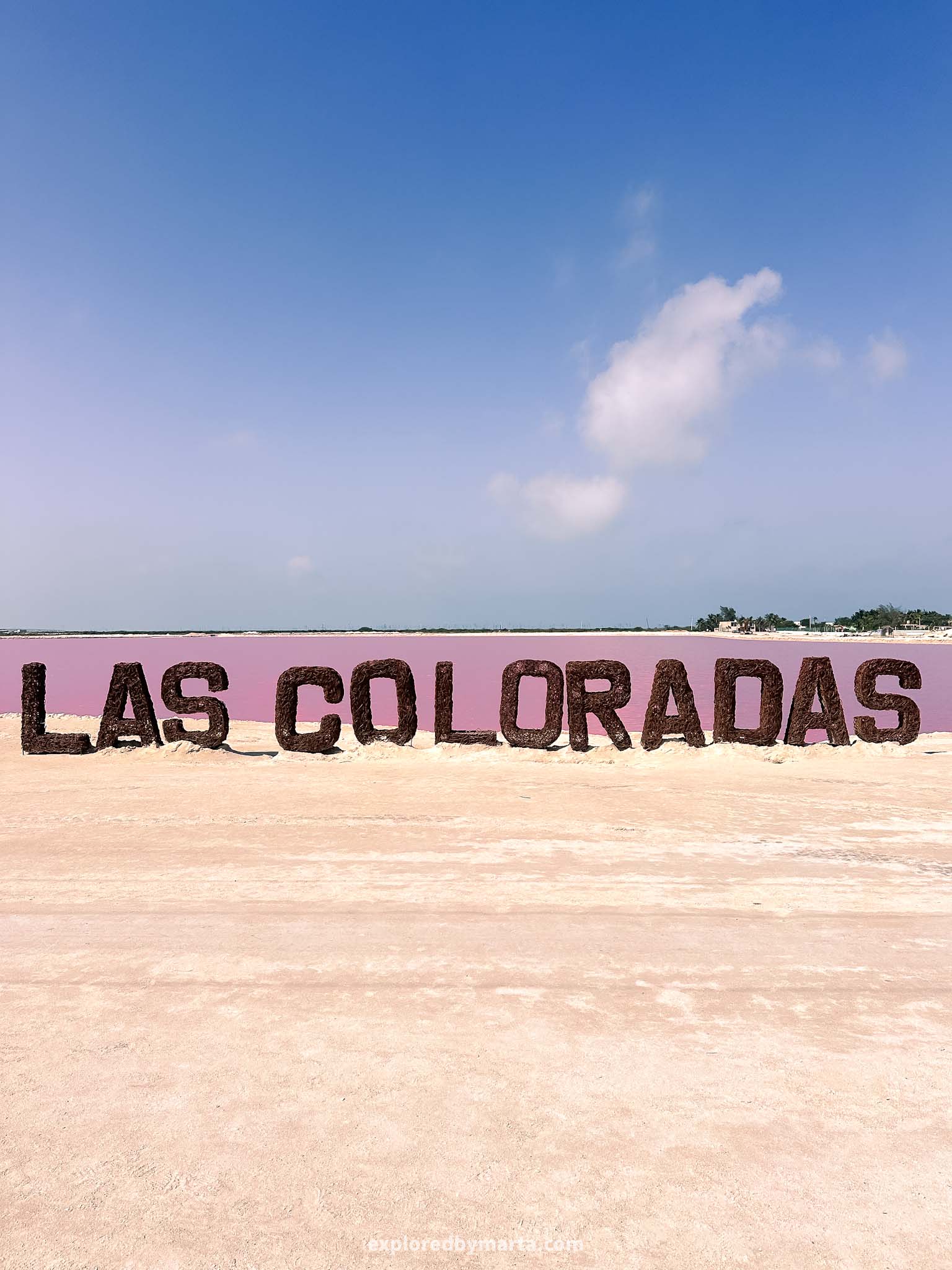
The lakes won’t be pink if there was a storm or a lot of rain over the previous days, you will see a bright pink color only on sunny days (no clouds) and the best angle of the sun will be around midday. And a little bit of wind will make the color pop!
So how to get there? The right place to go is marked on Google Maps as Las Coloradas Parque Turistico. There you will find the ticket office, the observation tower, and the entrance to the pink salt lagoons.
Shortly before arriving, we were met with a group of guides who stopped us and one of them took us to the ticket office. Don’t be scared of them, haha! You can’t visit the lagoons on your own so you need one of those guides anyways!
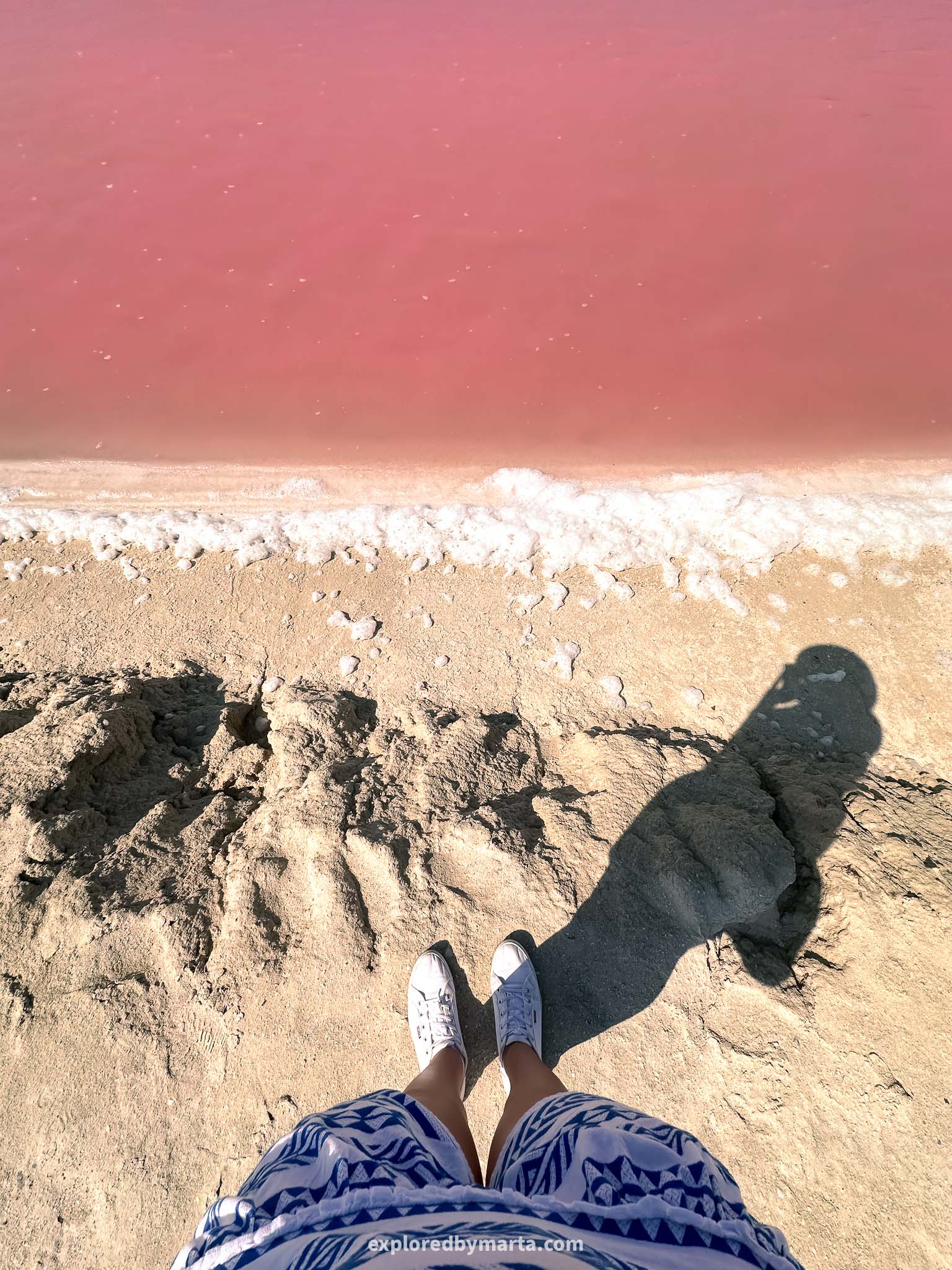
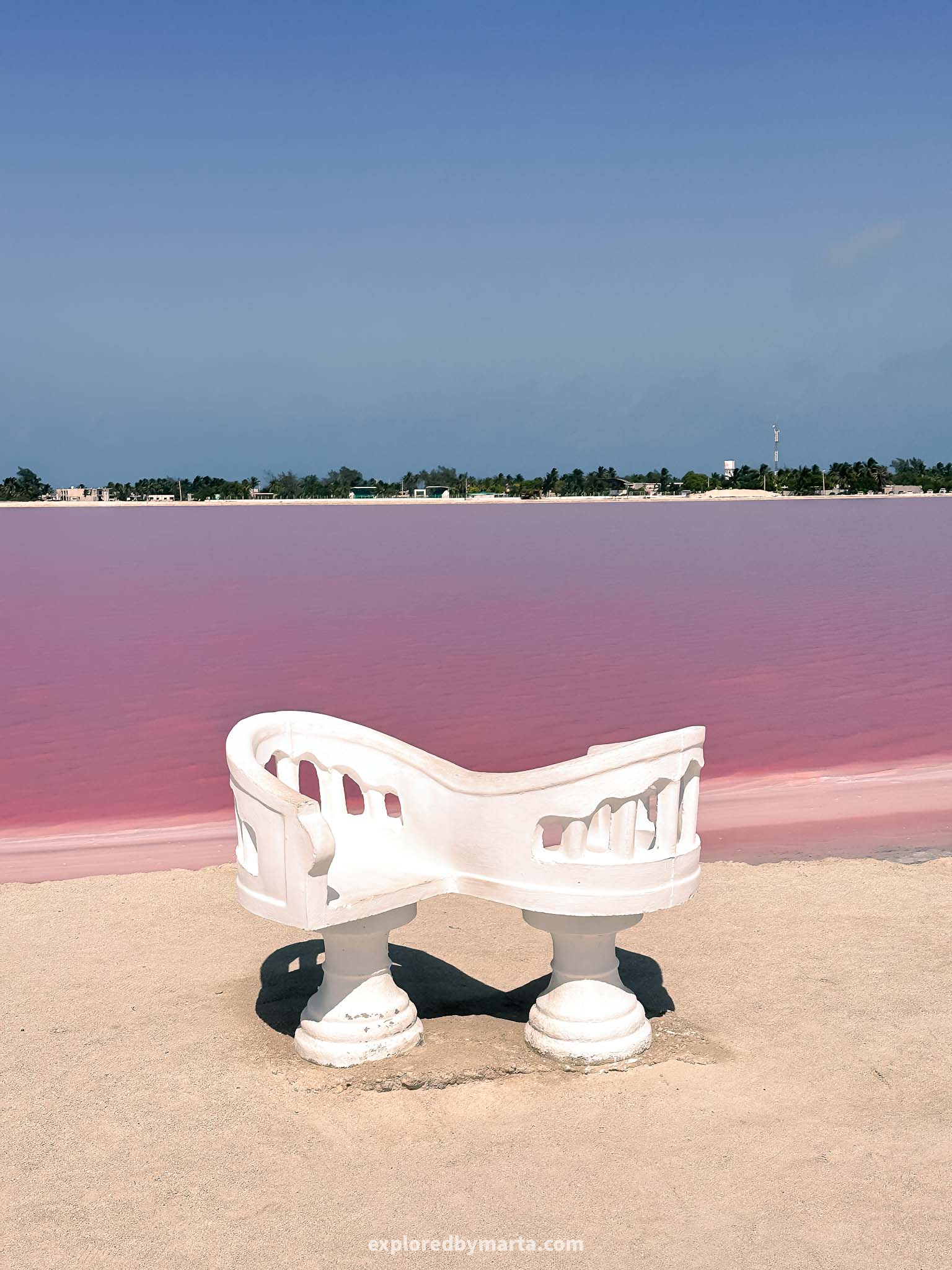
After meeting your guide, you will then have to drive to the ticket office and pay for the entrance. There are three options – you can do a walking tour, you can do a bicycle tour, or a safari tour by car. All have different prices and lengths.
We chose the cheapest option (~350 pesos per person) and went on a walking tour with the same guide that picked us. At first, we climbed the observation tower and then walked along a road next to the pink lake. The tour lasts about 45 minutes.
While the guide tells you stories about the place, you are allowed to take as many pictures as you like. There are different photo spots along the way. But you are not allowed to touch the water or swim there.
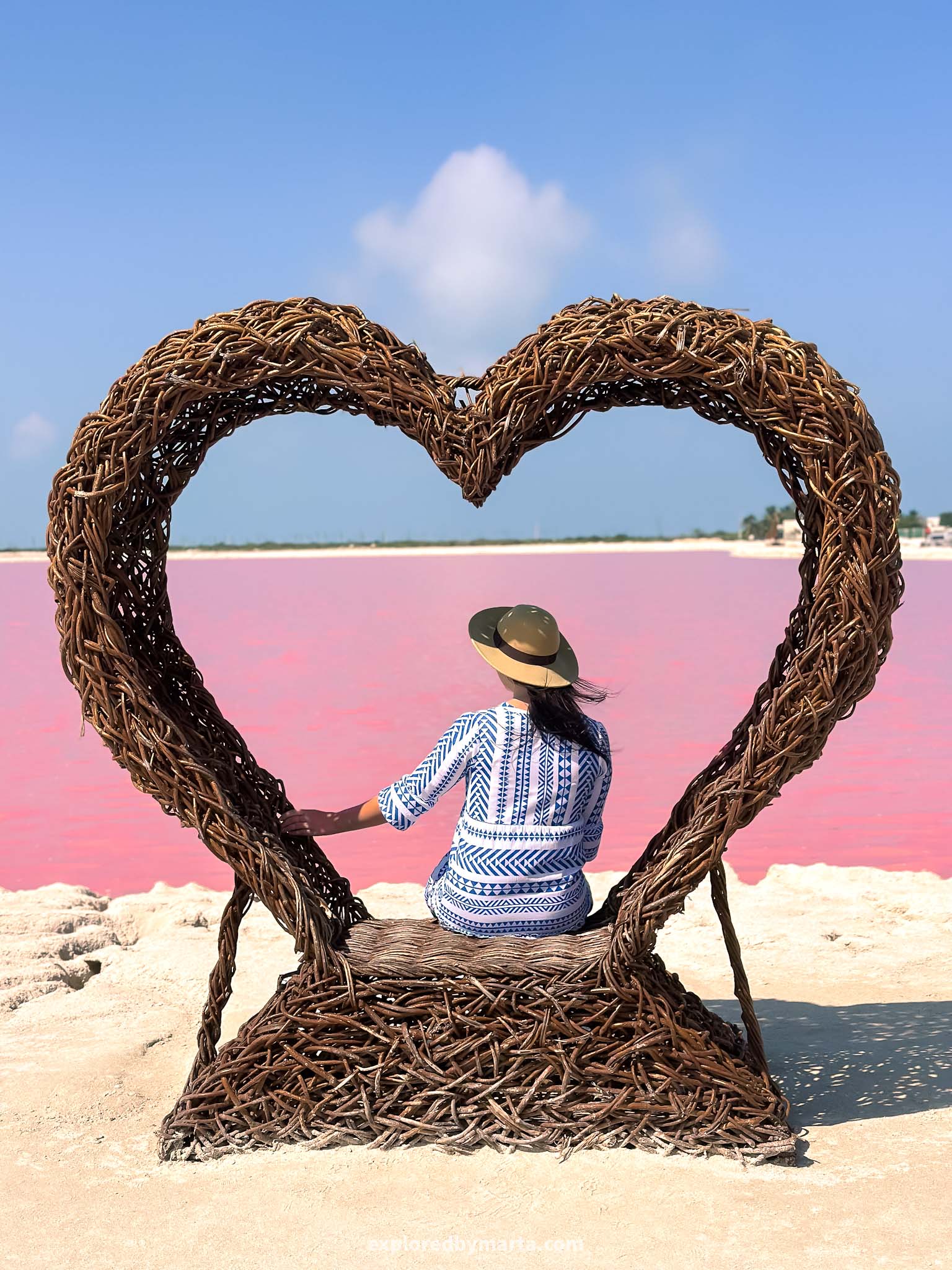
After the tour, the guide asked for a tip, which is meant as payment for his service. Overall, we really liked visiting Las Coloradas. However, I highly recommend checking out the latest reviews on Google Maps before you come!
Take into account that they usually harvest salt here around late July to August, and the pink color is less visible. The guide also told us that after one hurricane, the lake lost its pink color for a whole year, so better make sure it’s worth coming!
You should also know that the lake is not natural. It is a pink pond owned by a large company that produces salt, and you can’t see much of it unless you pay for the guided visit. Yes, it is very commercialized but I definitely wasn’t disappointed.
Location: Las Coloradas
15. Convento de Santo Domingo in Uayma
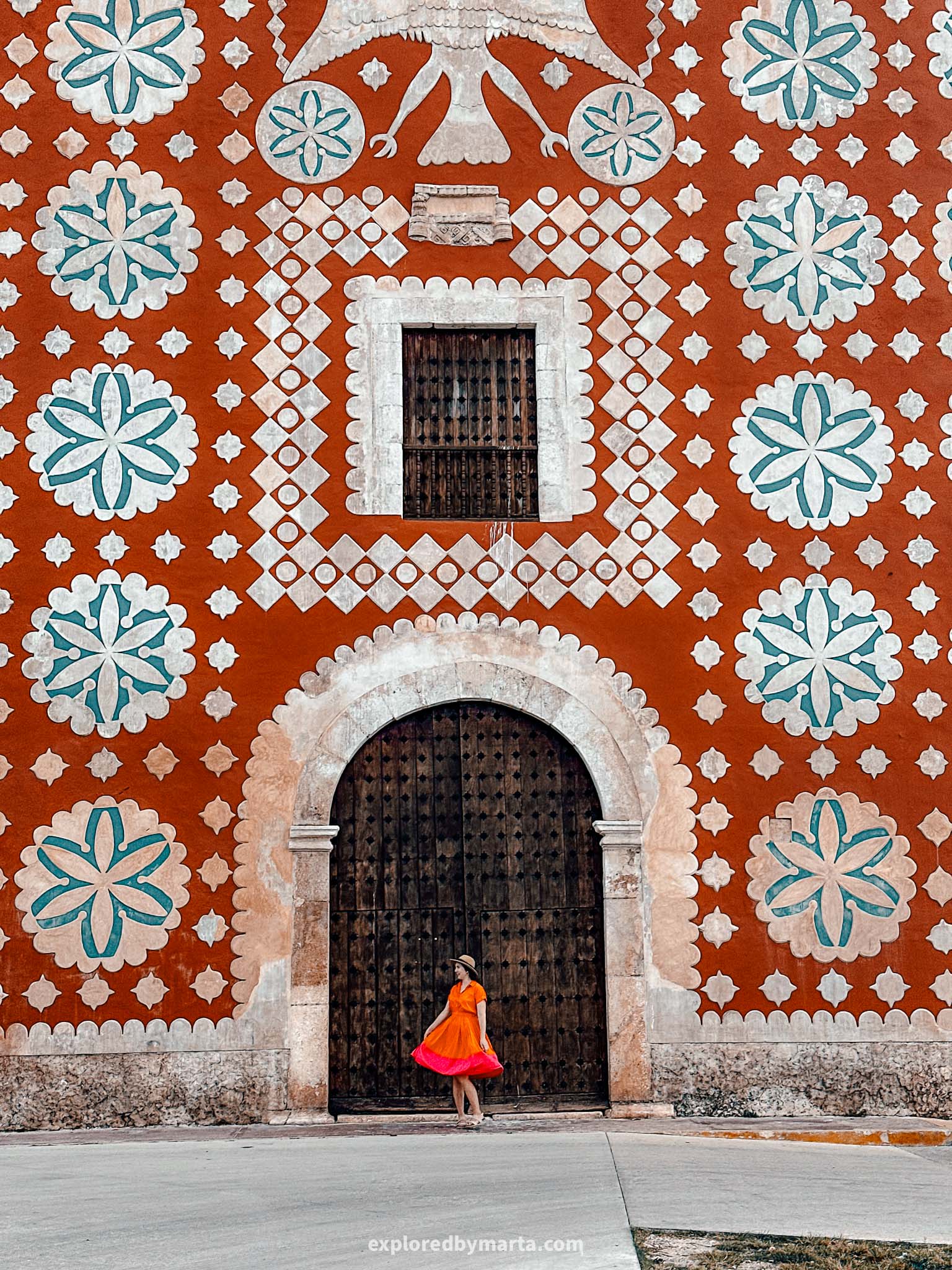
Convento de Santo Domingo in the town of Uayma is an off-the-beaten-path place in Yucatan. It is located a 20-minute drive from Valladolid and would make a perfect spot to stop by on your way to other nearby destinations like Izamal or Chichén Itzá!
The beautiful photo-perfect Convento de Santo Domingo is a former convent built by the Franciscans in the middle of the 17th century. It was built by using stones from Mayan sites. Yes, including from the nearby Chichén Itzá.


During the second half of the 19th century, the church was burned down during a Mayan rebellion. Only more than 100 years later the roofless church was finally restored and was officially reopened to the public in 2004.
The captivating building stands out with its unusual decorations – the white roses and stars symbolize the veneration of the Virgin Mary, but the red color represents sacrifice and martyrdom. There is also a green color that symbolizes hope.

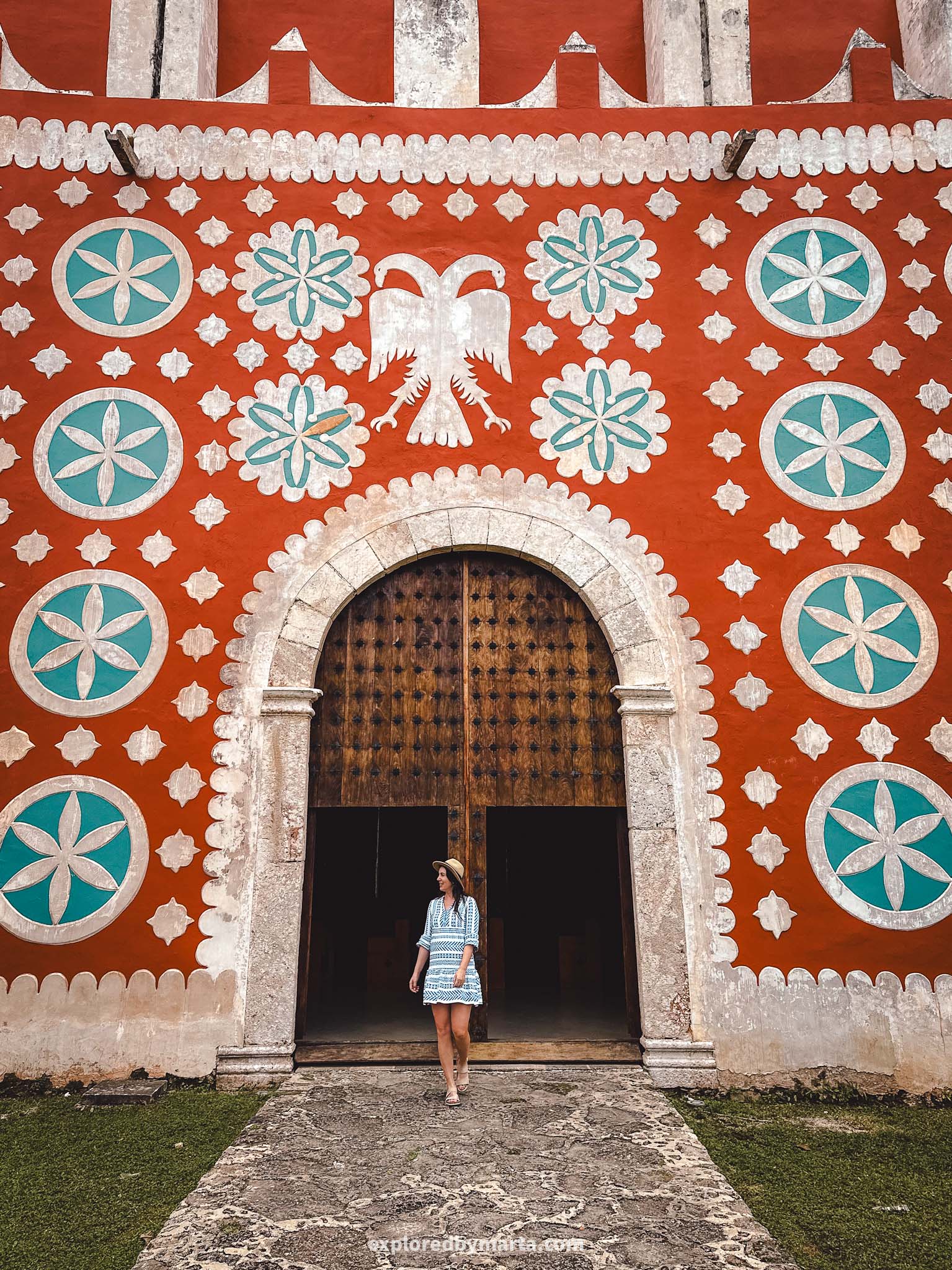
The front of the Uayma church also depicts a large headless eagle which is a symbol of the Franciscans who built the church. Over the last few years, this church has become a unique landmark in the Yucatán Peninsula thanks to its colors and symbols.
We visited this church on Saturday and at 11 AM it was open so we could enter the inside of the church for donations. By the way, the entrance is from a side street – Calle 21. The interior was beautiful but not as bright.
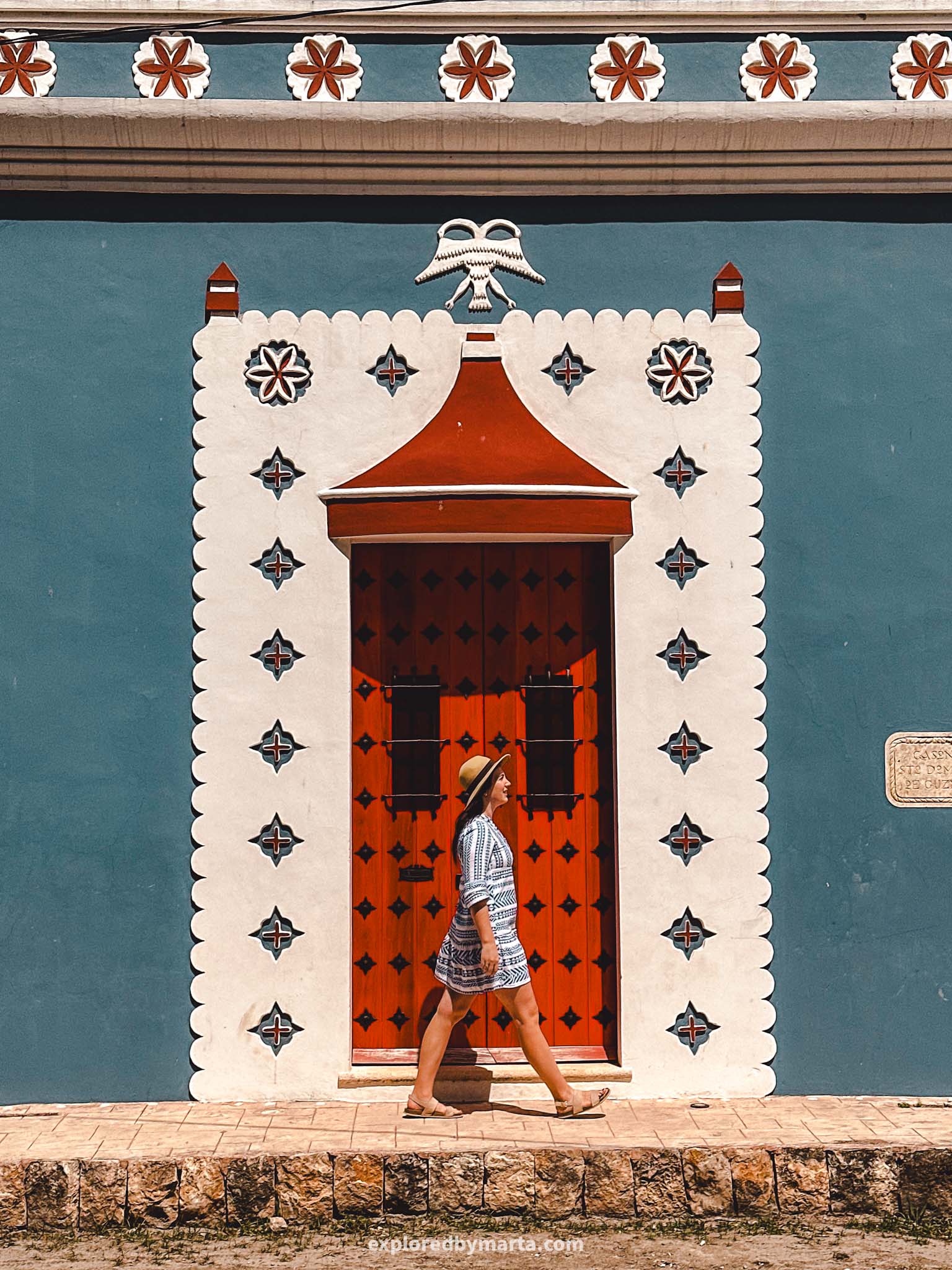

We also noticed another building on the corner of the Park of Uayma, which was decorated with unique illustrations. Interestingly, we saw illustrations exactly like these in the old photos inside the convent. Could be another renovated historical building.
Overall, there isn’t much to see in Uayma so don’t plan to spend the whole day here. I think we spent about 2 hours max here, taking photos and exploring the inside of the church as well as walking around the central park next to the church.
Location: Iglesia de Uayma
16. Pink flamingos in the wild in Celestún or Río Lagartos
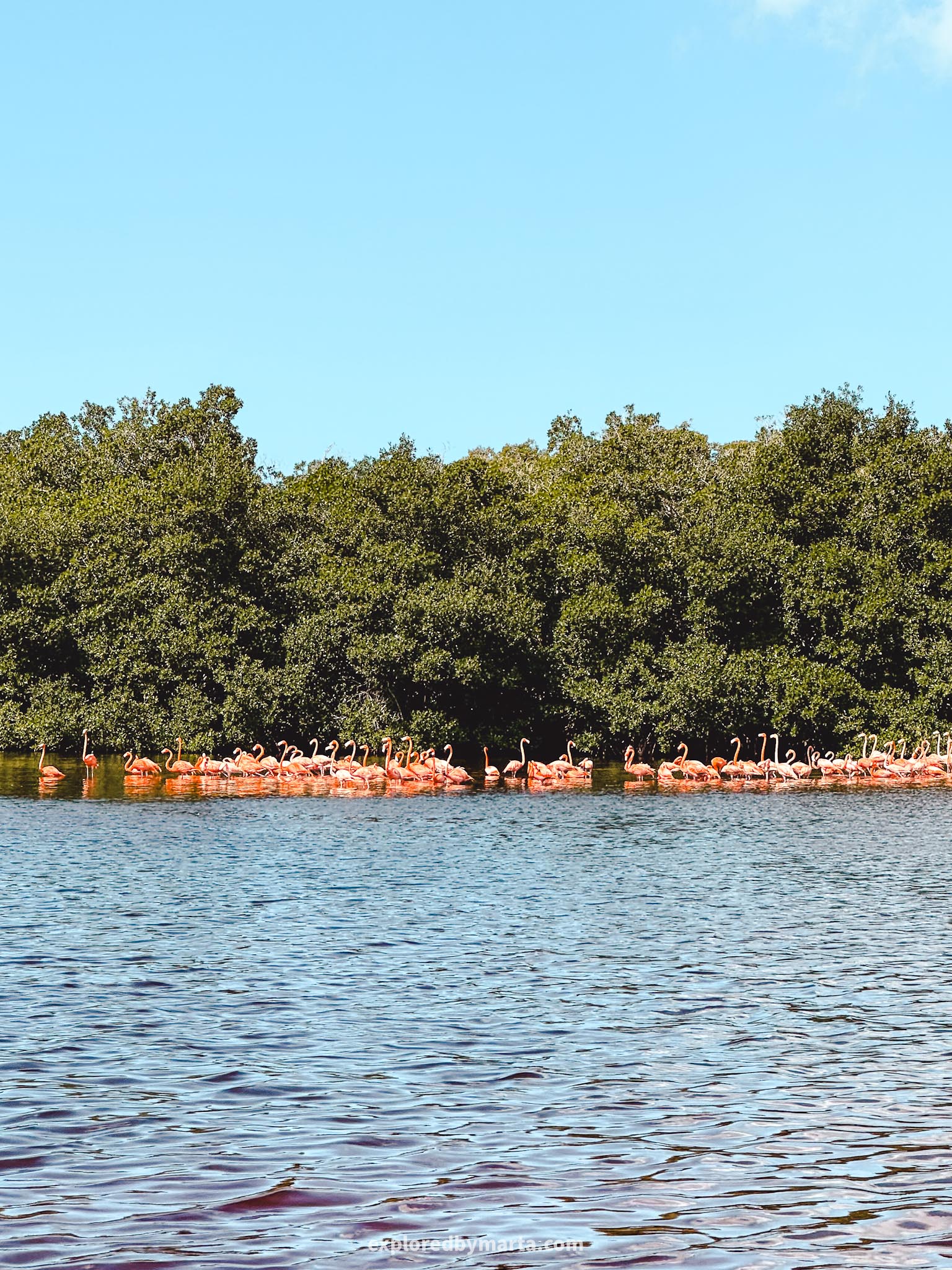
Seeing pink flamingos in the wild is a bucket list thing to do in the Yucatán Peninsula! The main spots to see flamingos in the Yucatán Peninsula are Rio Lagartos just a 1h30min drive from Valladolid, and Celestún just 1 hour from Merida.
Flamingos live in Yucatán all year long, but the biggest hordes of flamingos you will see from November to February during their mating season. We visited Merida in January, so we used this opportunity and traveled to Celestún to see them.
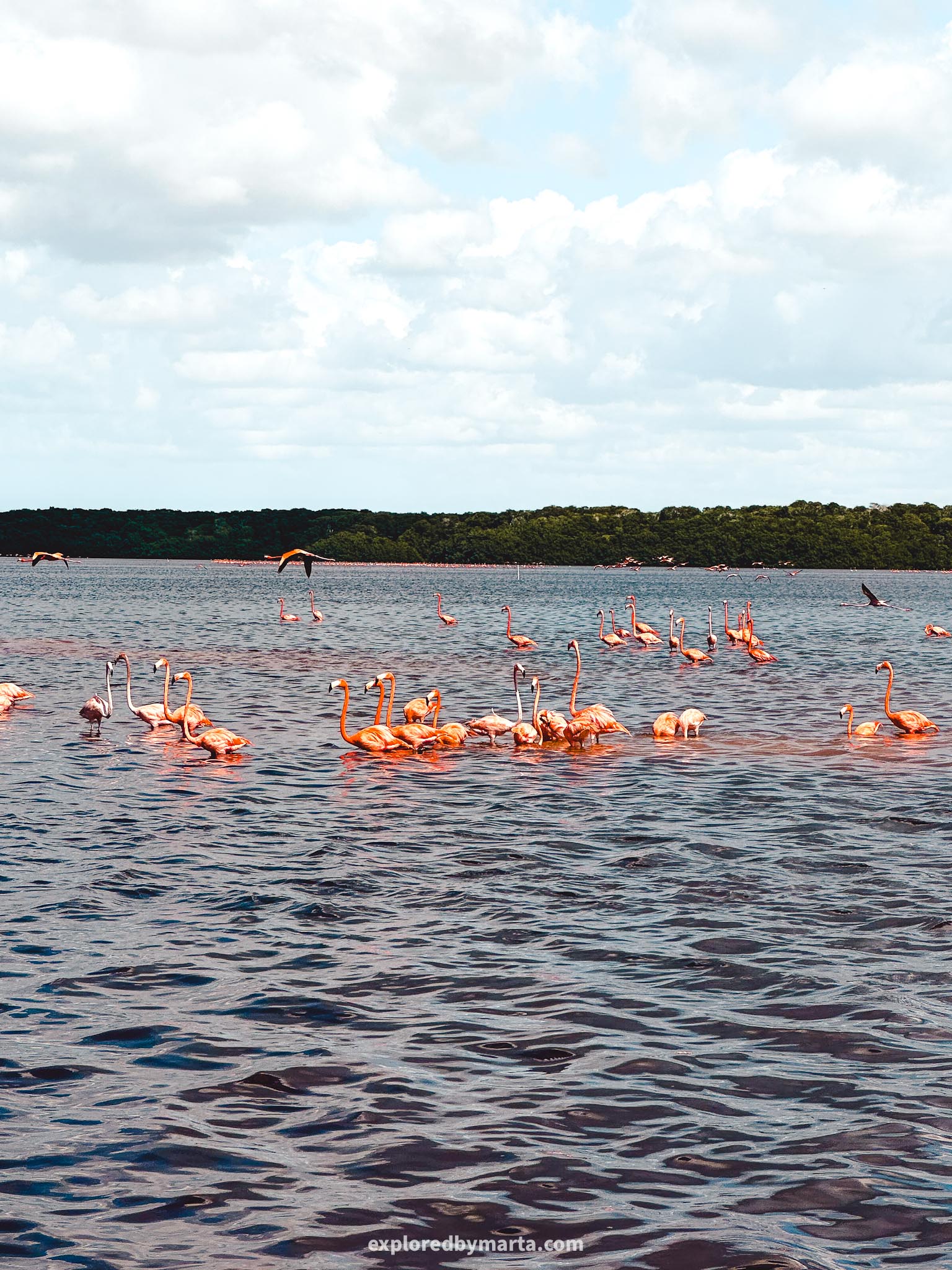
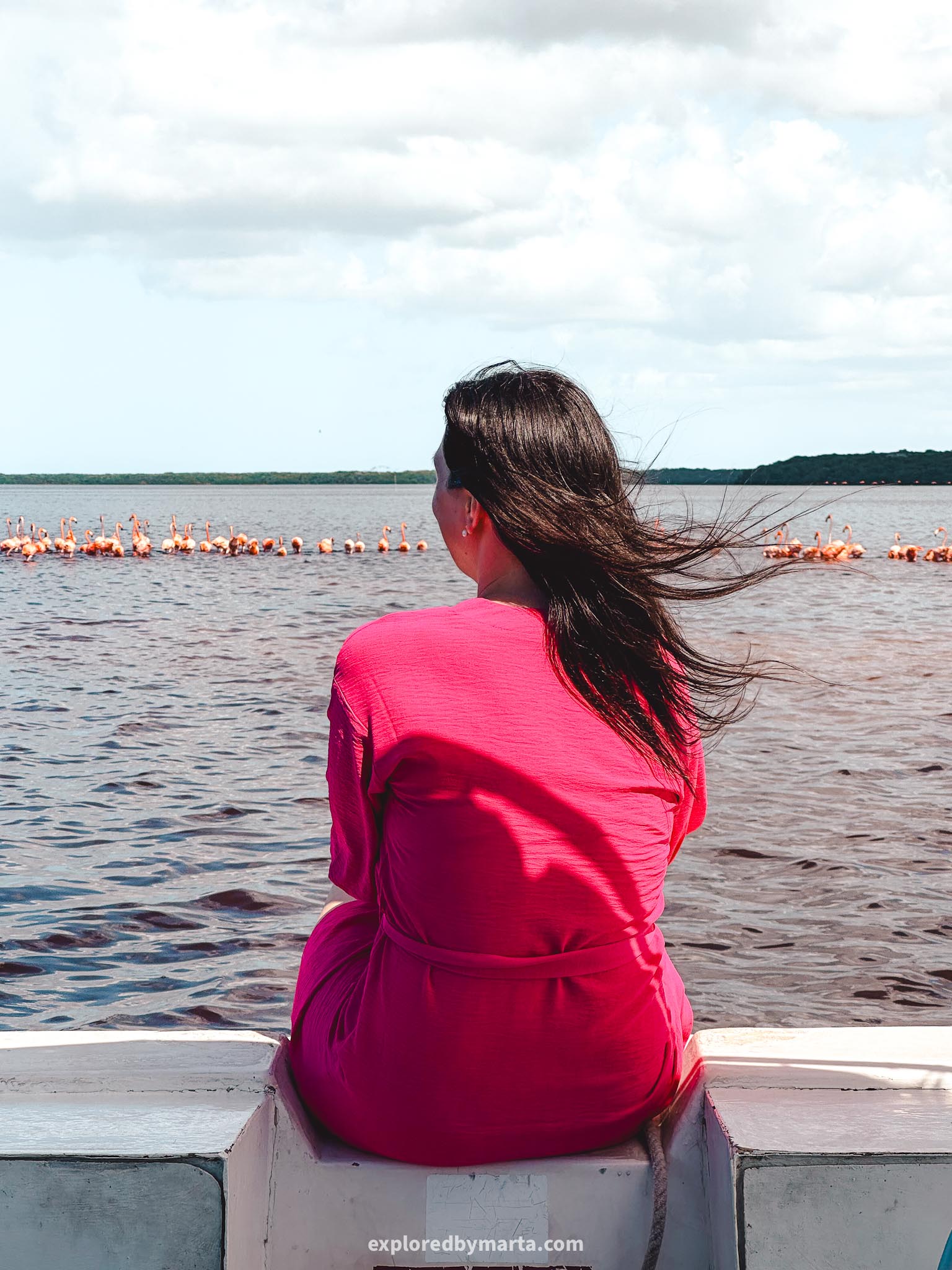
Flamingoes in Celestun live deep in the Ría Celestun Biosphere Reserve so you need a boat to get to see them. For that, you have to drive to Parador Turístico Celestún boat dock where they offer boat tours to see the flamingos.
When we visited, the cost for a small boat was 3000 pesos (~180 USD) and they allowed up to 6 persons on a boat. We wanted to split the cost so we found other tourists to share a boat but you can also go on your own.
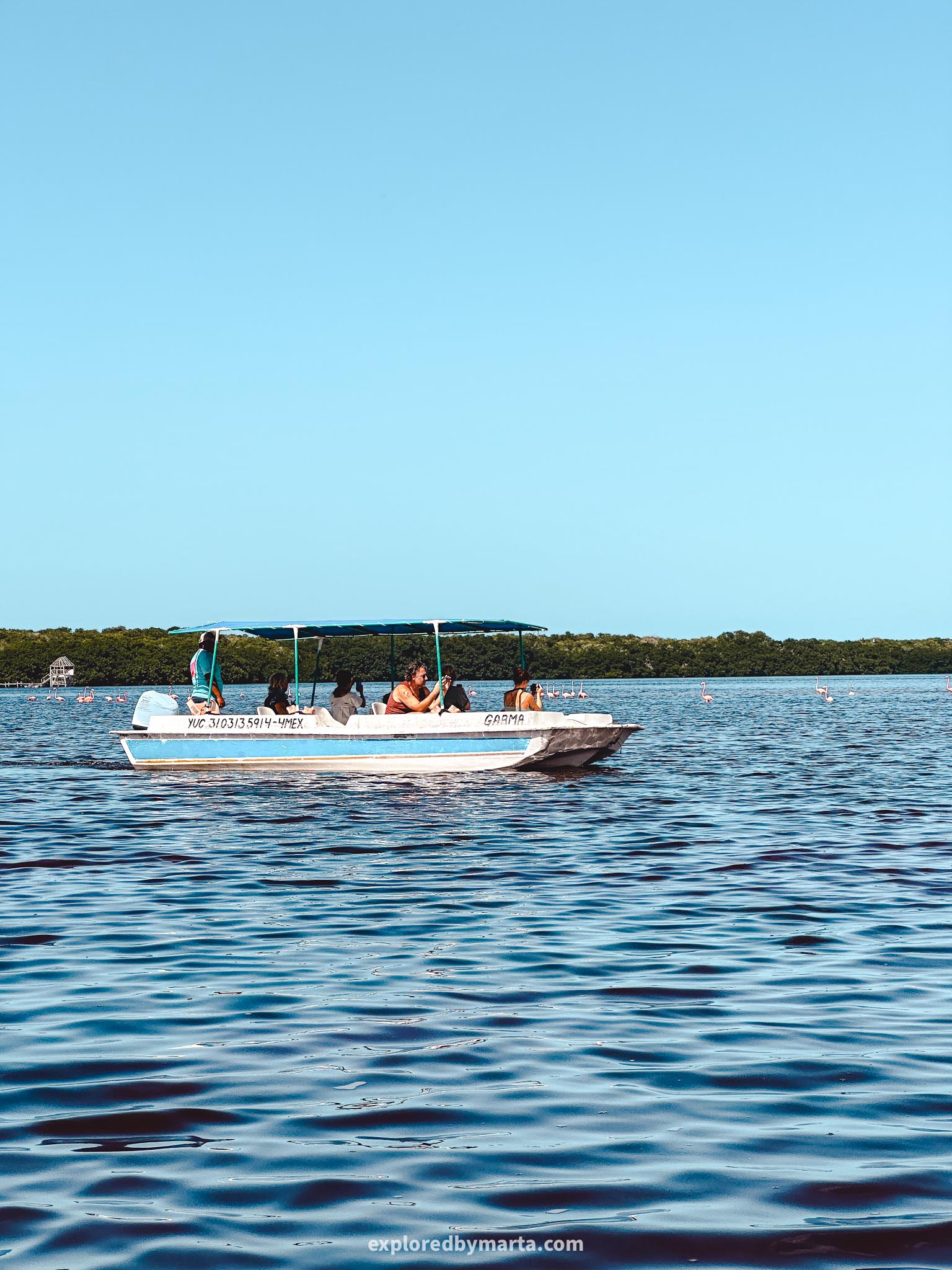

I recommend arriving sometime between 10 AM and 2 PM for the best chances to share a boat with others. We arrived at 12:15 PM and there were quite a few people already so it was easy to find a company. It was cash only!
The boat tour lasts about 1h to 1h 30min. They take you deep into the river and stop the boat near the flamingos. We saw thousands of them! Then they take you through a narrow mangrove tunnel to a beautiful cenote where you can swim.
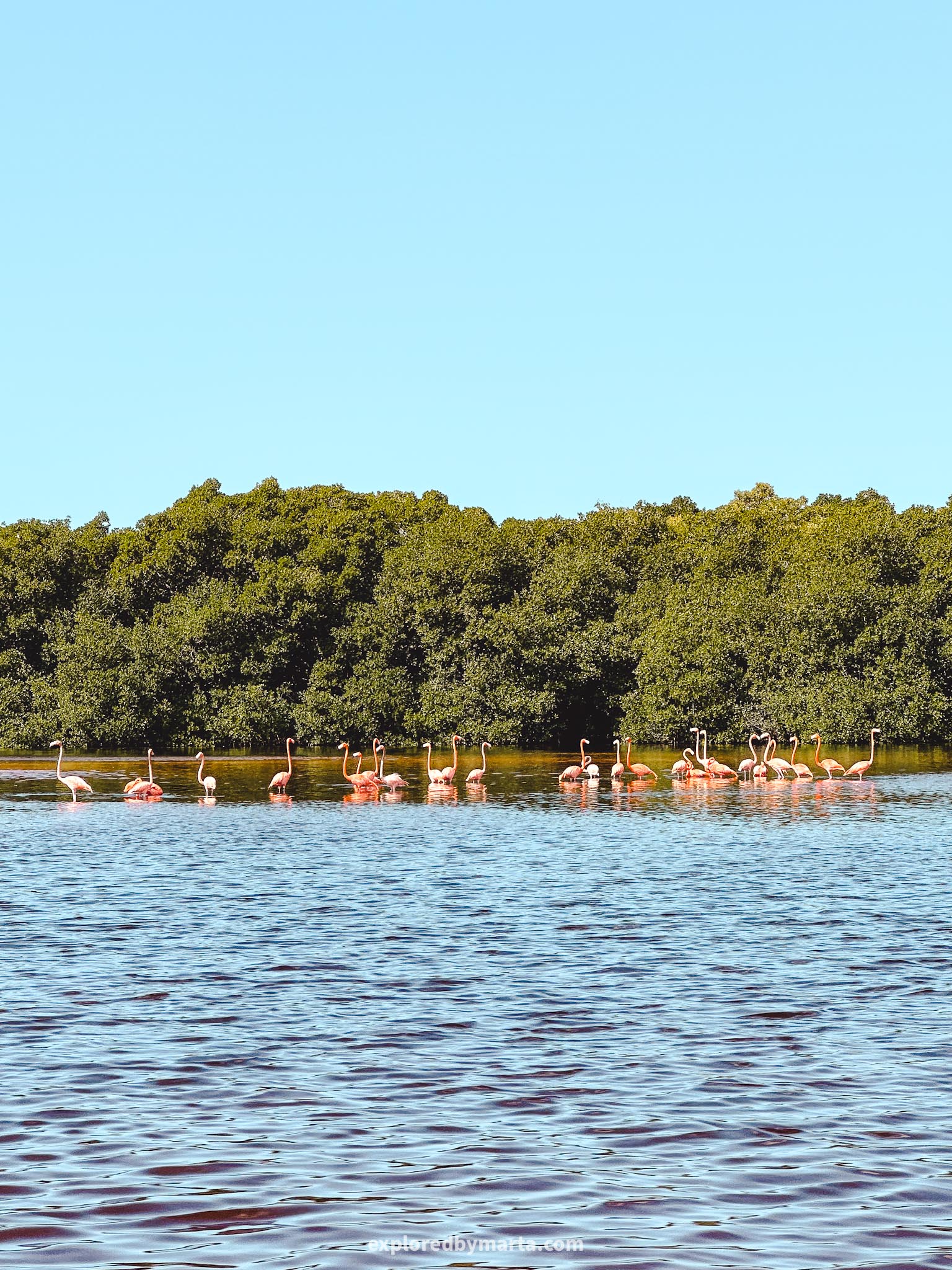
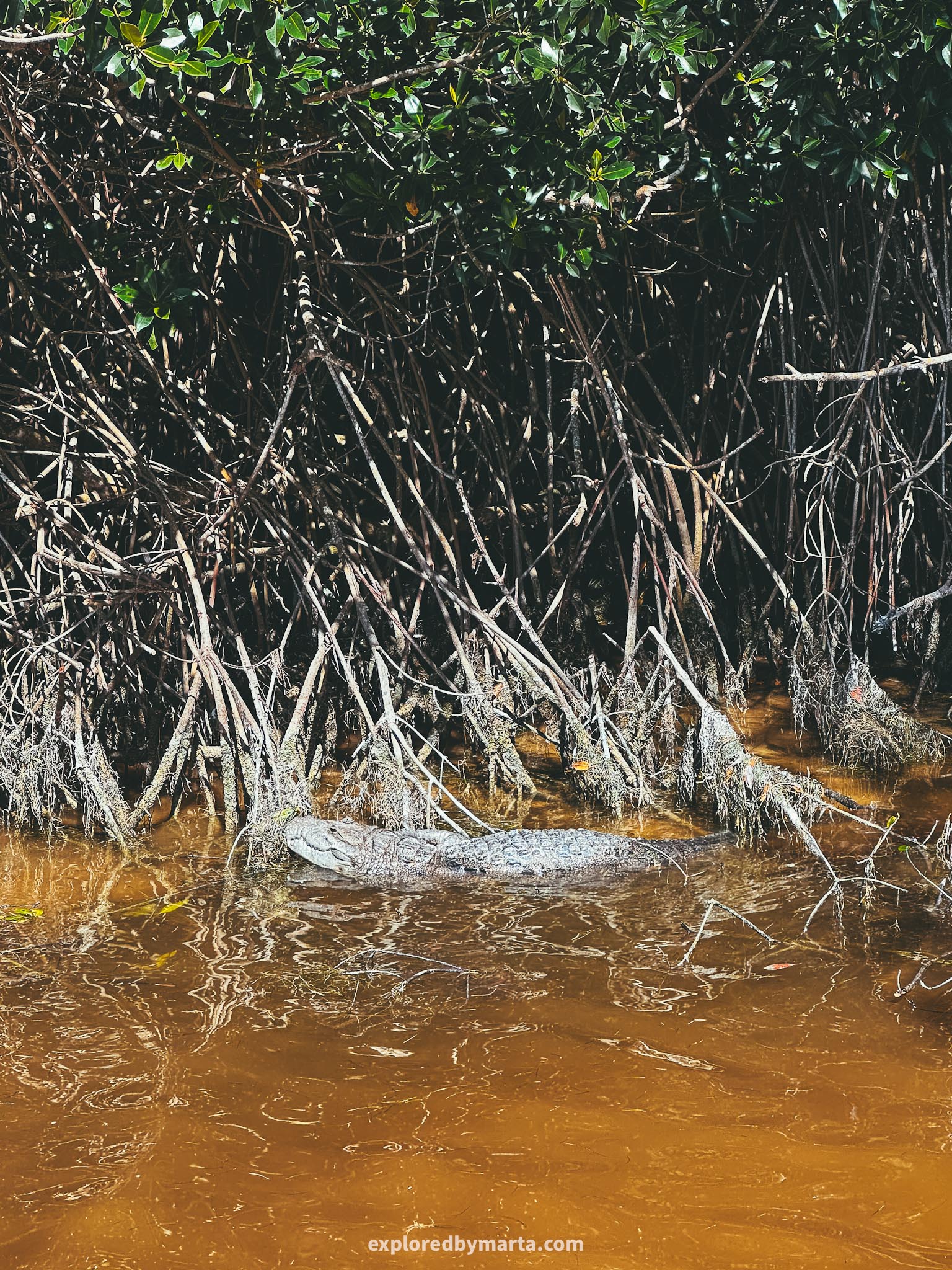
While we were there, some of our group went for a swim in the cenote only to find a small crocodile nearby the cenote, haha! Luckily it looked like it already had lunch and wasn’t interested in us at all. This was a fun trip and worth the price!
If you visit Merida, I recommend using this opportunity to travel to see the flamingos in Celestun. However, Río Lagartos tours will be much closer to Tulum. Just drive there and the boat tour guides will be waiting for you all around the small town!
Tip! Don’t forget to bring cash! Those remote places quite often don’t have ATMs or they are empty! Something between 1500 to 2000 pesos will be enough for a guided tour.
Location: Parador Turístico Celestún – Río Lagartos tours
17. Capital of the state of Yucatán – Merida
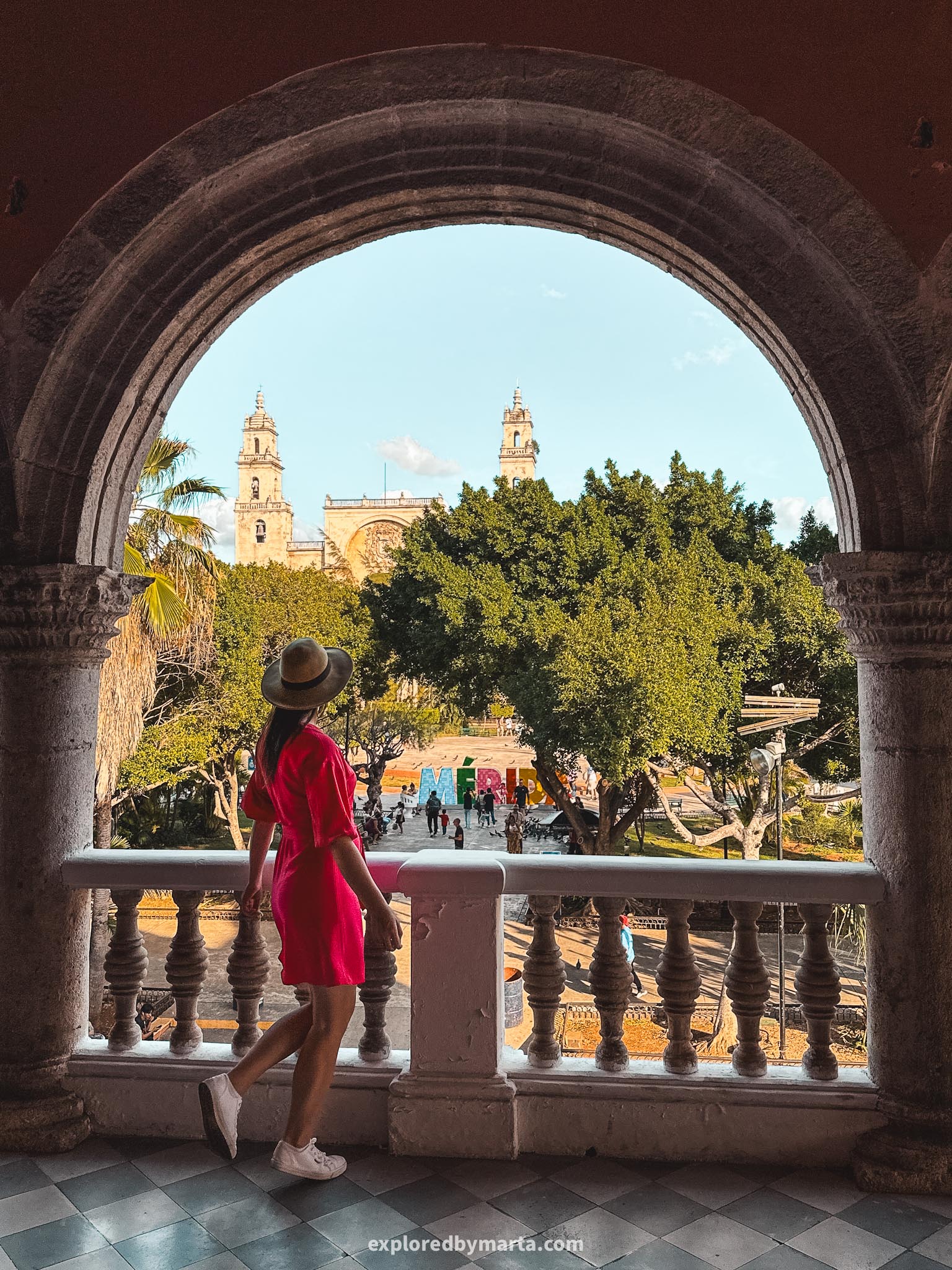
Founded in the 16th century, Merida, or the White City, serves as the capital of the state of Yucatán. It was also the first American Capital of Culture and is home to the oldest cathedral in mainland Americas! See all the things to do in Merida here!
Merida is the perfect place to explore the Mayan culture, local Mexican lifestyle as well as colonial history through archaeological zones, food, local markets, and diverse architecture in and around the city.
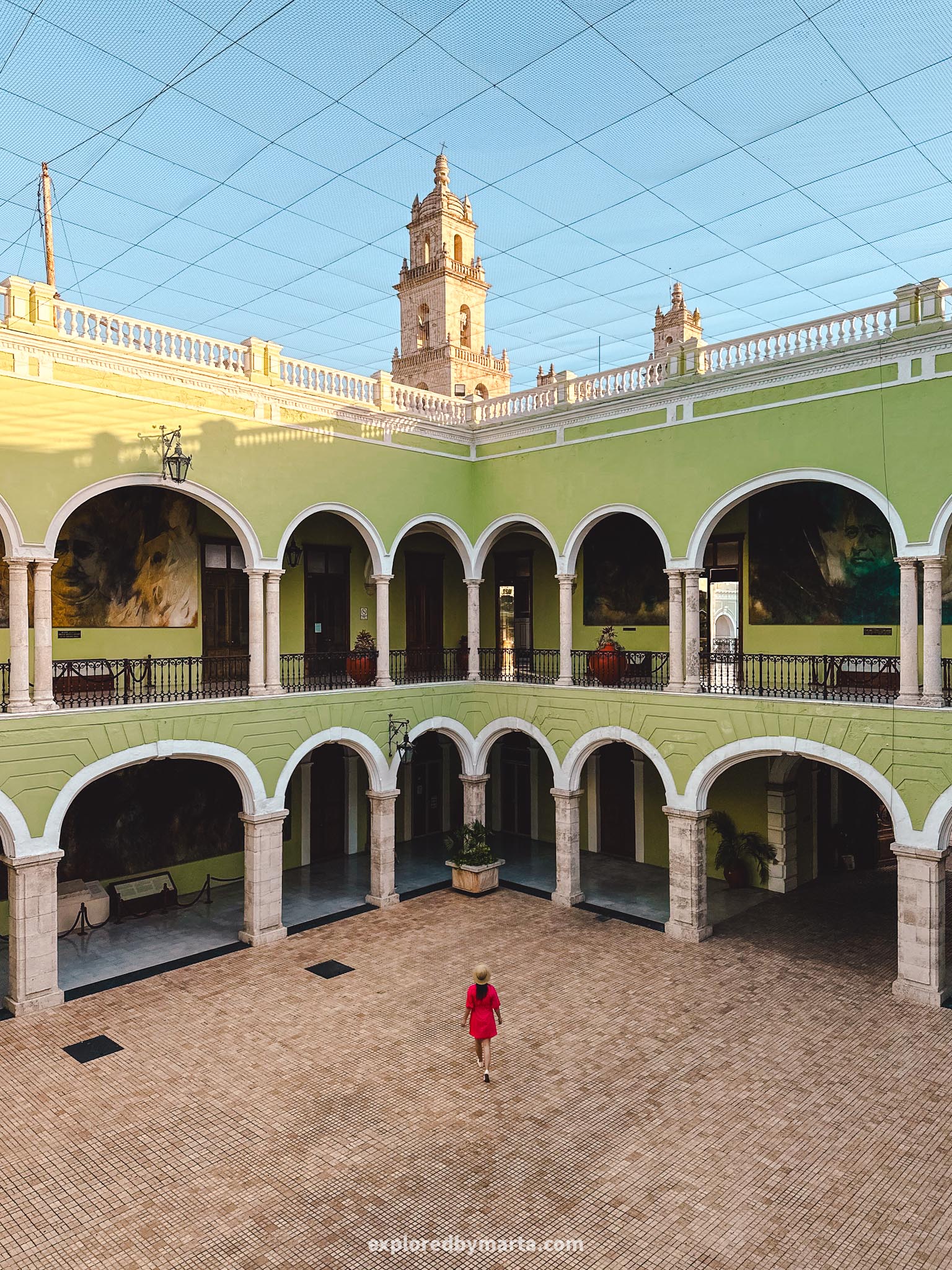
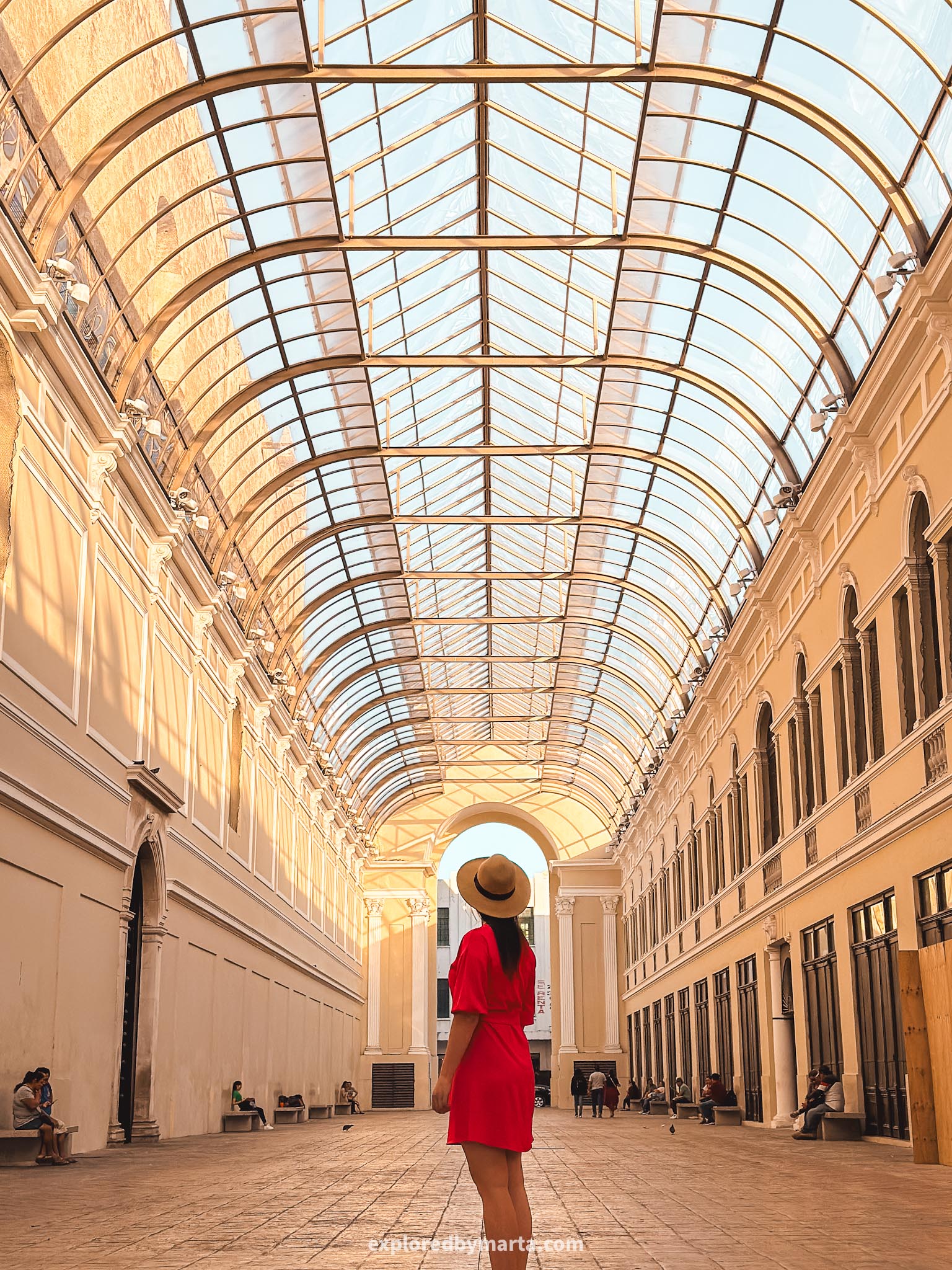
The number one must-visit place in Merida is Plaza Grande or the main square that hosts special events like the popular Mayan ball game ‘Pok Ta Pok’ which you can see every Saturday around 8 PM for free.
Lined around the square are the best places to visit in Merida – the Cathedral of Mérida, the Pasaje de La Revolución, the red Palacio Municipal de Mérida, the green palace – Palacio de Gobierno, and Museo Casa Montejo – house of the founder of Merida!

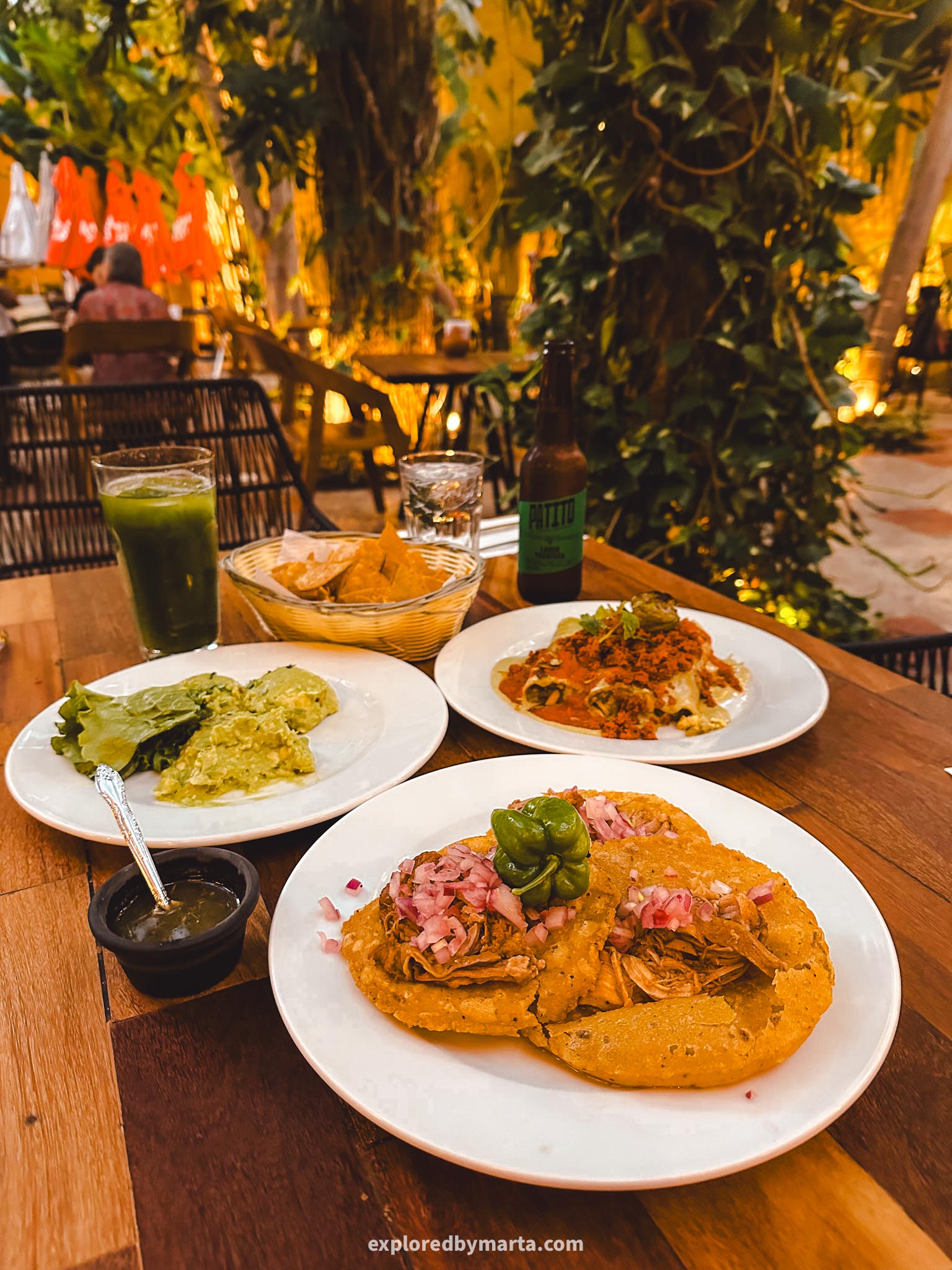
Merida is also a hub of Mayan gastronomy and Mexican cuisine. You must stop by some taco places like Taqueria La Lupita and Manjar Blanco – taco spots that were featured on Netflix’s Taco Chronicles.
As for gastronomy, you have to try Mayan dishes at either one of the best restaurants – La Chaya Maya or at the Museum of Yucateca Gastronomy, which is a restaurant with a small exhibition. Try dishes like salbutes, sopa de lima, or pollo pibil!
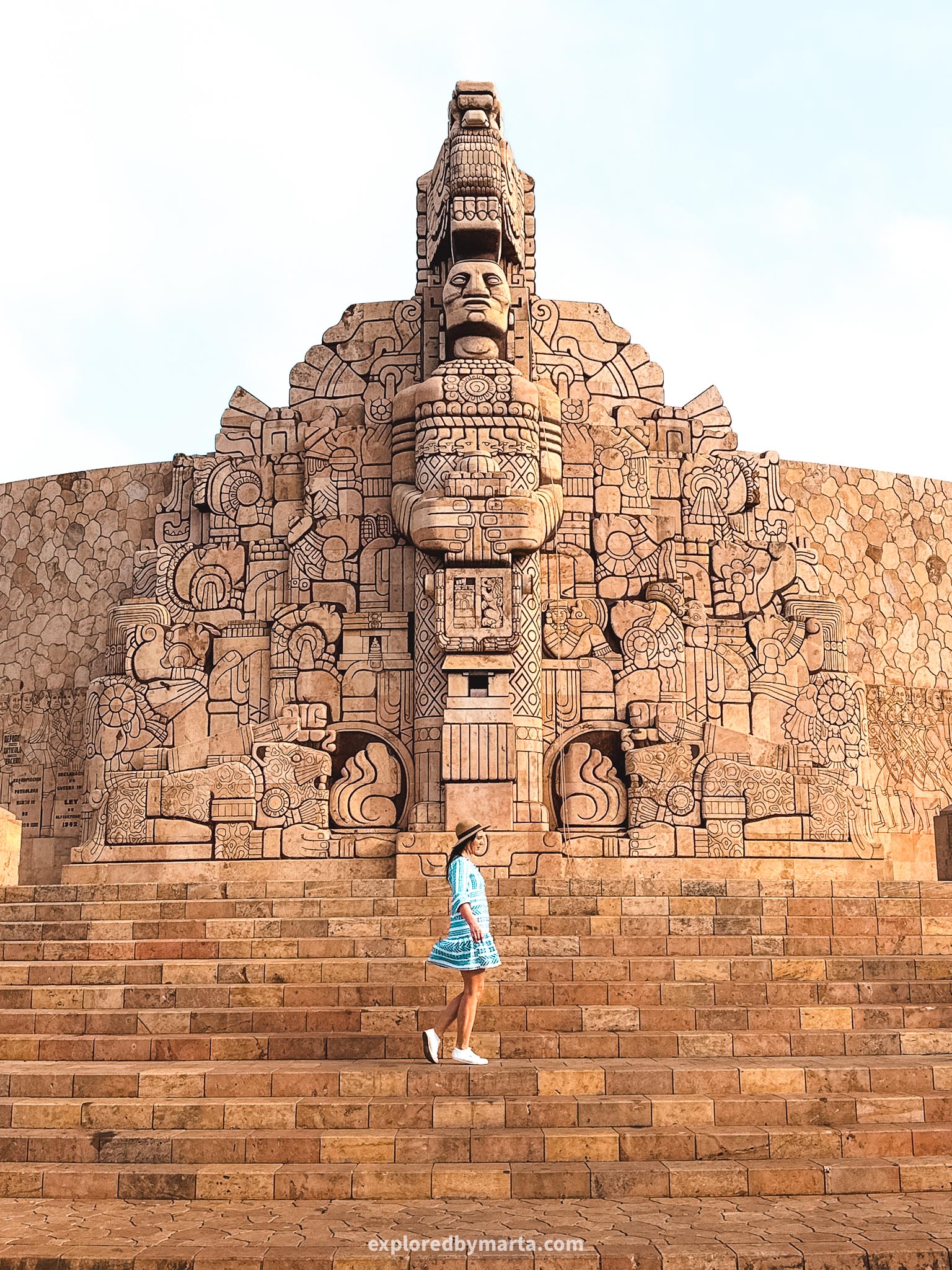
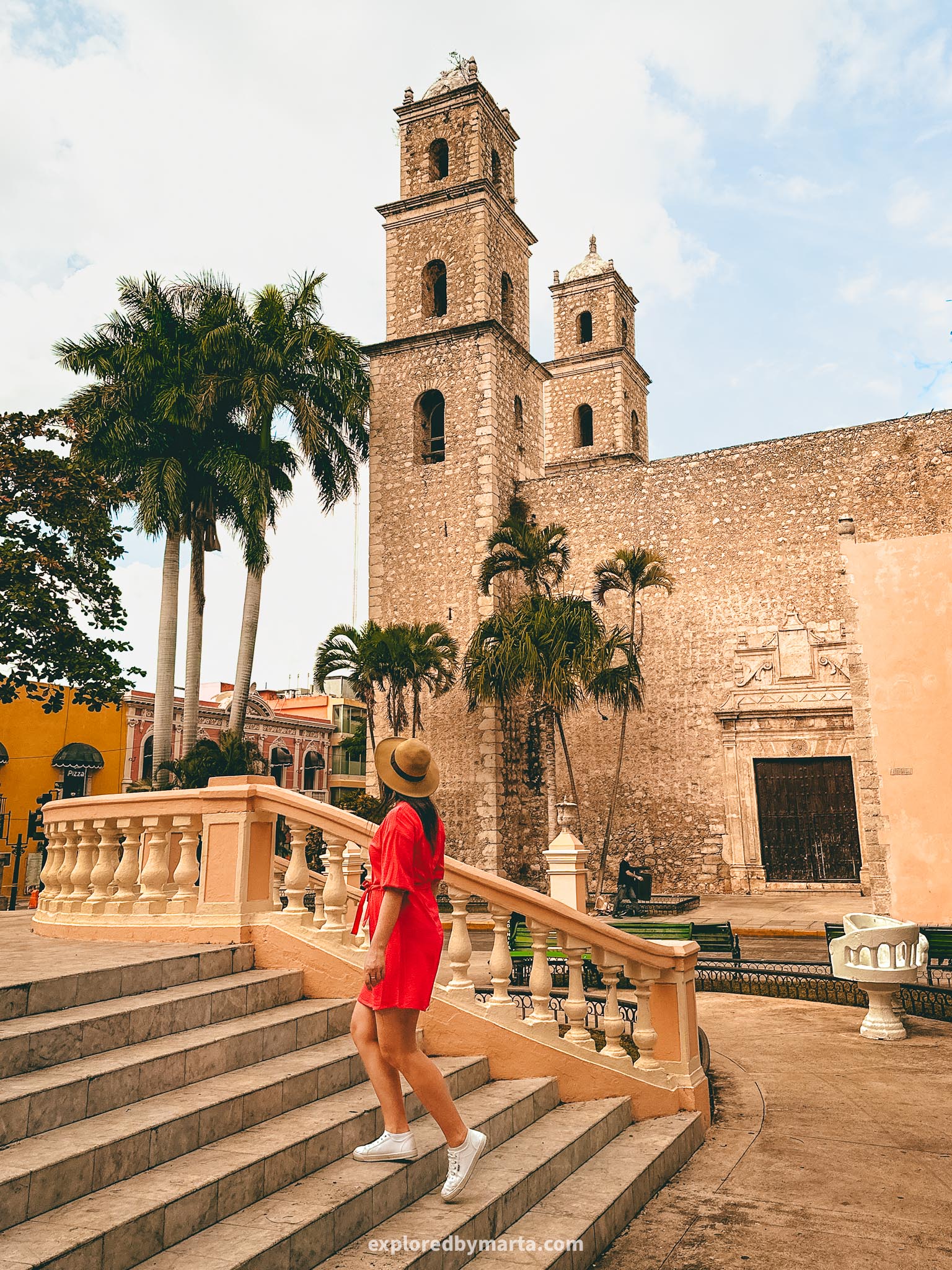
As you wander the historic center, spot some of the remaining historic arches, enjoy the smells and flavors at Mercado San Benito, and see some of Merida’s photo-perfect parks like Parque de los Hidalgos or Parque de Santa Lucia with its ‘Sillas Tu y Yo’ chairs!
If you really want to stretch your legs, go to the famous Paseo de Montejo and walk down the French-inspired Montejo Walkway with its splendor of 19th-century colonial architecture until you reach Monumento a La Patria – one of Merida’s landmarks!
Location: Plaza Grande of Merida
18. Holbox – the quintessential tropical island

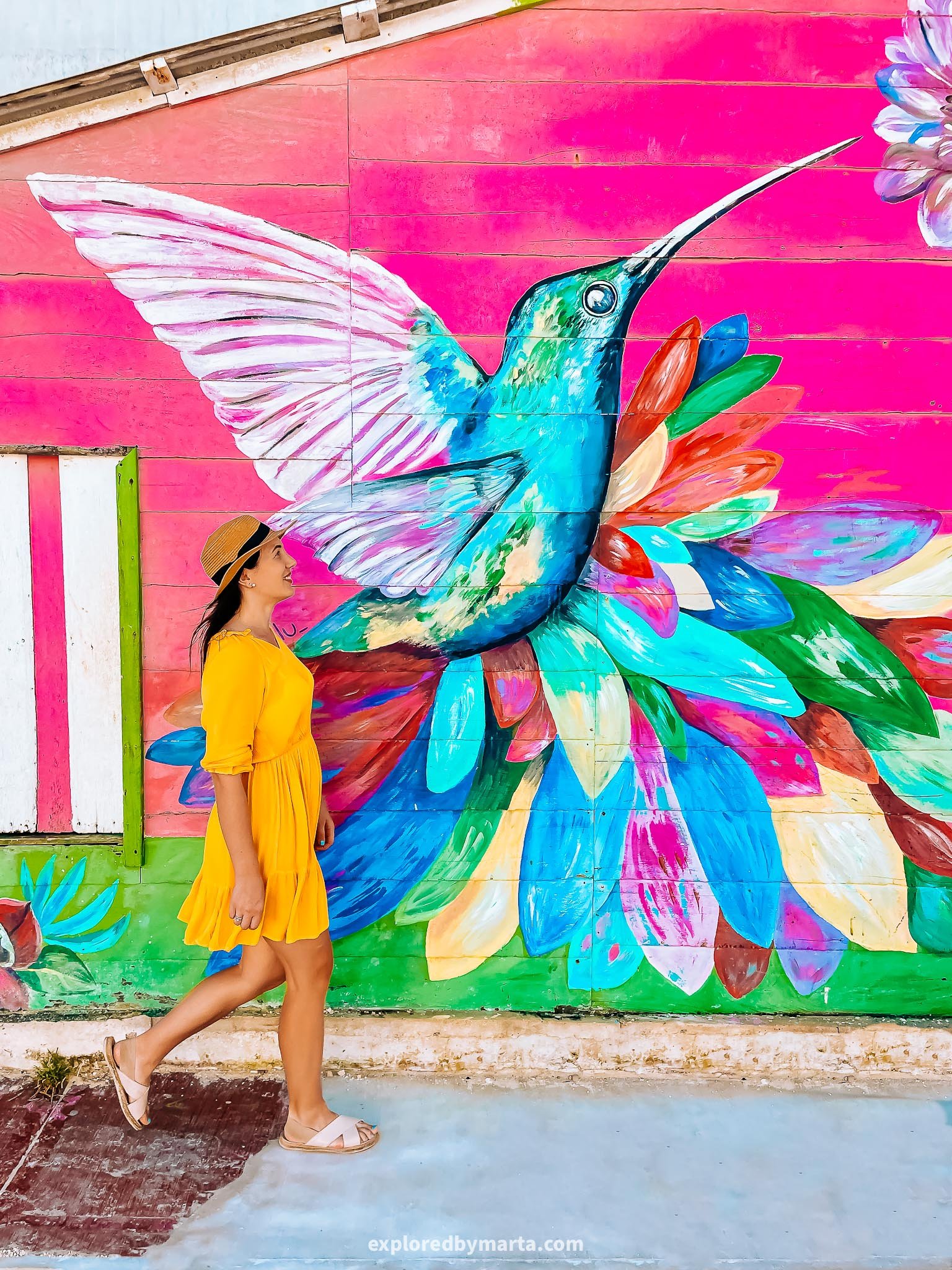
Holbox is the quintessential tropical island with turquoise water and fine white sand where you wander around barefoot and drink coconuts under palm trees! It is the place to be to enjoy that authentic Mexican fishing village life!
We have visited Holbox multiple times because we like it so much! To get there you need to get to the coastal village of Chiquilá and then take a ferry to the island of Holbox. There are two ferry companies departing every 30 to 60 minutes.
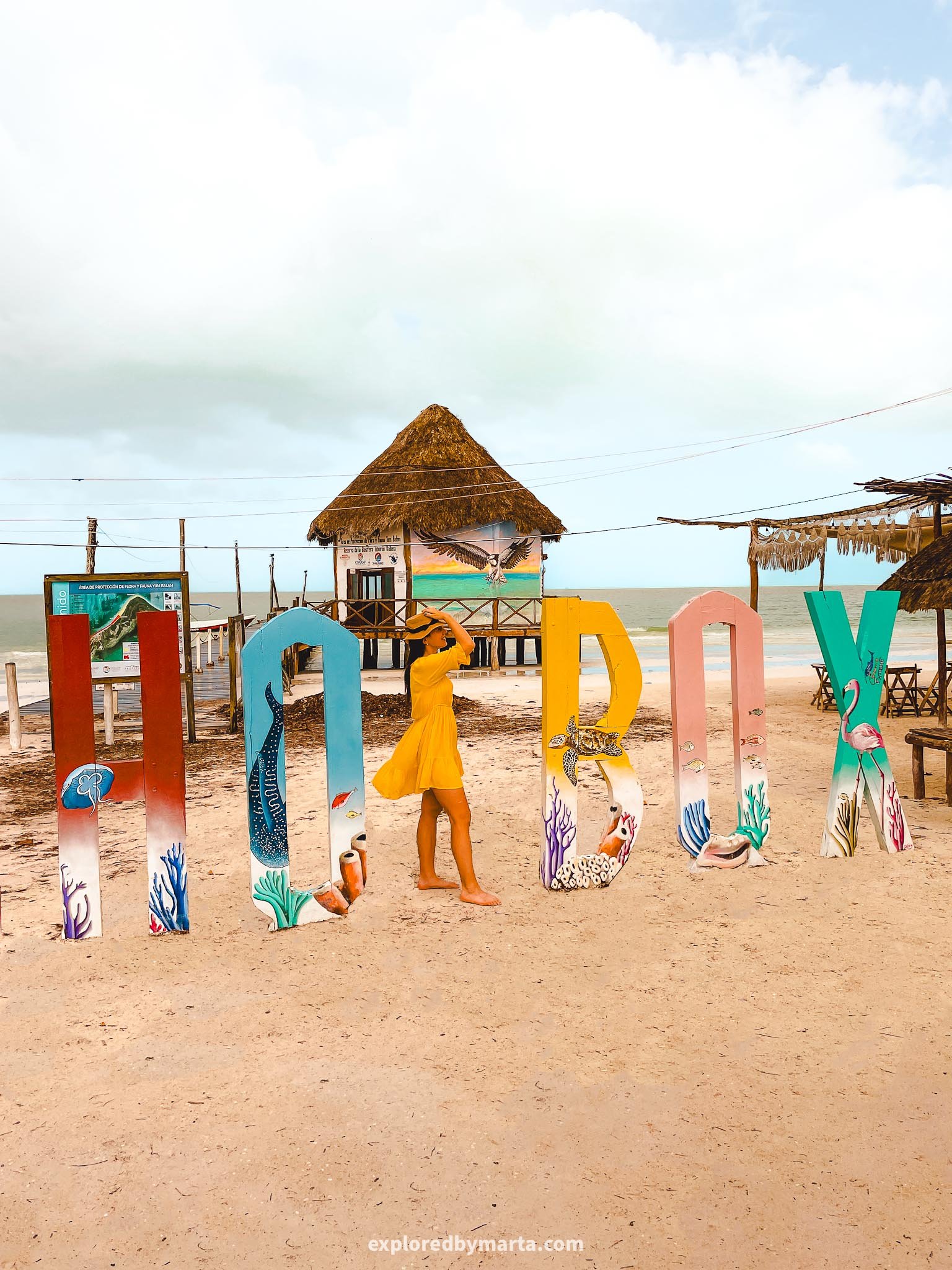
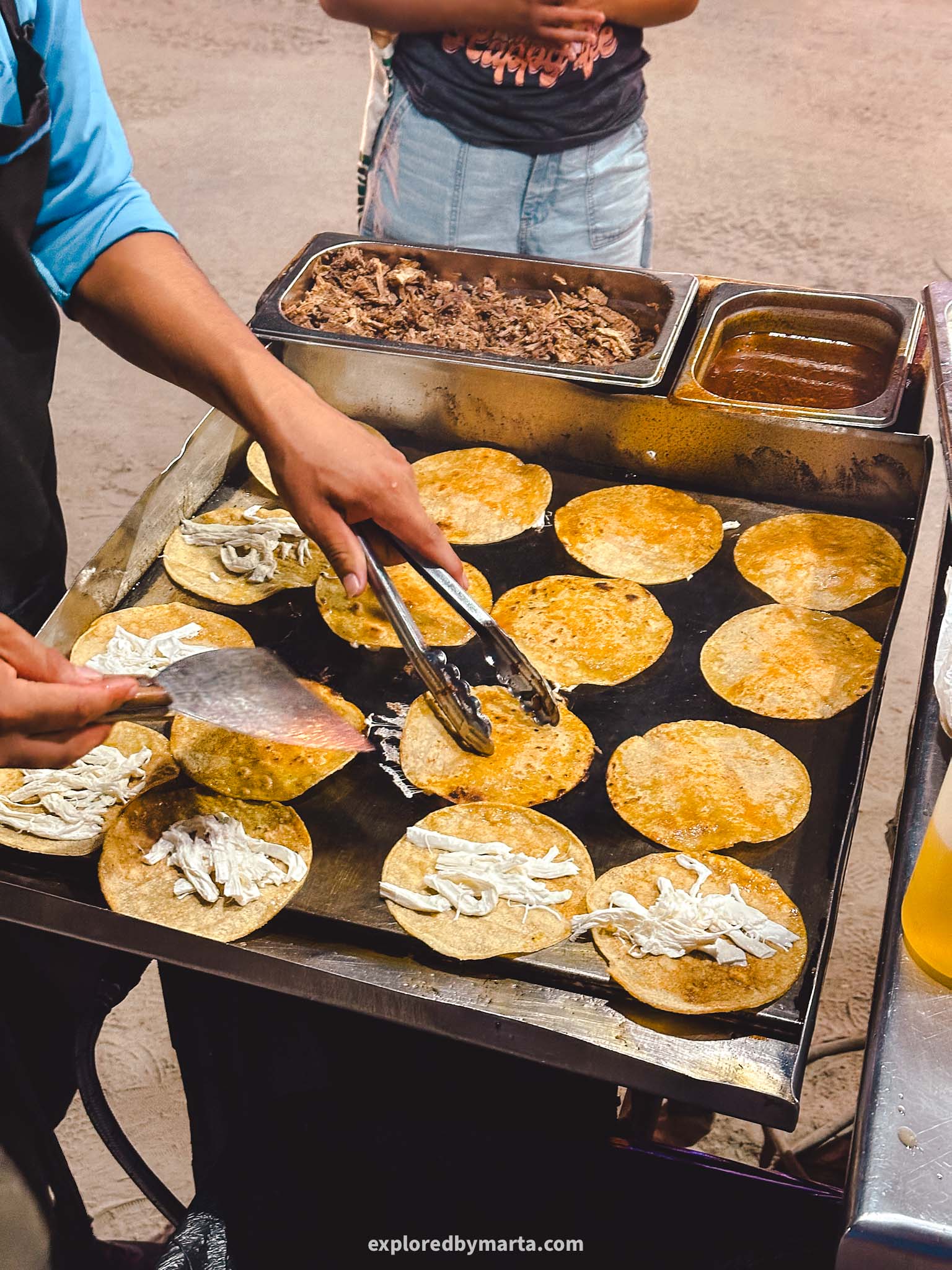
Although we traveled there by our rental car and left it in one of many long-term parking lots in Chiquilá while we stayed on the island, you can very easily get there by one of many minibus taxis or public buses.
Holbox is a unique island with unpaved streets, people walking around barefoot, full of golf cart taxis buzzing around, and no cars allowed for tourists. Occasional power outages are a thing here and street-wide water puddles after storms, too.
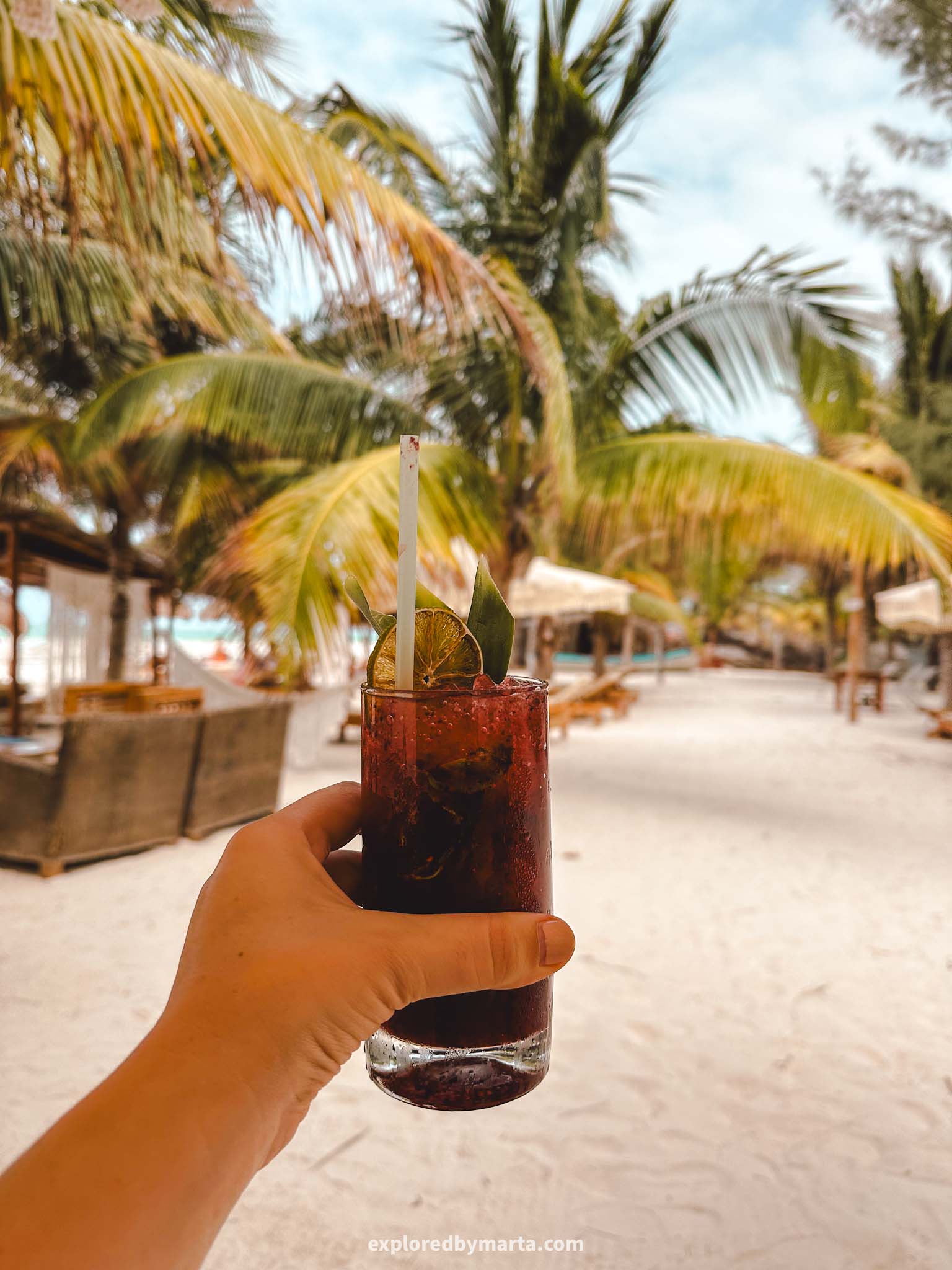

On the island, explore the hustle-bustle of Holbox Central Park, and don’t forget to go there in the evening to try some Mexican street foods prepared in one of many street food stalls!
Then enjoy the gorgeous Playa Holbox beach with fine white sand and shallow turquoise waters. For beach clubs, I recommend Restaurante La Playa De Ñaña restaurant and beach club.


If you stay there the night, consider joining everyone on a sandbank morning walk to Punta Mosquito – a popular activity on the island. Read more about other bucket list things to do in Holbox.
Another unique experience to do in Holbox is a bioluminescence tour in the evening after dark. It was one of my highlights from Holbox. One of the must-try foods in Holbox is the local legend – lobster pizza, a famous dish on the island.
I also recommend checking out the street of street art in Holbox and watching the sun go by in the Caribbean Sea at Playa Punta Cocos. It was pretty mesmerizing but mosquitoes are a thing here so bring repellent with you!
Location: Holbox
19. Uxmal Archaeological Zone and Ruta Puuc route
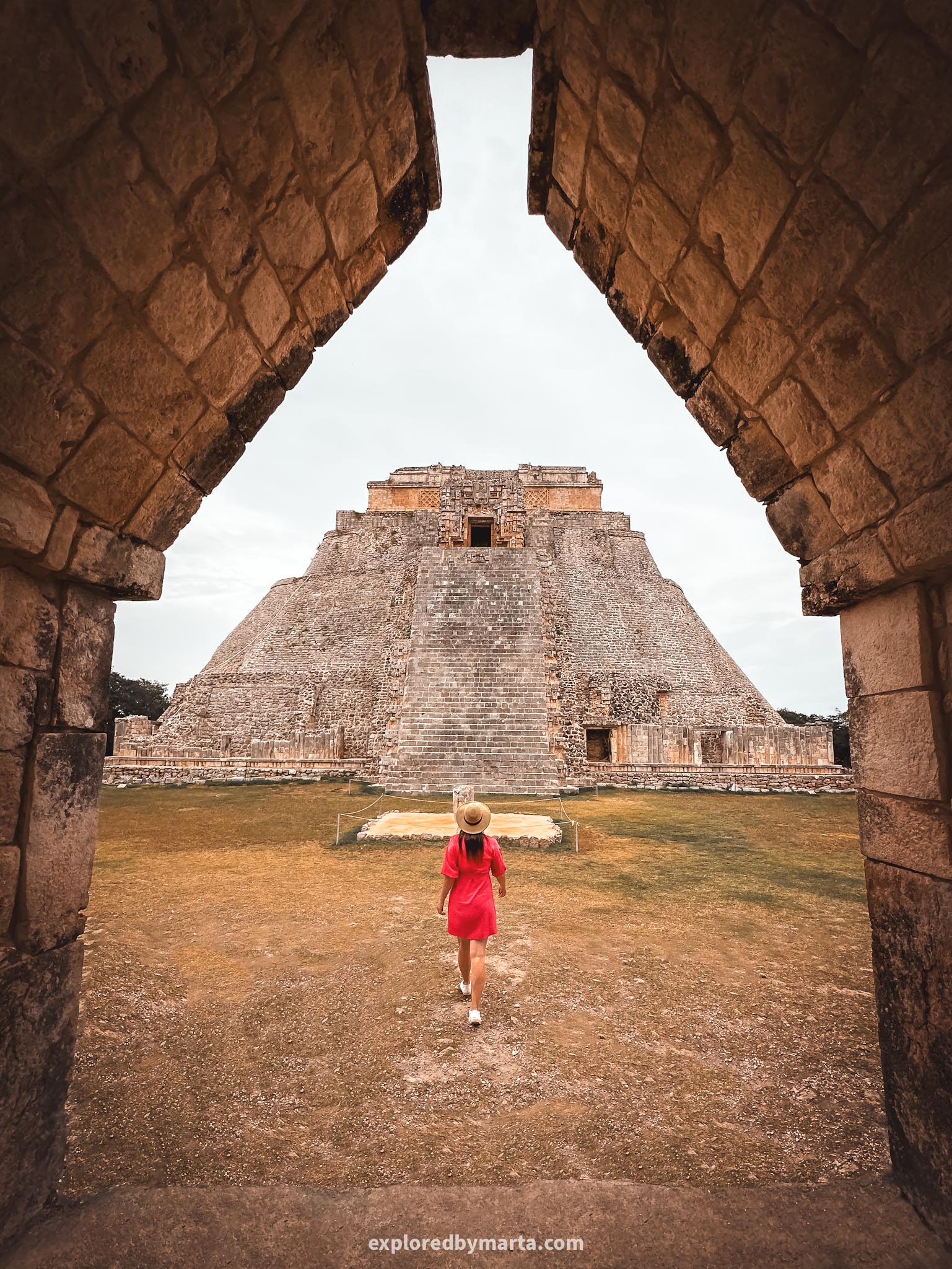
Just a 1-hour drive South of Merida or about a 4-hour drive from Tulum is a group of five different Mayan archaeological zones called the Ruta Puuc route. The most famous one is Uxmal, which is often regarded as more beautiful than Chichen Itza.
If you travel from Tulum, it will be best to make this a weekend trip with an overnight stay in Merida.
Why Ruta Puuc? Ruta Puuc is a group of special Mayan ruins in Yucatán featuring the Puuc architectural style. Puuc means ‘hills’ in the Mayan language and is also the name of the region South of Merida where all these ruins are located.

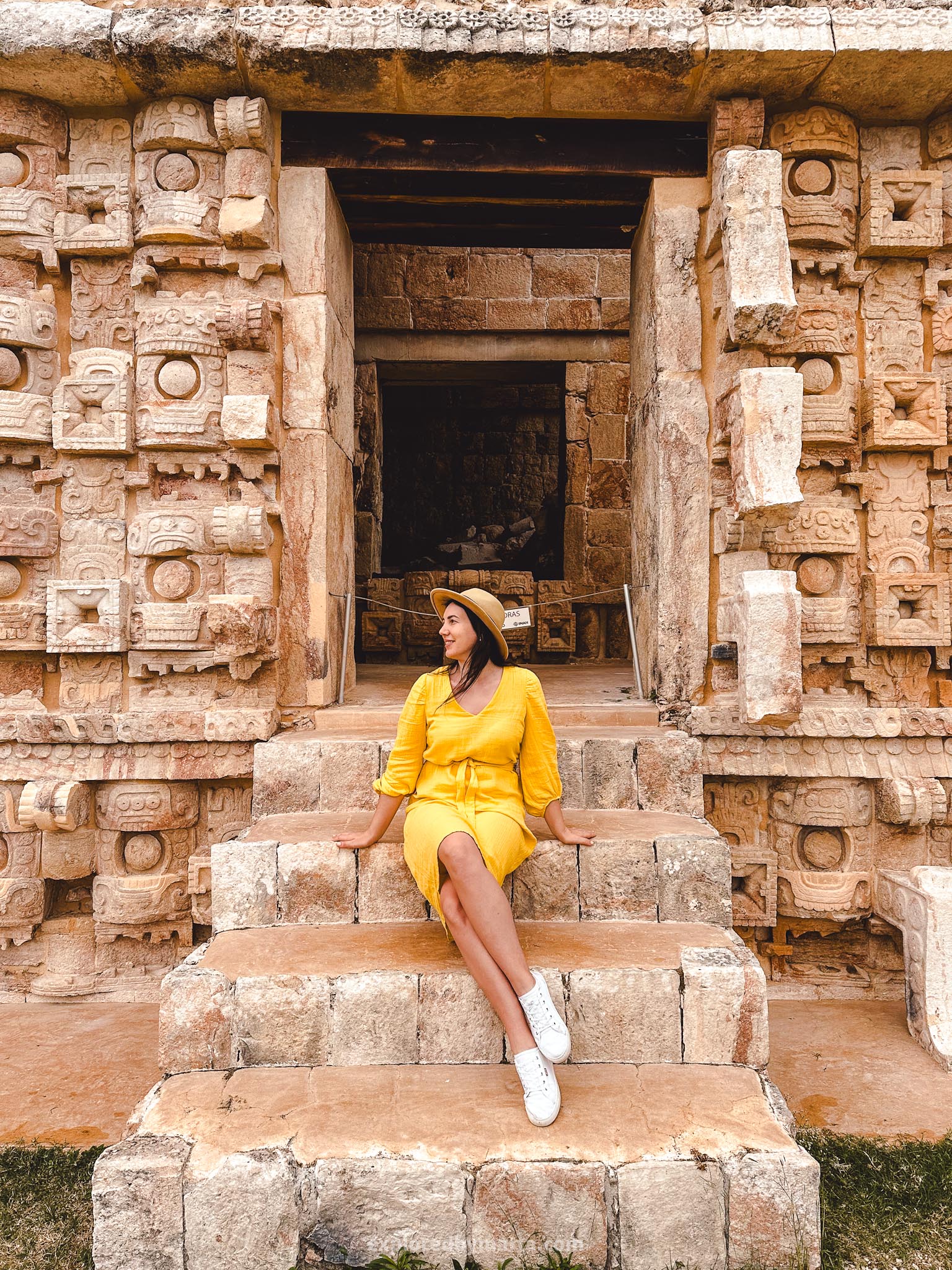
Puuc architecture usually displays stone mosaics, geometrical elements, and elaborate sculptures, e.g., it often features masks of the long-nosed rain god Chaac. It also features stone arches in unique shapes (see the frame in the first photo).
Uxmal with its famous Pyramid of the Magician is amongst the most impressive Mayan ruins in Mexico. The whole archaeological zone is listed as a UNESCO World Heritage Site due to its significance.
Uxmal at its peak was a city of 25 thousand people so the pyramid is not the only impressive building here. Don’t forget to check out The Governor’s Palace located on a hill, Casa de las Palomas as well as the Nunnery Quadrangle!
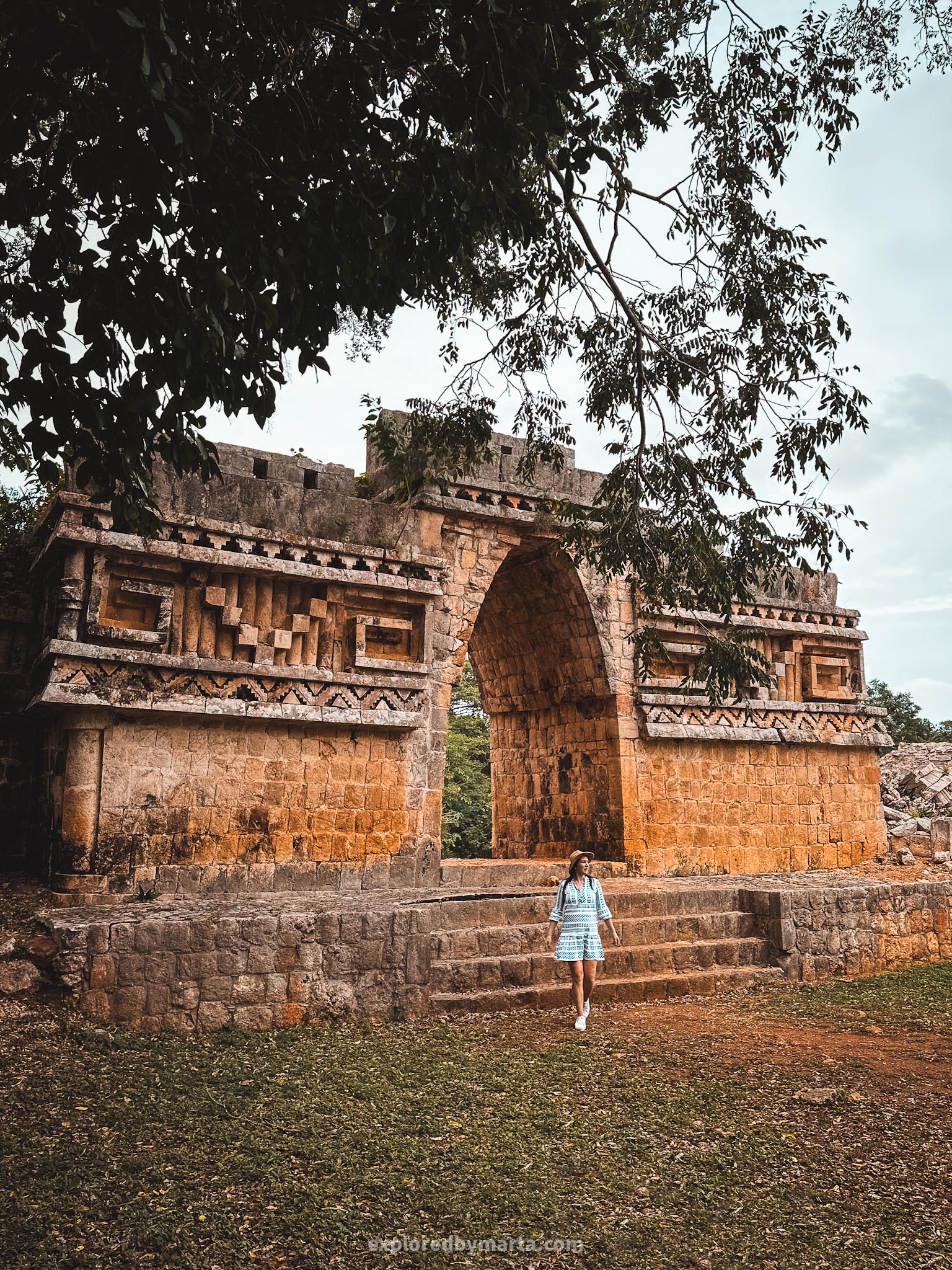
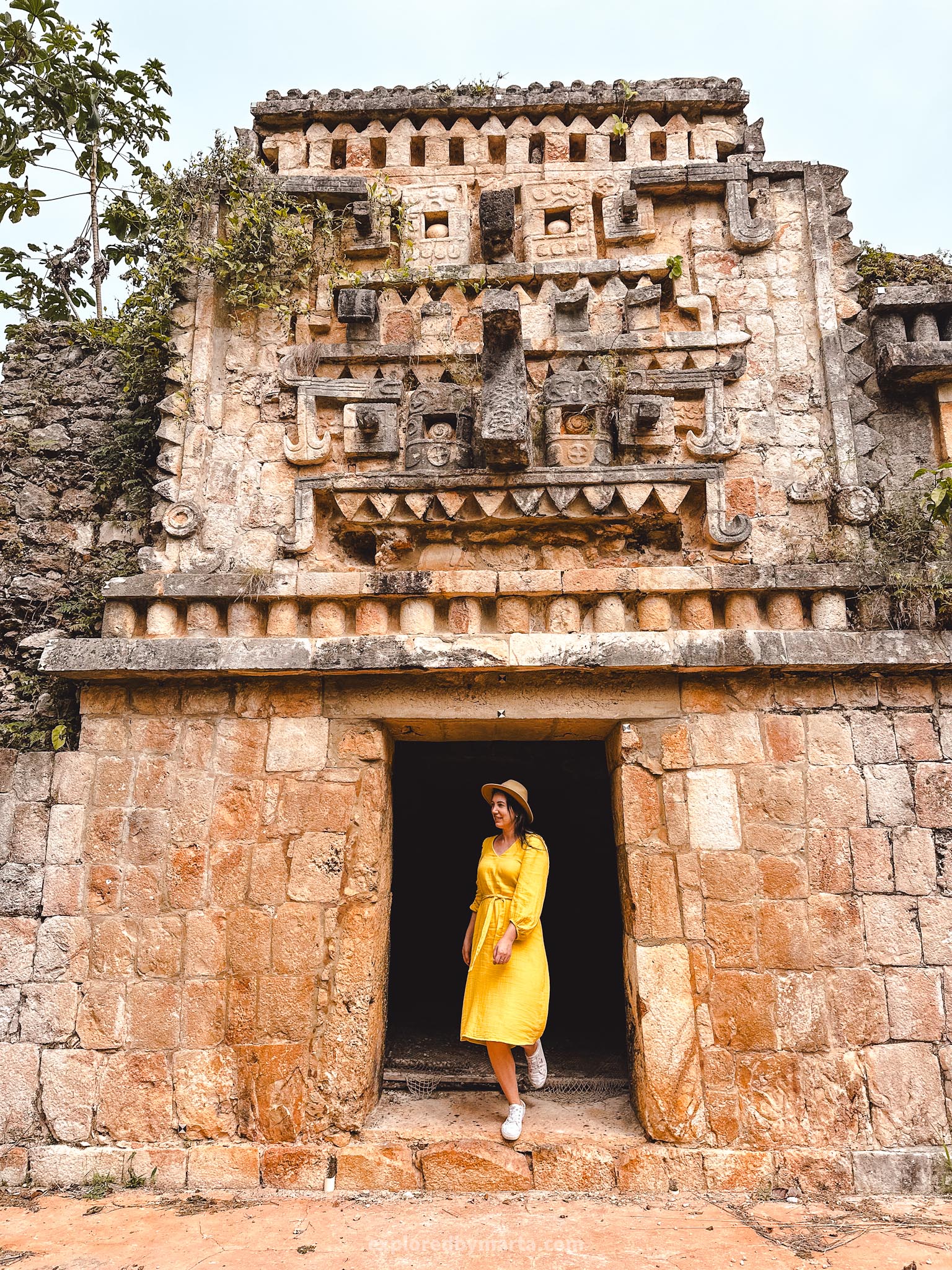
Other archaeological zones along Ruta Puuc include the archaeological zone of Kabah, the archaeological zone of Sayil, the archaeological zone of Xlapak, and the archaeological zone of Labná (my favorite after Uxmal).
If you only have time for one place, then go to Uxmal, which is one of the most beautiful places in the Yucatán Peninsula. If you have to skip some of those places, I’d choose Xlapak and Sayil as my least favorite of all.
For more photos and descriptions of the Ruta Puuc archaeological zones, you can go to my blog post about the best Mayan ruins near Merida. It will be essential to arrive early at Uxmal to skip crowds and leave enough time to see the rest of the Mayan ruins.
Location: Uxmal – Kabah – Sayil – Xlapak – Labná
20. Puerto Morelos
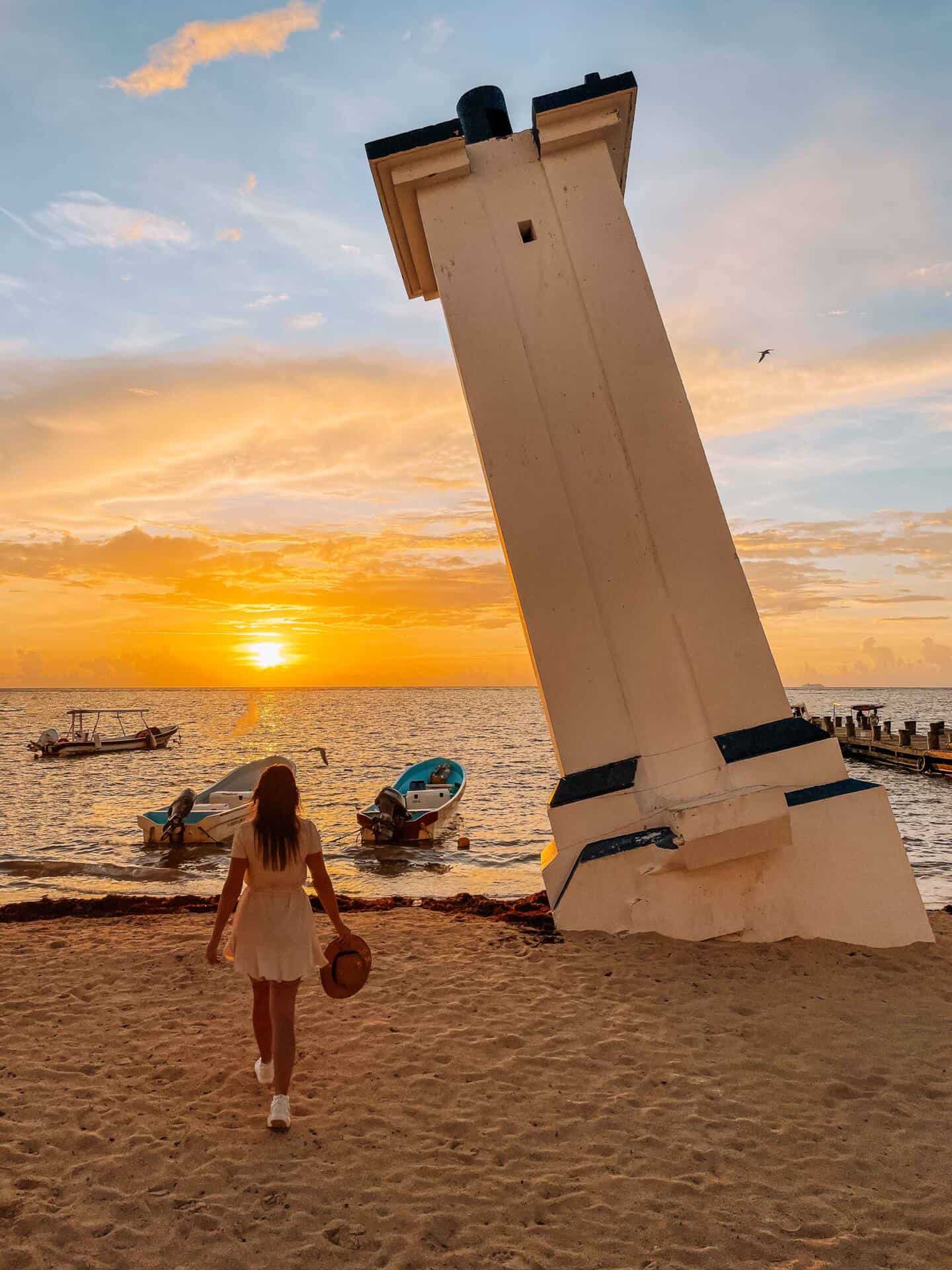
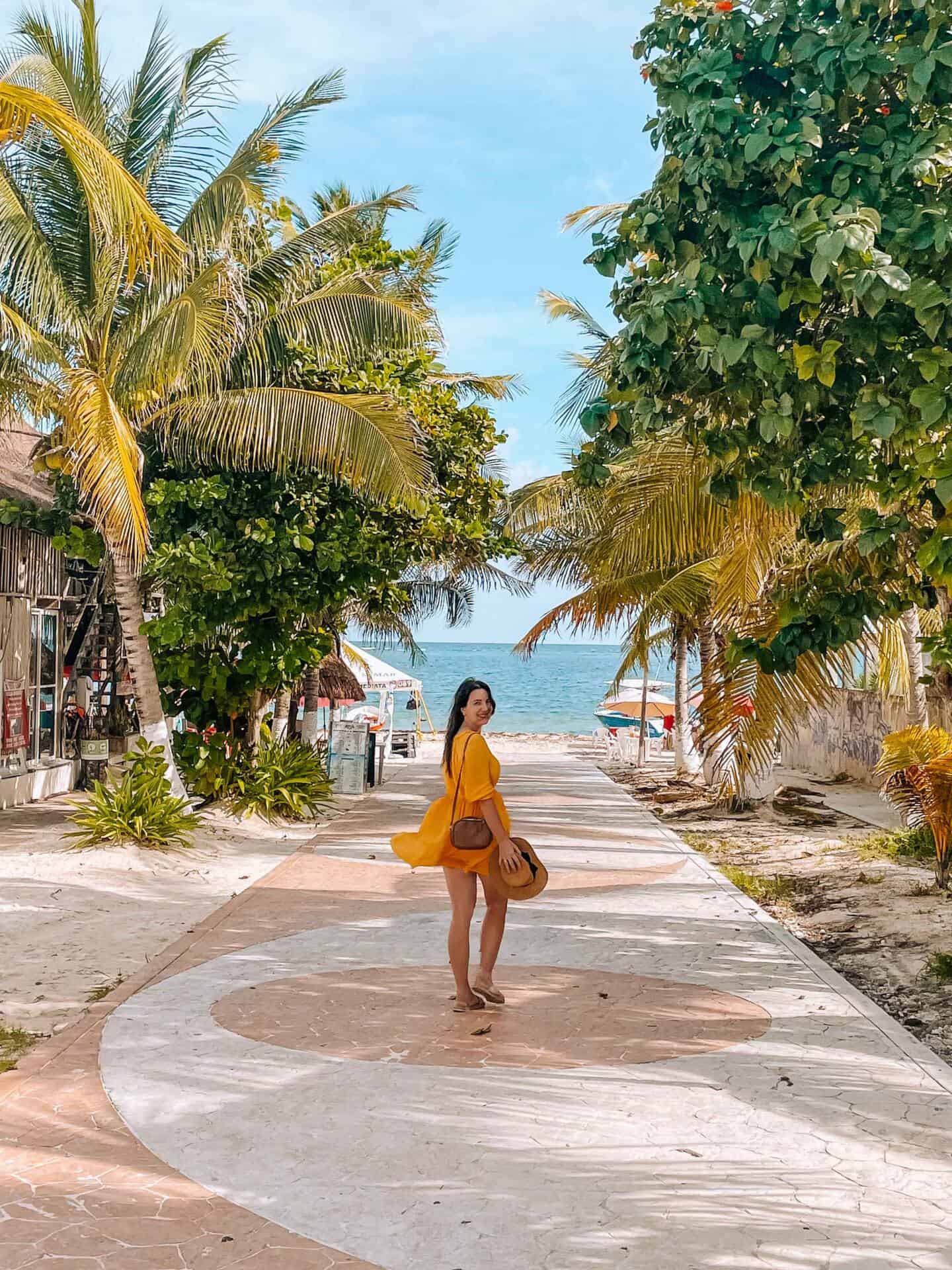
Puerto Morelos is a great destination for a day trip from Tulum for those looking to escape the hustle and bustle of the city and spend some more quiet time at a charming authentic fishing village on the shores of the Caribbean.
One of the biggest reasons to go to Puerto Morelos is that there is a wonderful long white sand beach that is easily accessible from the town center. And not a single hotel is blocking the access to the tranquil tropical beaches (ahem, Tulum!).
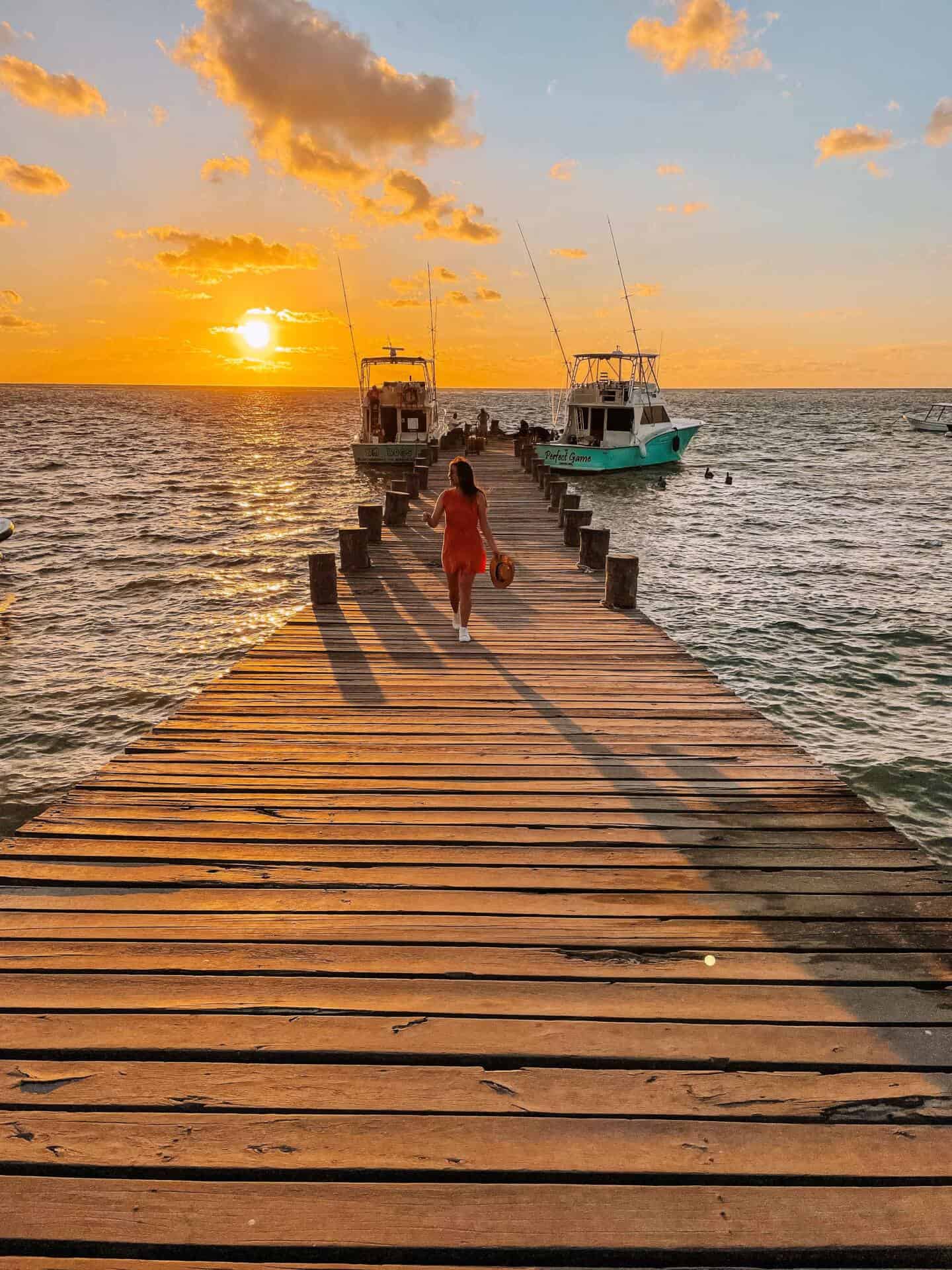
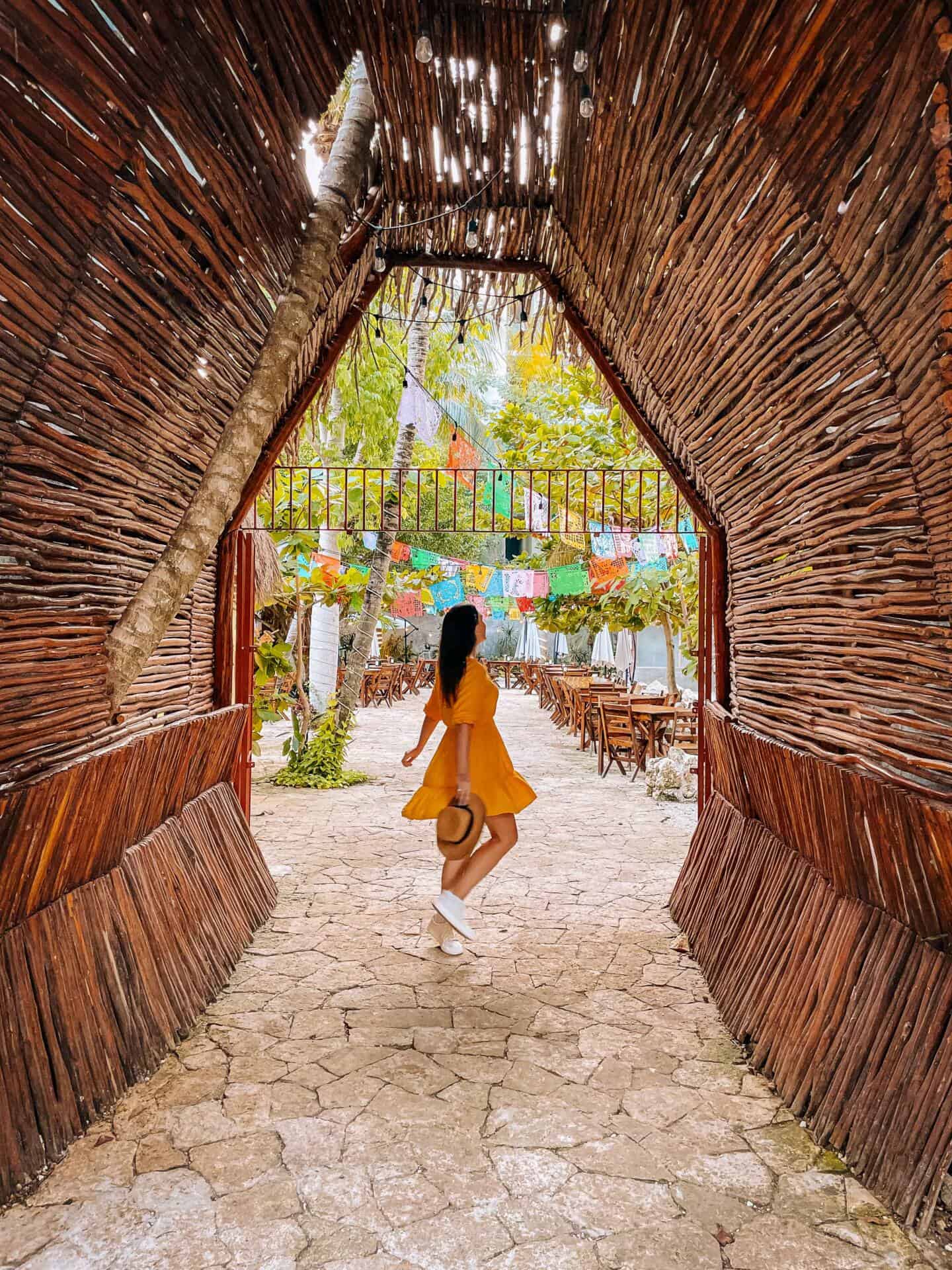
Some of the must-do things to do in Puerto Morelos include visiting the iconic Leaning Lighthouse of Puerto Morelos, checking out the local food scene, enjoying the crowd-free beaches, and a snorkeling trip to the barrier reef.
By the way, Puerto Morelos is home to the National Reef Park, one of the best-preserved stretches of the Mesoamerican Barrier Reef, so this is one of the best places for snorkeling or diving activities in the whole Yucatan peninsula.
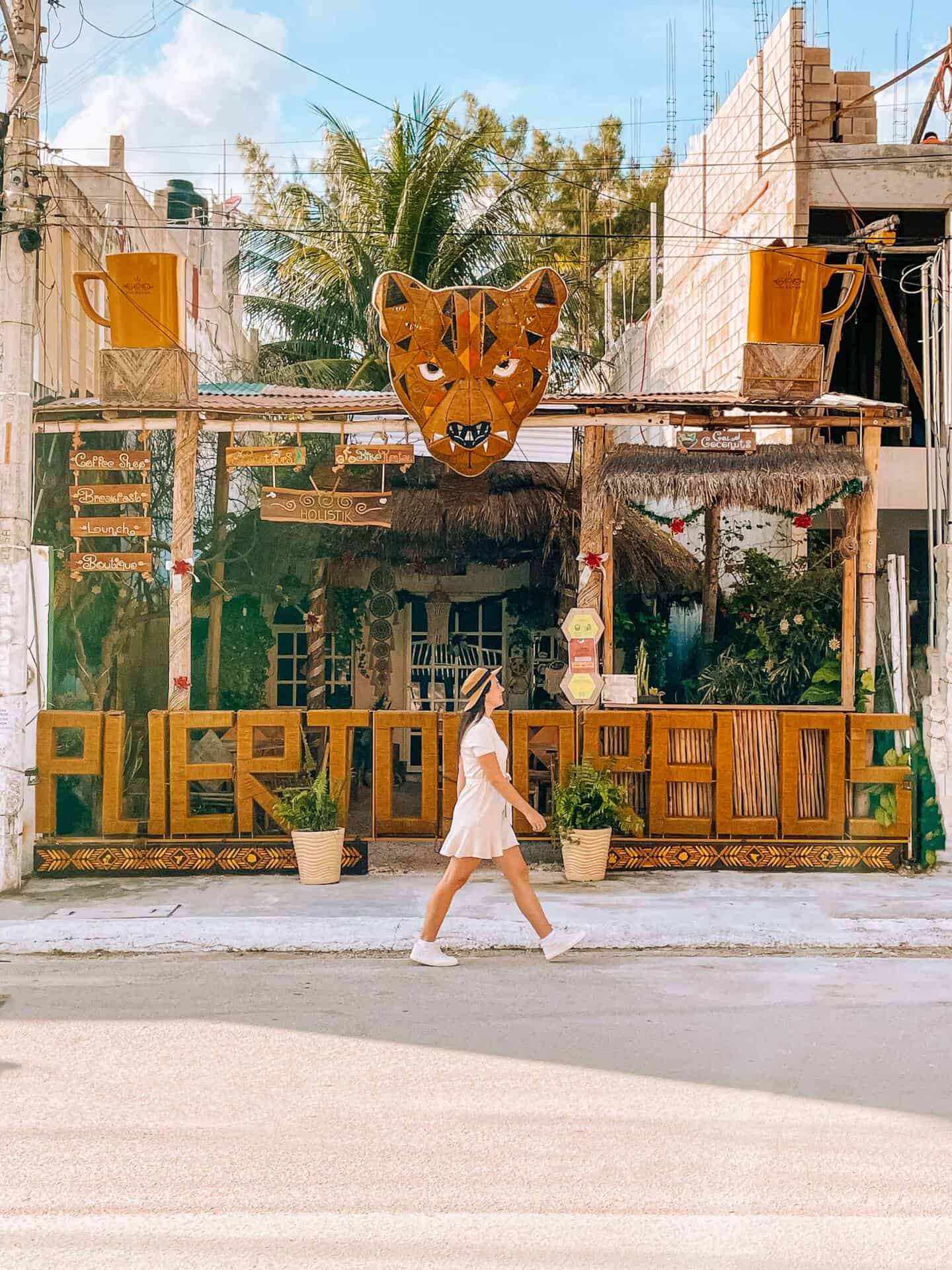
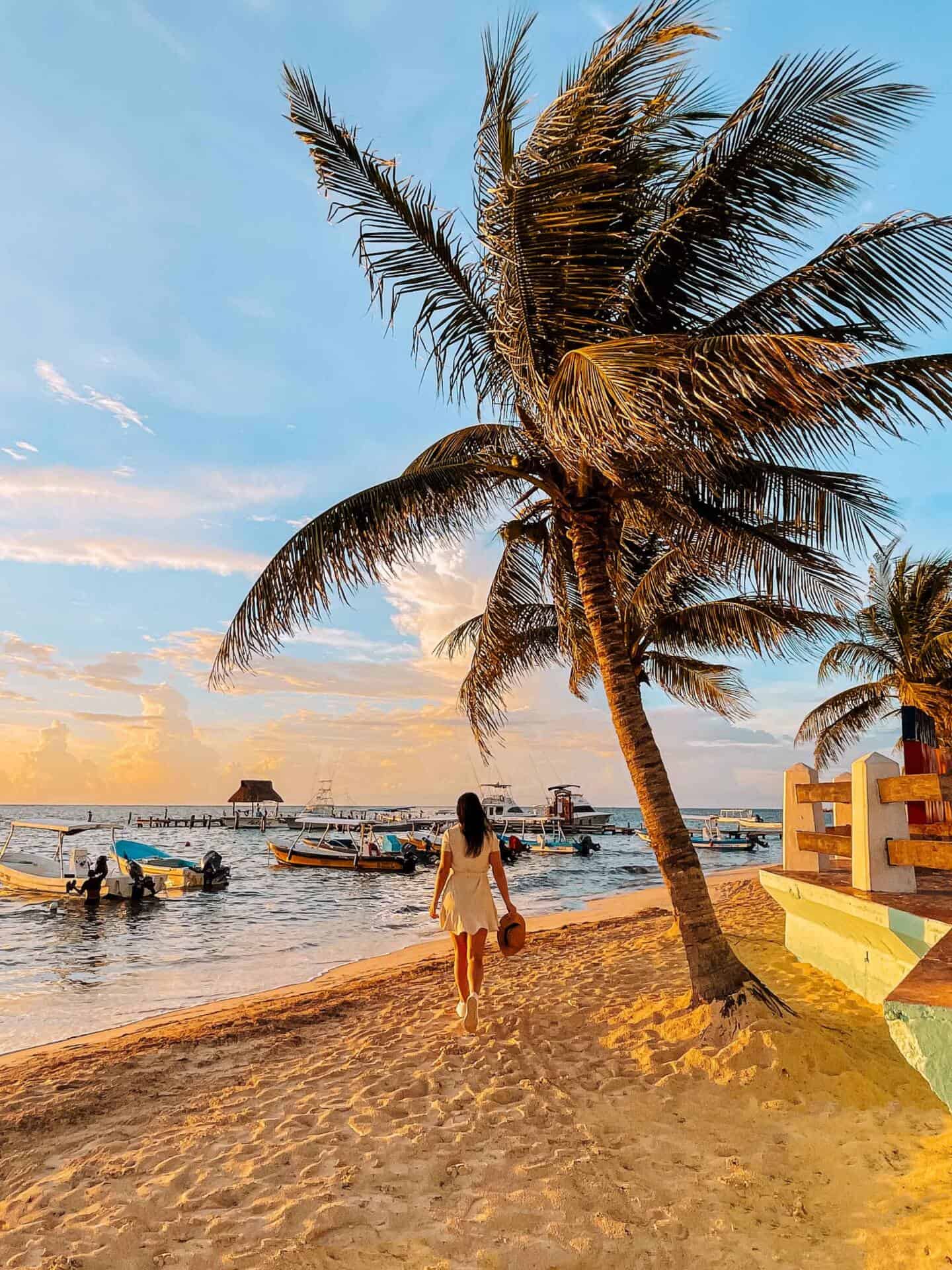
The town’s laid-back atmosphere (it really is a small town still untouched by the tourist crowds), combined with its local restaurants, artisan shops, and cultural attractions, is truly a stark contrast to the crowded vibes of Tulum.
We actually spent three whole days in Puerto Morelos. If possible, I recommend waking up early and watching the sunrise next to the iconic Leaning Lighthouse in the center of the town. It was magical!
Location: Puerto Morelos
Happy exploring!
We stayed for four weeks in the hustle and bustle of Tulum exploring everything this famous destination had to offer including the mysterious Mayan ruins, secret cenotes in the jungle, tropical beaches, and the rich local food scene.
Besides our stay in Tulum, we also spent a couple of months traveling around the Yucatán Peninsula, including the states of Yucatán and Quintana Roo, and exploring all the corners of this beautiful peninsula.
From white-sand beaches to dark underground cenotes, and ancient pyramids – there’s just so much to see! I hope you enjoy your time there as much as we did and I hope you get some travel inspiration from this blog post for your travels! Happy travels!
PIN FOR LATER!


